Paul van Yperen's Blog, page 10
July 1, 2025
Lea Massari (1933-2025)
On 23 June 2025, Lea Massari (1933) passed away. The Italian actress and singer worked in both Italian and French cinema. She is best remembered for such film classics as Michelangelo Antonioni's L'avventura (1960) as the missing girl Anna, and Louis Malle's Le Souffle au Coeur (1971) as Clara, the mother of a sexually precocious 14-year-old boy.

Italian postcard by Rotalfoto, Milano, no. N. 154.

Italian postcard by Rotalfoto, Milano, no. 694.
A sweet girl in love
Lea Massari was born in 1933 in Rome, in the district of Monteverde Vecchio, as Anna Maria Massatani. She was the daughter of a Roman engineer and also of Umbrian descent on her mother's side.
During her childhood, she lived in Spain, France, and Switzerland. Back in Rome, she enrolled at university and attended architecture courses in the early 1950s. In the meantime, she worked as a model and collaborated with the set and costume designer Piero Gherardi, a family friend, who soon introduced her to the world of cinema.
On the set of the film Proibito / Forbidden (1954), where Gherardi worked, director Mario Monicelli noticed her aristocratic and refined features, underlined by her feline gaze and hoarse voice. He convinced her to play a passionate Sardinian girl, alongside Amedeo Nazzari and Mel Ferrer .
On the occasion of her debut on the big screen, at the age of 21, she assumed a stage name in memory of her fiancé Leo, with whom she was supposed to be married, but who died in a tragic accident a few days before the wedding.
The role of the sweet girl in love was repeated in I sogni nel cassetto / Dreams in a Drawer (Renato Castellani, 1957), where she was dubbed by Adriana Asti.

East-German postcard by VEB Progress Filmverleih Starfoto no. 1101. Photo: Rizzoli Film. Lea Massari in I sogni nel cassetto (Renato Castellani, 1957), in East-Germany titled Träume in der Schublade.
A dreamy young woman who suddenly disappears
In the 1960s, Lea Massari acted in several Italian and French productions, playing increasingly challenging roles, mostly as a middle-class woman. She began to gain international notoriety alongside Gabriele Ferzetti and Monica Vitti in Michelangelo Antonioni's film L'avventura / The Adventure (1960). She played perhaps the most iconic role of the first phase of her career, that of Anna, a dreamy young woman who suddenly disappears during a boating trip in the Mediterranean. L'Avventura was nominated for numerous awards and was awarded the Jury Prize at the 1960 Cannes Film Festival.
In the same period, she was in the cast of other important films such as La giornata balorda / From a Roman Balcony (Mauro Bolognini, 1960), Il colosso di Rodi / The Colossus of Rhodes (Sergio Leone, 1960) alongside Rory Calhoun , and especially Una vita difficile / A Difficult Life (Dino Risi,1961) opposite Alberto Sordi and Franco Fabrizi .
Although uncredited, she is notable in Le quattro giornate di Napoli/The Four Days of Naples (Nanni Loy, 1962), based on a subject by Vasco Pratolini, followed by participation in another war-themed film, La città prigioniera/The Captive City (Joseph Anthony, 1962) with David Niven , Ben Gazzara , and Martin Balsam.
In that period, she received a special David di Donatello award for her performance in I sogni muoiono all'alba / Dreams Die at Dawn (Mario Craveri, Enrico Gras, 1961). The film is set during the Hungarian Revolution of 1956 and is based on a play by Indro Montanelli.
In 1963, she was proposed for the role of Marcello Mastroianni's wife in 8½ by Federico Fellini , later assigned to Anouk Aimée. It seems that during the audition for this part, the director was not convinced because of inadequate make-up by Gherardi. In the same year she starred with Francisco Rabal in the drama Llanto por un bandido / I cavalieri della vendetta / Weeping for a Bandit (Carlos Saura, 1963).

West-German postcard by Ufa/Film-Foto, Berlin-Tempelhof, no. FK 2251. Photo: Unitalia Film, Roma.
A sensational accusation of corruption of minors
Since the early years of her career, Lea Massari was often paired with well-known French actors, such as Jean Sorel in the aforementioned La giornata balorda (Mauro Bolognini, 1960), Alain Delon in the Film Noir L'insoumis / The Unvanquished (Alain Cavalier, 1964), and La prima notte di quiete (Valerio Zurlini, 1972) for which she won the first of her two Nastri d'argento, and Maurice Ronet in Il giardino delle delizie / The Garden of Delights (1967), a debut film by Silvano Agosti which was heavily censored in Italy.
She also appeared with Jean-Louis Trintignant in La course du lièvre à travers les champs / And Hope to Die (René Clément, 1972), Yves Montand in Le fils / The Son (Pierre Granier-Deferre, 1973), Philippe Leroy in La linea del fiume / The River Line (Aldo Scavarda, 1976) and Jean-Paul Belmondo in Chi dice donna dice donna / Whoever Days Woman Says Woman (Tonino Cervi, 1976). In 1970, she teamed up with Michel Piccoli and Romy Schneider in the controversial Les Choses de la vie / The Things of Life, the first success of director Claude Sautet, for which the Roman actress won the Louis-Delluc award. She would return to work with Piccoli in Le divorcement (Pierre Barouh, 1979).
Much appreciated especially in France, after having dealt with the scabrous theme of incest in Louis Malle's French comedy-drama Le Souffle au Coeur / Murmur of the Heart (1971), where she played probably the most important role of her maturity. It also cost her a sensational accusation in Italy for corruption of minors, which was closed with a full acquittal. The film was screened at the 1971 Cannes Film Festival and was a box office success in France. In the United States, it received positive reviews and a nomination for the Academy Award for Best Original Screenplay. In 1973, she received an Étoile de Cristal as the Best Foreign Actress.
In 1969, she had also starred with Gérard Blain and debutant Teo Teocoli in Gianni Vernuccio's film Paolo e Francesca, released two years later. She appeared in John Frankenheimer's Story of a Love Story (1973), opposite Alan Bates and Dominique Sanda , and Paolo and Vittorio Taviani's historical drama Allonsanfàn (1974), opposite Marcello Mastroianni . In 1975, she was called to participate as a juror at the Cannes Film Festival.
In 1977, she appeared in the film Antonio Gramsci - I giorni del carcere / Antonio Gramsci: The Days of Prison (Lino Del Fra, 1977) with Riccardo Cucciolla. It won the Pardo d'oro at the Locarno Festival. In 1979, she received her second Nastro d'argento for the role of Luisa Levi in Cristo si è fermato a Eboli / Christ Stopped at Eboli (Francesco Rosi, 1978), where she played alongside Gian Maria Volonté, whom she herself considered the best colleague she had ever worked with.

Small Romanian collector card.

Small Romanian collector card.
An actress notoriously disinclined to be a star
Lea Massari has also worked successfully in the theatre, including in William Gibson's 'Due sull'altalena' (Two for the Seesaw) (1960), directed by Arnoldo Foà, and on television, as in Capitan Fracassa / Captain Fracasse (1958), I promessi sposi / The Betrothed (1967), in the role of the Monaca di Monza (the nun of Monza), I fratelli Karamazov / The Brothers Karamazov (1969) and Quaderno proibito / Forbidden notebook (1980).
She was particularly appreciated by audiences and critics was her performance in Anna Karenina (Sandro Bolchi, 1974), which was repeated several times by the RAI. Her last appearance on the small screen was opposite Erland Josephson in Una donna spezzata / A Broken Woman (Marco Leto, 1988), based on the novel 'La femme rompue' by Simone de Beauvoir and scripted by Massari herself.
Passionate about hunting from a young age, following the example and encouragement of her father, she reduced her artistic activity from the early 1980s onward to devote herself decisively to ecological and animal rights campaigns. She appeared again in Giuseppe Bertolucci's film Segreti Segreti / Secrets Secrets (1985) in which she played the painful role of Lina Sastri's suicidal mother.
An actress notoriously disinclined to be a star, shy and reserved, and often forced to live and work abroad partly because of her husband's work, she retired for good in 1990, at the age of 57. After that, she rarely appeared in public and gave few interviews, refusing various invitations to return to the set, such as the one received by Ferzan Özpetek, who wanted her in Cuore sacro / Sacred Heart (2005), in a role then assigned to Lisa Gaston.
Her last film, which had little success, was Viaggio d'amore / Journey of Love (Ottavio Fabbri, 1990), based on a subject by Tonino Guerra, in which she starred alongside Omar Sharif . After retiring from the stage, she moved to Sardinia with her husband, the former Alitalia pilot Carlo Bianchini, whom she had married in 1963. Following a financial crisis, she put her important collection of antique jewellery up for auction in 1994. In addition to her campaigns in defence of animals and against vivisection, which also led her to support various dog pounds, her passion for the guitar and Brazilian music is well known. Lea Massari died on 23 June 2025 at her home in the Parioli district of Rome at the age of 91. She was buried in the Sutri cemetery.

Italian postcard by Rotalfoto, Milano, no. 1066.

East-German postcard by VEB Progress Film-Vertrieb, Berlin, no. 1743, 1962. Lea Massari in La giornata balord a/ A Crazy Day (Mauro Bolognini, 1960).
Sources: Wikipedia (Italian and English) and .

Italian postcard by Rotalfoto, Milano, no. N. 154.

Italian postcard by Rotalfoto, Milano, no. 694.
A sweet girl in love
Lea Massari was born in 1933 in Rome, in the district of Monteverde Vecchio, as Anna Maria Massatani. She was the daughter of a Roman engineer and also of Umbrian descent on her mother's side.
During her childhood, she lived in Spain, France, and Switzerland. Back in Rome, she enrolled at university and attended architecture courses in the early 1950s. In the meantime, she worked as a model and collaborated with the set and costume designer Piero Gherardi, a family friend, who soon introduced her to the world of cinema.
On the set of the film Proibito / Forbidden (1954), where Gherardi worked, director Mario Monicelli noticed her aristocratic and refined features, underlined by her feline gaze and hoarse voice. He convinced her to play a passionate Sardinian girl, alongside Amedeo Nazzari and Mel Ferrer .
On the occasion of her debut on the big screen, at the age of 21, she assumed a stage name in memory of her fiancé Leo, with whom she was supposed to be married, but who died in a tragic accident a few days before the wedding.
The role of the sweet girl in love was repeated in I sogni nel cassetto / Dreams in a Drawer (Renato Castellani, 1957), where she was dubbed by Adriana Asti.

East-German postcard by VEB Progress Filmverleih Starfoto no. 1101. Photo: Rizzoli Film. Lea Massari in I sogni nel cassetto (Renato Castellani, 1957), in East-Germany titled Träume in der Schublade.
A dreamy young woman who suddenly disappears
In the 1960s, Lea Massari acted in several Italian and French productions, playing increasingly challenging roles, mostly as a middle-class woman. She began to gain international notoriety alongside Gabriele Ferzetti and Monica Vitti in Michelangelo Antonioni's film L'avventura / The Adventure (1960). She played perhaps the most iconic role of the first phase of her career, that of Anna, a dreamy young woman who suddenly disappears during a boating trip in the Mediterranean. L'Avventura was nominated for numerous awards and was awarded the Jury Prize at the 1960 Cannes Film Festival.
In the same period, she was in the cast of other important films such as La giornata balorda / From a Roman Balcony (Mauro Bolognini, 1960), Il colosso di Rodi / The Colossus of Rhodes (Sergio Leone, 1960) alongside Rory Calhoun , and especially Una vita difficile / A Difficult Life (Dino Risi,1961) opposite Alberto Sordi and Franco Fabrizi .
Although uncredited, she is notable in Le quattro giornate di Napoli/The Four Days of Naples (Nanni Loy, 1962), based on a subject by Vasco Pratolini, followed by participation in another war-themed film, La città prigioniera/The Captive City (Joseph Anthony, 1962) with David Niven , Ben Gazzara , and Martin Balsam.
In that period, she received a special David di Donatello award for her performance in I sogni muoiono all'alba / Dreams Die at Dawn (Mario Craveri, Enrico Gras, 1961). The film is set during the Hungarian Revolution of 1956 and is based on a play by Indro Montanelli.
In 1963, she was proposed for the role of Marcello Mastroianni's wife in 8½ by Federico Fellini , later assigned to Anouk Aimée. It seems that during the audition for this part, the director was not convinced because of inadequate make-up by Gherardi. In the same year she starred with Francisco Rabal in the drama Llanto por un bandido / I cavalieri della vendetta / Weeping for a Bandit (Carlos Saura, 1963).

West-German postcard by Ufa/Film-Foto, Berlin-Tempelhof, no. FK 2251. Photo: Unitalia Film, Roma.
A sensational accusation of corruption of minors
Since the early years of her career, Lea Massari was often paired with well-known French actors, such as Jean Sorel in the aforementioned La giornata balorda (Mauro Bolognini, 1960), Alain Delon in the Film Noir L'insoumis / The Unvanquished (Alain Cavalier, 1964), and La prima notte di quiete (Valerio Zurlini, 1972) for which she won the first of her two Nastri d'argento, and Maurice Ronet in Il giardino delle delizie / The Garden of Delights (1967), a debut film by Silvano Agosti which was heavily censored in Italy.
She also appeared with Jean-Louis Trintignant in La course du lièvre à travers les champs / And Hope to Die (René Clément, 1972), Yves Montand in Le fils / The Son (Pierre Granier-Deferre, 1973), Philippe Leroy in La linea del fiume / The River Line (Aldo Scavarda, 1976) and Jean-Paul Belmondo in Chi dice donna dice donna / Whoever Days Woman Says Woman (Tonino Cervi, 1976). In 1970, she teamed up with Michel Piccoli and Romy Schneider in the controversial Les Choses de la vie / The Things of Life, the first success of director Claude Sautet, for which the Roman actress won the Louis-Delluc award. She would return to work with Piccoli in Le divorcement (Pierre Barouh, 1979).
Much appreciated especially in France, after having dealt with the scabrous theme of incest in Louis Malle's French comedy-drama Le Souffle au Coeur / Murmur of the Heart (1971), where she played probably the most important role of her maturity. It also cost her a sensational accusation in Italy for corruption of minors, which was closed with a full acquittal. The film was screened at the 1971 Cannes Film Festival and was a box office success in France. In the United States, it received positive reviews and a nomination for the Academy Award for Best Original Screenplay. In 1973, she received an Étoile de Cristal as the Best Foreign Actress.
In 1969, she had also starred with Gérard Blain and debutant Teo Teocoli in Gianni Vernuccio's film Paolo e Francesca, released two years later. She appeared in John Frankenheimer's Story of a Love Story (1973), opposite Alan Bates and Dominique Sanda , and Paolo and Vittorio Taviani's historical drama Allonsanfàn (1974), opposite Marcello Mastroianni . In 1975, she was called to participate as a juror at the Cannes Film Festival.
In 1977, she appeared in the film Antonio Gramsci - I giorni del carcere / Antonio Gramsci: The Days of Prison (Lino Del Fra, 1977) with Riccardo Cucciolla. It won the Pardo d'oro at the Locarno Festival. In 1979, she received her second Nastro d'argento for the role of Luisa Levi in Cristo si è fermato a Eboli / Christ Stopped at Eboli (Francesco Rosi, 1978), where she played alongside Gian Maria Volonté, whom she herself considered the best colleague she had ever worked with.

Small Romanian collector card.

Small Romanian collector card.
An actress notoriously disinclined to be a star
Lea Massari has also worked successfully in the theatre, including in William Gibson's 'Due sull'altalena' (Two for the Seesaw) (1960), directed by Arnoldo Foà, and on television, as in Capitan Fracassa / Captain Fracasse (1958), I promessi sposi / The Betrothed (1967), in the role of the Monaca di Monza (the nun of Monza), I fratelli Karamazov / The Brothers Karamazov (1969) and Quaderno proibito / Forbidden notebook (1980).
She was particularly appreciated by audiences and critics was her performance in Anna Karenina (Sandro Bolchi, 1974), which was repeated several times by the RAI. Her last appearance on the small screen was opposite Erland Josephson in Una donna spezzata / A Broken Woman (Marco Leto, 1988), based on the novel 'La femme rompue' by Simone de Beauvoir and scripted by Massari herself.
Passionate about hunting from a young age, following the example and encouragement of her father, she reduced her artistic activity from the early 1980s onward to devote herself decisively to ecological and animal rights campaigns. She appeared again in Giuseppe Bertolucci's film Segreti Segreti / Secrets Secrets (1985) in which she played the painful role of Lina Sastri's suicidal mother.
An actress notoriously disinclined to be a star, shy and reserved, and often forced to live and work abroad partly because of her husband's work, she retired for good in 1990, at the age of 57. After that, she rarely appeared in public and gave few interviews, refusing various invitations to return to the set, such as the one received by Ferzan Özpetek, who wanted her in Cuore sacro / Sacred Heart (2005), in a role then assigned to Lisa Gaston.
Her last film, which had little success, was Viaggio d'amore / Journey of Love (Ottavio Fabbri, 1990), based on a subject by Tonino Guerra, in which she starred alongside Omar Sharif . After retiring from the stage, she moved to Sardinia with her husband, the former Alitalia pilot Carlo Bianchini, whom she had married in 1963. Following a financial crisis, she put her important collection of antique jewellery up for auction in 1994. In addition to her campaigns in defence of animals and against vivisection, which also led her to support various dog pounds, her passion for the guitar and Brazilian music is well known. Lea Massari died on 23 June 2025 at her home in the Parioli district of Rome at the age of 91. She was buried in the Sutri cemetery.

Italian postcard by Rotalfoto, Milano, no. 1066.

East-German postcard by VEB Progress Film-Vertrieb, Berlin, no. 1743, 1962. Lea Massari in La giornata balord a/ A Crazy Day (Mauro Bolognini, 1960).
Sources: Wikipedia (Italian and English) and .
Published on July 01, 2025 22:00
June 29, 2025
Paula Raymond
Paula Raymond (1924-2003) was an American model and actress who played the leading lady in numerous films and television series. In 1950, she was put under contract by MGM, where she acted opposite leading men such as Cary Grant and Dick Powell. She is probably best remembered for one of the first atomic monster movies, The Beast From 20,000 Fathoms (1953). In the late 1950s and early 1960s, she appeared in countless episodes of TV series.
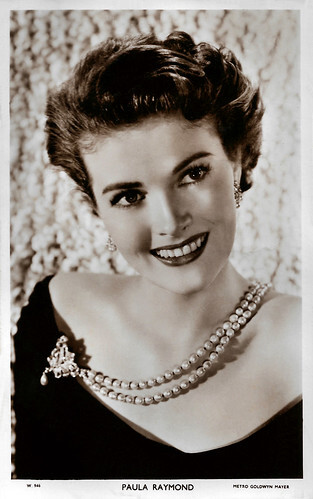
British postcard in the Picturegoer Series, London, no. W 946. Photo: Metro Goldwyn Mayer.
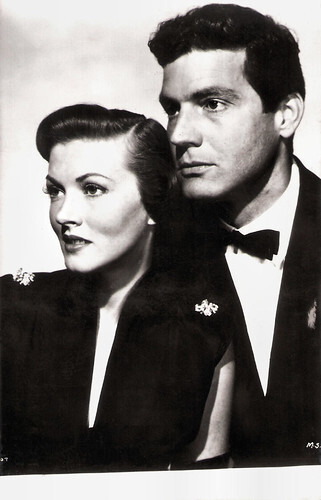
Spanish postcard. Paula Raymond and Paul Hubschmid as Paul Christian in The Beast From 20,000 Fathoms (Eugène Lourié, 1953).
B Film Noirs at Columbia
Paula Raymond was born Paula Ramona Wright in 1924 in San Francisco, California. Her father was a corporate lawyer. She was the niece of Farnsworth Wright, the editor of pulp magazine 'Weird Tales'. After her parents divorced, Raymond and her mother moved to Los Angeles. As a child, Raymond studied ballet, piano, and singing. She was a member of both the San Francisco Opera Company and the San Francisco Children's Opera Company.
By chance, she made her film debut at age 14 during a visit to Los Angeles. She was credited as Paula Rae Wright in the comedy Keep Smiling (Herbert I. Leeds, 1938), starring Jane Withers . Four years later, she graduated from Hollywood High School in 1942. Following graduation, she returned to San Francisco to attend college to study pre-law. Her attorney father wanted his only child to follow in his footsteps.
She also worked with two theatre groups there. Before she became an actress, Raymond was a photographer's model. Her work included posing for the cover of True Confessions magazine. In 1944, she gave up her acting ambitions when she hastily married Marine Captain Floyd Patterson, while he was on leave from the war in the Pacific.
Two years later, they divorced and, to support her young daughter Raeme, Raymond returned to Hollywood to take bit parts under the name of Rae Patterson. Although contracted to Paramount in 1947, she was released without working there. She appeared in films like the musical comedy Variety Girl (George Marshall, 1947) starring Mary Hatcher.
In 1947, she was signed by Columbia, where, as Paula Raymond, she spent two years appearing in B-movies, including the Film Noir Night Has a Thousand Eyes (John Farrow, 1948), starring Edward G. Robinson , and several Westerns such as Challenge Of The Range (Ray Nazarro, 1949), starring Charles Starrett. She was discovered by George Cukor when she played a guest role on the early TV drama The Million Pound Bank Note (1949). Cukor gave her a minor role in the Spencer Tracy / Katharine Hepburn vehicle Adam's Rib (George Cukor, 1949).
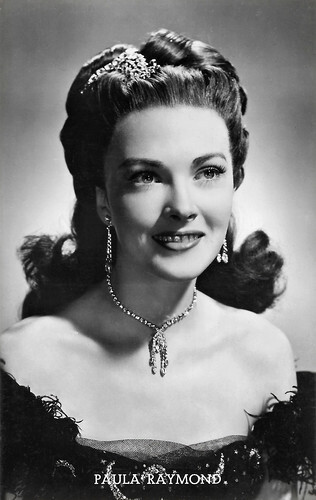
Vintage postcard, no. 731. Photo: M.G.M.
One of the first atomic monster movies
In 1950, Paula Raymond was put under contract by MGM, where she played opposite Cary Grant in the drama Crisis (Richard Brooks, 1950), and with Robert Taylor in the Western Devil's Doorway (Anthony Mann, 1950).
Ronald Bergan in his obituary of Raymond in The Guardian: "It looked as though Raymond, a striking brunette, might break into real stardom. Certainly in the former, the first feature by Richard Brooks, she is delightfully cool as she accompanies her brain surgeon husband (Grant) to a South American country, where the dictator ( José Ferrer ) needs an operation. Caught up in a revolution, the couple want to return to New York, where the chic Raymond would rather do some shopping."
After leaving MGM, Raymond appeared in the film for which she is probably best remembered, one of the first atomic monster movies, The Beast From 20,000 Fathoms (Eugène Lourié, 1953) with Paul Christian aka Paul Hubschmid . In this Science-Fiction cult classic, she appeared as a palaeontologist who links several sea and beach disasters to a prehistoric creature on the loose as a result of an atomic test. She provided a little glamour and romance in a picture where the actors were secondary to Ray Harryhausen's special effects.
Raymond acted in Film Noirs such as City That Never Sleeps (John H. Auer, 1953) with Gig Young, Mala Powers and Marie Windsor. In 1954, she starred as Queen Berengaria in King Richard and the Crusaders (David Butler, 1954), starring Rex Harrison. She also starred in the Western The Gun That Won the West (William Castle, 1955).
Raymond also did some work for Paramount Pictures using the screen name Rae Patterson. By 1955, she had become a 'has-been' by Hollywood standards and Raymond left the industry and worked in several jobs under a variation of her married name. But in 1958, she returned to acting and became part of the television renaissance. In the late 1950s, Raymond appeared in such television shows as Perry Mason (1959-1964, five episodes), Hawaiian Eye (1959-1962, five episodes), M Squad (1958-1960, three episodes) with Lee Marvin , 77 Sunset Strip (1959-1964, four episodes), Peter Gunn (1958) and The Life and Legend of Wyatt Earp (1959).
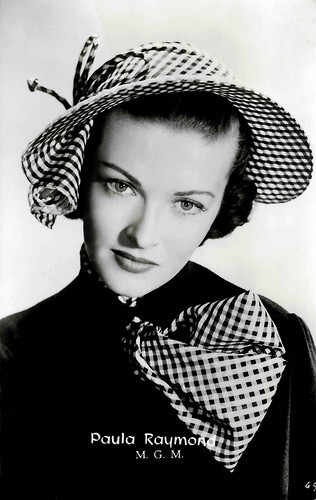
Vintage card. Photo: M.G.M.
A car crash on Sunset Boulevard
During the early 1960s, Paula Raymond played opposite Jack Kelly in an episode from the Western comedy television series Maverick (1961), and opposite Clint Eastwood in an episode of Rawhide (1962).
In 1962, Raymond was driven by her friend, Gloria Beutel in a car on Sunset Boulevard, when Gloria lost control of the car and crashed into a tree. The car overturned several times, and Raymond was pulled just before it exploded. Raymond's nose was severed by the rearview mirror and had to be reconstructed by a plastic surgeon. After a little more than a year of extensive plastic surgery and recovery, she returned to acting.
Raymond was cast in episodes of series like The Man from U.N.C.L.E. (1964) and Death Valley Days (1964). In the cinema, she could be seen in the low-budget Horror film Blood of Dracula's Castle (Al Adamson, 1967), and the lurid Western Five Bloody Graves (Al Adamson, 1969), where she was the madame of a travelling brothel.
In 1977, after retiring for some years, she got a role in the daytime soap opera, Days Of Our Lives. After only three appearances, she accidentally tripped on a telephone cord and broke her ankle. She was written out of the show. She moved into business interests, though remaining an actor at heart. Her final film appearance was in the straight-to-video erotic thriller Mind Twister (Fred Olen Ray, 1994) with Telly Savalas.
In 1944, Raymond had married Floyd Leroy Patterson. In 1946, they divorced shortly after the birth of their daughter, Raeme Dorene Patterson. In 1965, she married aircraft executive Harry Leslie Williams, who was 20 years her elder. They divorced a year later. In 1993, Raymond's daughter died. Paula Raymond passed away in 2003, at Cedars-Sinai Medical Center in Los Angeles from a series of respiratory ailments. She was 79 and survived by a granddaughter. Raymond is interred at Holy Cross Cemetery in Culver City, California. In 1999 she started working on her autobiography 'I Was Born Right, Where Did I Go Wrong or The Misadventures of a Dumb Dame' but she died before it was finished.
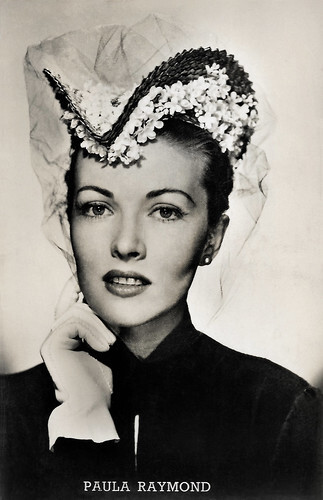
Vintage postcard, no. 631. Photo: Metro Goldwyn Mayer.
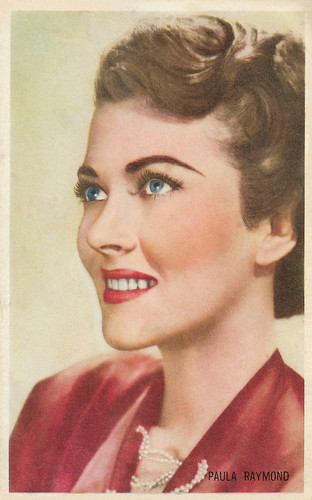
Belgian collectors card by Kwatta, no. C. 315. Photo: MGM. Publicity still for Duchess of Idaho (Robert Z. Leonard, 1950).
Sources: Ronald Bergan (The Guardian), (IMDb), Glamour Girls of the Silver Screen, Wikipedia and

British postcard in the Picturegoer Series, London, no. W 946. Photo: Metro Goldwyn Mayer.

Spanish postcard. Paula Raymond and Paul Hubschmid as Paul Christian in The Beast From 20,000 Fathoms (Eugène Lourié, 1953).
B Film Noirs at Columbia
Paula Raymond was born Paula Ramona Wright in 1924 in San Francisco, California. Her father was a corporate lawyer. She was the niece of Farnsworth Wright, the editor of pulp magazine 'Weird Tales'. After her parents divorced, Raymond and her mother moved to Los Angeles. As a child, Raymond studied ballet, piano, and singing. She was a member of both the San Francisco Opera Company and the San Francisco Children's Opera Company.
By chance, she made her film debut at age 14 during a visit to Los Angeles. She was credited as Paula Rae Wright in the comedy Keep Smiling (Herbert I. Leeds, 1938), starring Jane Withers . Four years later, she graduated from Hollywood High School in 1942. Following graduation, she returned to San Francisco to attend college to study pre-law. Her attorney father wanted his only child to follow in his footsteps.
She also worked with two theatre groups there. Before she became an actress, Raymond was a photographer's model. Her work included posing for the cover of True Confessions magazine. In 1944, she gave up her acting ambitions when she hastily married Marine Captain Floyd Patterson, while he was on leave from the war in the Pacific.
Two years later, they divorced and, to support her young daughter Raeme, Raymond returned to Hollywood to take bit parts under the name of Rae Patterson. Although contracted to Paramount in 1947, she was released without working there. She appeared in films like the musical comedy Variety Girl (George Marshall, 1947) starring Mary Hatcher.
In 1947, she was signed by Columbia, where, as Paula Raymond, she spent two years appearing in B-movies, including the Film Noir Night Has a Thousand Eyes (John Farrow, 1948), starring Edward G. Robinson , and several Westerns such as Challenge Of The Range (Ray Nazarro, 1949), starring Charles Starrett. She was discovered by George Cukor when she played a guest role on the early TV drama The Million Pound Bank Note (1949). Cukor gave her a minor role in the Spencer Tracy / Katharine Hepburn vehicle Adam's Rib (George Cukor, 1949).

Vintage postcard, no. 731. Photo: M.G.M.
One of the first atomic monster movies
In 1950, Paula Raymond was put under contract by MGM, where she played opposite Cary Grant in the drama Crisis (Richard Brooks, 1950), and with Robert Taylor in the Western Devil's Doorway (Anthony Mann, 1950).
Ronald Bergan in his obituary of Raymond in The Guardian: "It looked as though Raymond, a striking brunette, might break into real stardom. Certainly in the former, the first feature by Richard Brooks, she is delightfully cool as she accompanies her brain surgeon husband (Grant) to a South American country, where the dictator ( José Ferrer ) needs an operation. Caught up in a revolution, the couple want to return to New York, where the chic Raymond would rather do some shopping."
After leaving MGM, Raymond appeared in the film for which she is probably best remembered, one of the first atomic monster movies, The Beast From 20,000 Fathoms (Eugène Lourié, 1953) with Paul Christian aka Paul Hubschmid . In this Science-Fiction cult classic, she appeared as a palaeontologist who links several sea and beach disasters to a prehistoric creature on the loose as a result of an atomic test. She provided a little glamour and romance in a picture where the actors were secondary to Ray Harryhausen's special effects.
Raymond acted in Film Noirs such as City That Never Sleeps (John H. Auer, 1953) with Gig Young, Mala Powers and Marie Windsor. In 1954, she starred as Queen Berengaria in King Richard and the Crusaders (David Butler, 1954), starring Rex Harrison. She also starred in the Western The Gun That Won the West (William Castle, 1955).
Raymond also did some work for Paramount Pictures using the screen name Rae Patterson. By 1955, she had become a 'has-been' by Hollywood standards and Raymond left the industry and worked in several jobs under a variation of her married name. But in 1958, she returned to acting and became part of the television renaissance. In the late 1950s, Raymond appeared in such television shows as Perry Mason (1959-1964, five episodes), Hawaiian Eye (1959-1962, five episodes), M Squad (1958-1960, three episodes) with Lee Marvin , 77 Sunset Strip (1959-1964, four episodes), Peter Gunn (1958) and The Life and Legend of Wyatt Earp (1959).

Vintage card. Photo: M.G.M.
A car crash on Sunset Boulevard
During the early 1960s, Paula Raymond played opposite Jack Kelly in an episode from the Western comedy television series Maverick (1961), and opposite Clint Eastwood in an episode of Rawhide (1962).
In 1962, Raymond was driven by her friend, Gloria Beutel in a car on Sunset Boulevard, when Gloria lost control of the car and crashed into a tree. The car overturned several times, and Raymond was pulled just before it exploded. Raymond's nose was severed by the rearview mirror and had to be reconstructed by a plastic surgeon. After a little more than a year of extensive plastic surgery and recovery, she returned to acting.
Raymond was cast in episodes of series like The Man from U.N.C.L.E. (1964) and Death Valley Days (1964). In the cinema, she could be seen in the low-budget Horror film Blood of Dracula's Castle (Al Adamson, 1967), and the lurid Western Five Bloody Graves (Al Adamson, 1969), where she was the madame of a travelling brothel.
In 1977, after retiring for some years, she got a role in the daytime soap opera, Days Of Our Lives. After only three appearances, she accidentally tripped on a telephone cord and broke her ankle. She was written out of the show. She moved into business interests, though remaining an actor at heart. Her final film appearance was in the straight-to-video erotic thriller Mind Twister (Fred Olen Ray, 1994) with Telly Savalas.
In 1944, Raymond had married Floyd Leroy Patterson. In 1946, they divorced shortly after the birth of their daughter, Raeme Dorene Patterson. In 1965, she married aircraft executive Harry Leslie Williams, who was 20 years her elder. They divorced a year later. In 1993, Raymond's daughter died. Paula Raymond passed away in 2003, at Cedars-Sinai Medical Center in Los Angeles from a series of respiratory ailments. She was 79 and survived by a granddaughter. Raymond is interred at Holy Cross Cemetery in Culver City, California. In 1999 she started working on her autobiography 'I Was Born Right, Where Did I Go Wrong or The Misadventures of a Dumb Dame' but she died before it was finished.

Vintage postcard, no. 631. Photo: Metro Goldwyn Mayer.

Belgian collectors card by Kwatta, no. C. 315. Photo: MGM. Publicity still for Duchess of Idaho (Robert Z. Leonard, 1950).
Sources: Ronald Bergan (The Guardian), (IMDb), Glamour Girls of the Silver Screen, Wikipedia and
Published on June 29, 2025 22:00
June 28, 2025
Recovered and Restored: La Pantomima della morte (1917)
We're following the world’s premier festival dedicated to cinematic masterpieces, timeless classics, and hidden gems: Il Cinema Ritrovato 2025 in Bologna. As every edition, the programme includes such strands as Documents and Documentaries, Cinemalibero, 1905, Il Cinema Ritrovato Kids and Young, and Recovered and Restored. One of the recovered and restored films is the Italian silent drama La pantomima della morte / The pantomime of death (1915), starring Leda Gys and Mario Bonnard. Director Mario Caserini adapted a script by Amleto Palermi for his own company, Films Caserini. Cinematography was by Angelo Scalenghe. The film was discovered and restored in the silent film collection of the Eye Filmmuseum in Amsterdam.
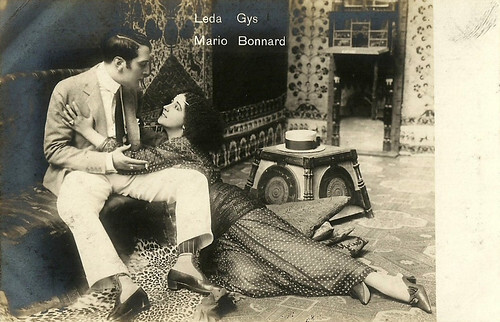
Italian postcard by Ed. A. Traldi, Milano. Photo: Films Caserini. Leda Gys and Mario Bonnard in La pantomima della morte / The pantomime of death (Mario Caserini, 1915).
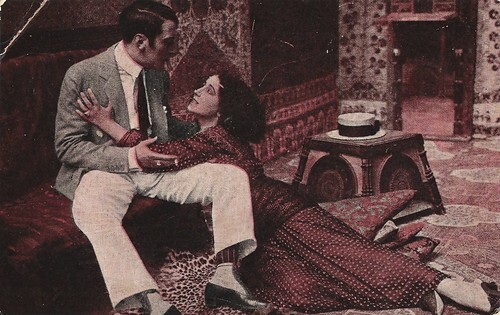
Spanish collector card by Edics. y Publics. de Arte L. Planas, Barcelona, no. 5. Leda Gys and Mario Bonnard in La pantomima della morte / The Pantomime of Death (Mario Caserini, 1915). The Spanish release title was La pantomima de la muerte.
The last show of the famous Amazon of the Circus Continental
The Marchioness Servent (Maria Caserini-Gasperini) has two sons, the man of the world and globetrotter Roberto (Mario Bonnard) and Gualtiero (Gian Paolo Rosmino), who has always lived with his mother.
To finish his studies, Gualtiero moves to Rome, where he meets Sarah ( Leda Gys ), the famous amazon of the Circus Continental. He falls in love with her.
Roberto is sent by his mother to fetch Gualtiero. In Rome, he casually meets Sarah and spends an evening with her, not knowing that the woman is his brother's lover. Gualtiero surprises them and makes a scene. Their mother convinces Gualtiero to leave the city with her.
Roberto, who has stayed in Rome, begins to see Sarah. He also falls in love with her and goes on tour with the circus. Yet, Sarah is soon bored with him and forgets him in the arms of a new conquest. Roberto duels with the new lover but is seriously wounded. Sarah visits him in the hospital with a 'court' of admirers. Roberto, trying to get up, reopens the wound and bleeds to death.
At the Circus Continental, the last show of Sarah's Pantomime of Death takes place. In the act, Sarah is shot with a blank by an assistant during a beast hunt. The shot that goes off is not a blank, and Sarah doesn't rise anymore. Gualtiero has replaced the assistant and killed her for real. The circus audience does not realise the tragedy that has unfolded before their eye and applauds frantically.
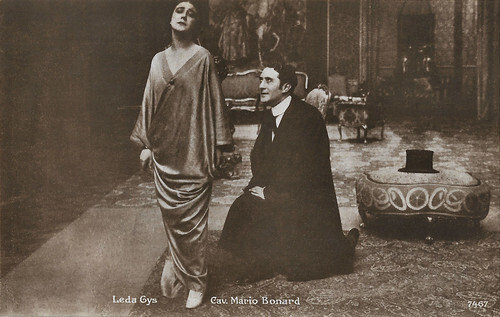
French postcard, no. 7467. Leda Gys and Mario Bonnard in La pantomima della morte / The pantomime of death (Mario Caserini, 1915).
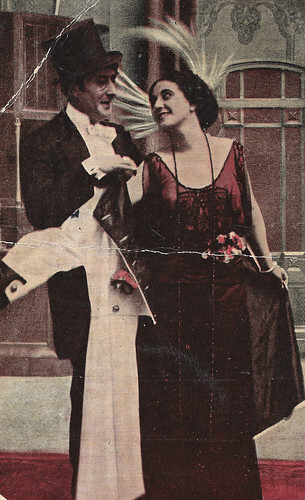
Spanish collector card by Edics. y Publics. de Arte L. Planas, Barcelona, no. 1. Leda Gys and Mario Bonnard in La pantomima della morte / The Pantomime of Death (Mario Caserini, 1915). The Spanish release title was La pantomima de la muerte.
Burned by the flame of sensuality
La pantomima della morte / The pantomime of death (1915) was praised by the critic Guêpe in the Neapolitan film journal La Cine-Fono in 1916.
Guêpe also hads some critical comments: "With just the fascination of her beauty, without any of those terrible dramatic switches in which a vulgar adventuress changes into a person of tragedy, Sarah destroys the two young men and the beautiful lives of the marquis of Servent, bringing them only death and destruction, while she is burned by the flame of sensuality with which she imprisons the other two.
It is the destiny of these rather fantasy-like women to die by the hand of those whom they have transformed into their own instruments of lust."
The critic thought Bonnard and Gys, even if well performing, could have done better, but at the same time admits that this conforms to the taste of the audience, which otherwise would be deluded. What starts as a real artwork thus becomes popular drama, in which the close-ups are all for the wonderful shapes of the protagonist, Leda Gys .
Leda Gys (1892-1957) starred in ca. 60 dramas, comedies, action thrillers and even Westerns of the Italian and Spanish silent cinema. Her claim to fame came with the film Christus (1916), shot in Egypt and Palestine, where Gys performed the Madonna. Mario Bonnard, a.k.a. Mario Bonard (1889-1965) was an Italian actor and director, whose rich career spanned from 1909 to the early 1960s.
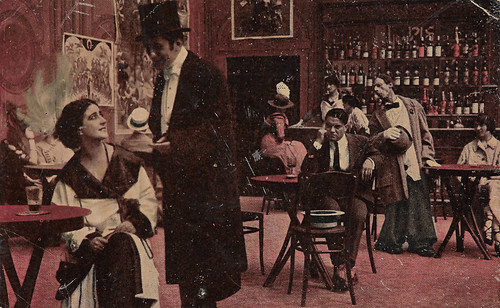
Spanish collector card by Edics. y Publics. de Arte L. Planas, Barcelona, no. 2. Leda Gys and Mario Bonnard in La pantomima della morte / The Pantomime of Death (Mario Caserini, 1915). The Spanish release title was La pantomima de la muerte.
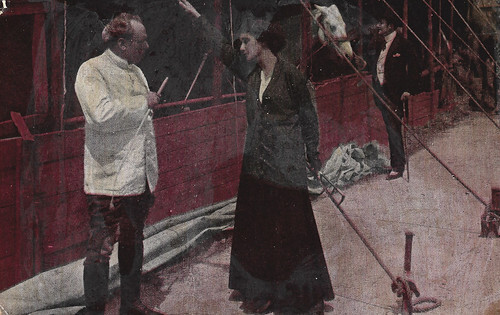
Spanish collector card by Edics. y Publics. de Arte L. Planas, Barcelona, no. 3. Leda Gys in La pantomima della morte / The Pantomime of Death (Mario Caserini, 1915). The Spanish release title was La pantomima de la muerte.
Sources: Vittorio Martinelli (Il cinema muto italiano, Vol. 1917, II - Italian) Wikipedia (Italian and IMDb. With thanks to Elif Rongen-Kaynakci.

Italian postcard by Ed. A. Traldi, Milano. Photo: Films Caserini. Leda Gys and Mario Bonnard in La pantomima della morte / The pantomime of death (Mario Caserini, 1915).

Spanish collector card by Edics. y Publics. de Arte L. Planas, Barcelona, no. 5. Leda Gys and Mario Bonnard in La pantomima della morte / The Pantomime of Death (Mario Caserini, 1915). The Spanish release title was La pantomima de la muerte.
The last show of the famous Amazon of the Circus Continental
The Marchioness Servent (Maria Caserini-Gasperini) has two sons, the man of the world and globetrotter Roberto (Mario Bonnard) and Gualtiero (Gian Paolo Rosmino), who has always lived with his mother.
To finish his studies, Gualtiero moves to Rome, where he meets Sarah ( Leda Gys ), the famous amazon of the Circus Continental. He falls in love with her.
Roberto is sent by his mother to fetch Gualtiero. In Rome, he casually meets Sarah and spends an evening with her, not knowing that the woman is his brother's lover. Gualtiero surprises them and makes a scene. Their mother convinces Gualtiero to leave the city with her.
Roberto, who has stayed in Rome, begins to see Sarah. He also falls in love with her and goes on tour with the circus. Yet, Sarah is soon bored with him and forgets him in the arms of a new conquest. Roberto duels with the new lover but is seriously wounded. Sarah visits him in the hospital with a 'court' of admirers. Roberto, trying to get up, reopens the wound and bleeds to death.
At the Circus Continental, the last show of Sarah's Pantomime of Death takes place. In the act, Sarah is shot with a blank by an assistant during a beast hunt. The shot that goes off is not a blank, and Sarah doesn't rise anymore. Gualtiero has replaced the assistant and killed her for real. The circus audience does not realise the tragedy that has unfolded before their eye and applauds frantically.

French postcard, no. 7467. Leda Gys and Mario Bonnard in La pantomima della morte / The pantomime of death (Mario Caserini, 1915).

Spanish collector card by Edics. y Publics. de Arte L. Planas, Barcelona, no. 1. Leda Gys and Mario Bonnard in La pantomima della morte / The Pantomime of Death (Mario Caserini, 1915). The Spanish release title was La pantomima de la muerte.
Burned by the flame of sensuality
La pantomima della morte / The pantomime of death (1915) was praised by the critic Guêpe in the Neapolitan film journal La Cine-Fono in 1916.
Guêpe also hads some critical comments: "With just the fascination of her beauty, without any of those terrible dramatic switches in which a vulgar adventuress changes into a person of tragedy, Sarah destroys the two young men and the beautiful lives of the marquis of Servent, bringing them only death and destruction, while she is burned by the flame of sensuality with which she imprisons the other two.
It is the destiny of these rather fantasy-like women to die by the hand of those whom they have transformed into their own instruments of lust."
The critic thought Bonnard and Gys, even if well performing, could have done better, but at the same time admits that this conforms to the taste of the audience, which otherwise would be deluded. What starts as a real artwork thus becomes popular drama, in which the close-ups are all for the wonderful shapes of the protagonist, Leda Gys .
Leda Gys (1892-1957) starred in ca. 60 dramas, comedies, action thrillers and even Westerns of the Italian and Spanish silent cinema. Her claim to fame came with the film Christus (1916), shot in Egypt and Palestine, where Gys performed the Madonna. Mario Bonnard, a.k.a. Mario Bonard (1889-1965) was an Italian actor and director, whose rich career spanned from 1909 to the early 1960s.

Spanish collector card by Edics. y Publics. de Arte L. Planas, Barcelona, no. 2. Leda Gys and Mario Bonnard in La pantomima della morte / The Pantomime of Death (Mario Caserini, 1915). The Spanish release title was La pantomima de la muerte.

Spanish collector card by Edics. y Publics. de Arte L. Planas, Barcelona, no. 3. Leda Gys in La pantomima della morte / The Pantomime of Death (Mario Caserini, 1915). The Spanish release title was La pantomima de la muerte.
Sources: Vittorio Martinelli (Il cinema muto italiano, Vol. 1917, II - Italian) Wikipedia (Italian and IMDb. With thanks to Elif Rongen-Kaynakci.
Published on June 28, 2025 22:00
June 27, 2025
Axel von Ambesser
In Il Cinema Ritrovato 2025's tribute to Willi Forst, one of the highlights is the musical Frauen sind keine Engel / Women Are No Angels (1943) starring Marte Harell. Her co-star in this film was Axel von Ambesser (1910-1988) who became one of the best-known actors, directors and writers of post-war Germany.
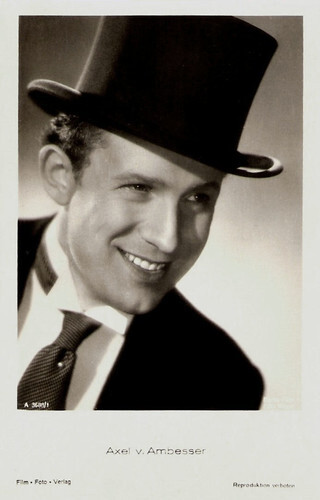
German postcard by Film-Foto-Verlag, no. A 3688/1, 1941-1944. Photo: Wesel / Berlin Film.
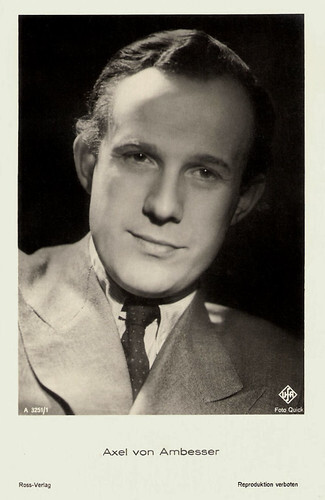
German postcard by Film-Foto-Verlag, no. A 3251/1, 1941-1944. Photo: Quick / Ufa.
Two men with identical names and a shared fate
Axel von Ambesser was born Axel Eugen Alexander von Oesterreich in Hamburg, Germany in 1910. Following the advice of his father, a merchant originally hailing from St. Petersburg, he changed his name to 'Axel von Ambesser'.
Although, not classically trained as an actor, the theatre-crazy Ambesser was given parts at the Hamburger Kammerspiele. He worked from 1930 on as a stage actor in Germany and Austria, often cast as the young hero, charming suitor and comic relief. From 1936 to 1941 he was a company member of the prestigious Deutsche Theater in Berlin.
He made his film debut with a small part in Der Gefangene des Königs/The King's Prisoner (Carl Boese, 1935). In the next years followed successful productions like Salonwagen E 417 / Lounge Car E 417 (Paul Verhoeven, 1939), Das Herz der Königin / The Heart of a Queen (Carl Froelich, 1940) starring Zarah Leander , and Frauen sind keine Engel / Women Are No Angels (Willi Forst, 1943) with Marte Harell .
Das Mädchen Juanita / The Girl Juanita (Wolfgang Staudte, 1945) could not be finished because of the end of World War II. It was edited with material from the archives and released in West Germany in 1952. In 1944 Wolfgang Staudte shot another film with Von Ambesser called Der Mann, dem man den Namen stahl / The Man Whose Name Was Stolen. This satire was finished, but didn't pass the censorship and parts of it seemed to be lost in the war.
After the war, Staudte once again undertook to film the story. As he used Von Ambesser again, it is believed that parts of the 1944 film were used, and other sequences were re-shot three years later. Die seltsamen Abenteuer des Herrn Fridolin B. / The Adventures of Fridolin was finally released in March 1948. It is a witty dry comedy about two men with identical names, who for some strange reason have been listed by the official bureaucracy as one. So they obviously have to share each other's fate to some extent. According to Filmportal.de , Der Mann, dem man den Namen stahl / The Man Whose Name Was Stolen has been rediscovered, almost 70 years after the film was made.
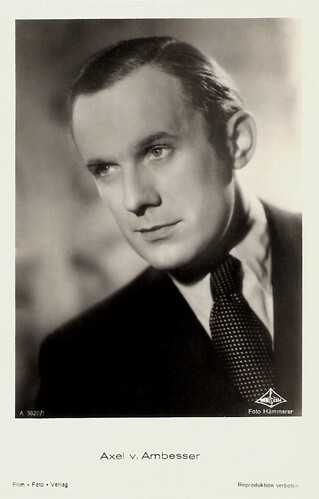
German postcard by Film-Foto-Verlag, no. A 3820/1, 1941-1944. Photo: Foto Hämmerer / Wien Film.
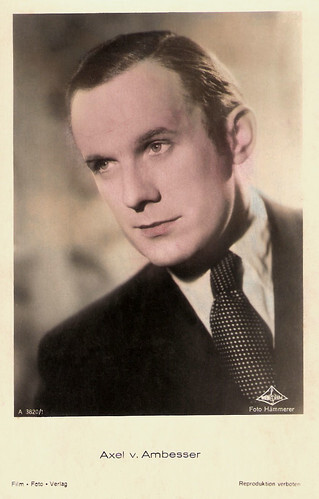
German postcard by Film-Foto-Verlag, no. A 3820/1, 1941-1944. Photo: Foto Hämmerer / Wien Film.
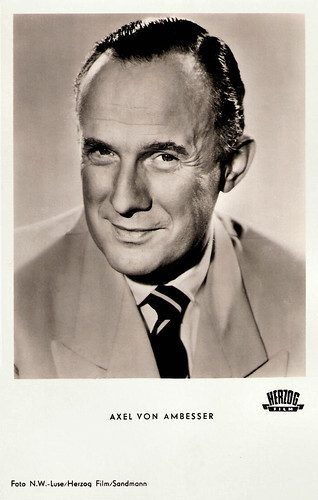
German postcard by Kunst und Bild, Berlin, no. 874. Photo: N.W.-luse / Herzog-Film / Sandmann. Axel von Ambesser in Drei, von denen man spricht / Three of which we speak (Axel von Ambesser, 1953).
The German voice of Charlie Chaplin
After the war, Axel von Ambesser was an ensemble member at the Münchner Kammerspiele before he became a freelancing actor in the late 1940s. He also started writing and directing, and in some cases, he directed himself as the lead of his own plays.
In the cinema, he acted in Tanzende Sterne / Dancing Stars (Géza von Cziffra, 1952) and Gustav Adolfs Page / Gustav Adolph's Page (Rolf Hansen, 1960), or was a commentator in Kommen Sie am Ersten / Come on First (Erich Engel, 1951) and Es muss nicht immer Kaviar sein / Operation Caviar (Géza von Radványi, 1961) starring O.W. Fischer .
His voice was the ‘German voice’ of Charlie Chaplin in Monsieur Verdoux (Charles Chaplin, 1947). Von Ambesser also wrote the German translation for this film. In the 1950s he often worked as a writer for stage, cabaret, film and television and was even the ‘most played of the living authors of the German language’. In 1953, he made his debut as a film director with the comedy Drei, von denen man spricht / Three of Which We Speak. He directed hits like Der Pauker / The Crammer (1958) and Der brave Soldat Schwejk / The Good Soldier Schweik (1960) based on the novel by Jaroslav Hašek, both starring Heinz Rühmann .
Schwejk won a Golden Globe for Best Foreign Film. Other popular films were his Der Gauner und der liebe Gott / The Crook and the Cross (1960) starring Gert Fröbe , Kohlhiesels Töchter / Kohlhiesel's Daughters (1962) starring Liselotte Pulver and the Father-Brown-detective Er kanns nicht lassen / He Can't Stop (1962) again starring Heinz Rühmann . His last work for the cinema was Die fromme Helene / The Pious Helene (1965), for which he worked as a director, writer as well as an actor. From the mid-1960s on, he worked for television.
In the early 1980s, Axel von Ambesser mostly retired from TV but continued to work in the theatre. In 1985, he published his memoirs, and was awarded the Filmband in Gold, for his 'continued outstanding individual contributions to the German film over the years'. Axel von Ambesser died in 1988. He was married to actress Inge von Oesterreich-Ambesser from 1935 till his death. His daughter Gwendolyn von Ambesser works like her father both as a director, author and actress.
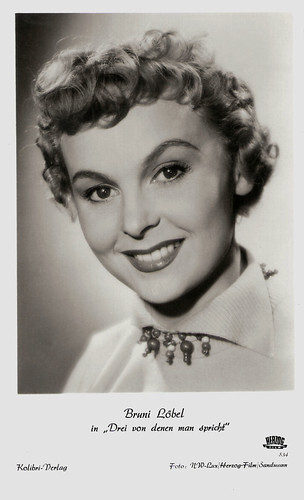
West German postcard by Kolibri-Verlag, no. 834. Photo: Neue Wiener Filmproduktion / Lux Film / Herzog Film / Lothar Sandmann. Bruni Löbel in Drei, von denen man spricht / Three To Talk About (Axel von Ambesser, 1953).
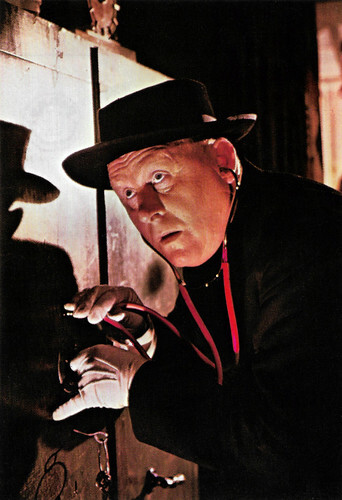
German collector card in the Unsere Bambi-Lieblinge Series by Penny-Bildbände, no. 41. Photo: Gert Fröbe in Der Gauner und der Lieber Gott / The Crook and the Cross (Axel von Ambesser, 1960).
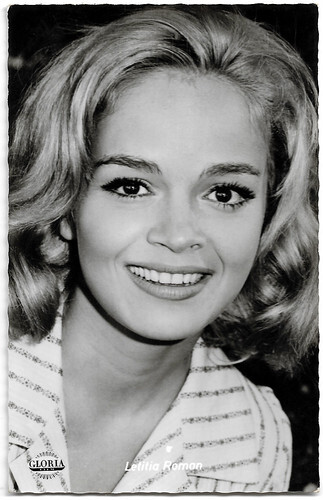
German postcard by Kolibri, no. 2264. Photo: Sascha Film / Gloria Film / Gruber. Letícia Román in Heirate mich, Chérie / Marry Me, Cherie (Axel von Ambesser, 1964).
Sources: Thomas Staedeli (Cyranos), Wikipedia (German), Filmportal.de and .

German postcard by Film-Foto-Verlag, no. A 3688/1, 1941-1944. Photo: Wesel / Berlin Film.

German postcard by Film-Foto-Verlag, no. A 3251/1, 1941-1944. Photo: Quick / Ufa.
Two men with identical names and a shared fate
Axel von Ambesser was born Axel Eugen Alexander von Oesterreich in Hamburg, Germany in 1910. Following the advice of his father, a merchant originally hailing from St. Petersburg, he changed his name to 'Axel von Ambesser'.
Although, not classically trained as an actor, the theatre-crazy Ambesser was given parts at the Hamburger Kammerspiele. He worked from 1930 on as a stage actor in Germany and Austria, often cast as the young hero, charming suitor and comic relief. From 1936 to 1941 he was a company member of the prestigious Deutsche Theater in Berlin.
He made his film debut with a small part in Der Gefangene des Königs/The King's Prisoner (Carl Boese, 1935). In the next years followed successful productions like Salonwagen E 417 / Lounge Car E 417 (Paul Verhoeven, 1939), Das Herz der Königin / The Heart of a Queen (Carl Froelich, 1940) starring Zarah Leander , and Frauen sind keine Engel / Women Are No Angels (Willi Forst, 1943) with Marte Harell .
Das Mädchen Juanita / The Girl Juanita (Wolfgang Staudte, 1945) could not be finished because of the end of World War II. It was edited with material from the archives and released in West Germany in 1952. In 1944 Wolfgang Staudte shot another film with Von Ambesser called Der Mann, dem man den Namen stahl / The Man Whose Name Was Stolen. This satire was finished, but didn't pass the censorship and parts of it seemed to be lost in the war.
After the war, Staudte once again undertook to film the story. As he used Von Ambesser again, it is believed that parts of the 1944 film were used, and other sequences were re-shot three years later. Die seltsamen Abenteuer des Herrn Fridolin B. / The Adventures of Fridolin was finally released in March 1948. It is a witty dry comedy about two men with identical names, who for some strange reason have been listed by the official bureaucracy as one. So they obviously have to share each other's fate to some extent. According to Filmportal.de , Der Mann, dem man den Namen stahl / The Man Whose Name Was Stolen has been rediscovered, almost 70 years after the film was made.

German postcard by Film-Foto-Verlag, no. A 3820/1, 1941-1944. Photo: Foto Hämmerer / Wien Film.

German postcard by Film-Foto-Verlag, no. A 3820/1, 1941-1944. Photo: Foto Hämmerer / Wien Film.

German postcard by Kunst und Bild, Berlin, no. 874. Photo: N.W.-luse / Herzog-Film / Sandmann. Axel von Ambesser in Drei, von denen man spricht / Three of which we speak (Axel von Ambesser, 1953).
The German voice of Charlie Chaplin
After the war, Axel von Ambesser was an ensemble member at the Münchner Kammerspiele before he became a freelancing actor in the late 1940s. He also started writing and directing, and in some cases, he directed himself as the lead of his own plays.
In the cinema, he acted in Tanzende Sterne / Dancing Stars (Géza von Cziffra, 1952) and Gustav Adolfs Page / Gustav Adolph's Page (Rolf Hansen, 1960), or was a commentator in Kommen Sie am Ersten / Come on First (Erich Engel, 1951) and Es muss nicht immer Kaviar sein / Operation Caviar (Géza von Radványi, 1961) starring O.W. Fischer .
His voice was the ‘German voice’ of Charlie Chaplin in Monsieur Verdoux (Charles Chaplin, 1947). Von Ambesser also wrote the German translation for this film. In the 1950s he often worked as a writer for stage, cabaret, film and television and was even the ‘most played of the living authors of the German language’. In 1953, he made his debut as a film director with the comedy Drei, von denen man spricht / Three of Which We Speak. He directed hits like Der Pauker / The Crammer (1958) and Der brave Soldat Schwejk / The Good Soldier Schweik (1960) based on the novel by Jaroslav Hašek, both starring Heinz Rühmann .
Schwejk won a Golden Globe for Best Foreign Film. Other popular films were his Der Gauner und der liebe Gott / The Crook and the Cross (1960) starring Gert Fröbe , Kohlhiesels Töchter / Kohlhiesel's Daughters (1962) starring Liselotte Pulver and the Father-Brown-detective Er kanns nicht lassen / He Can't Stop (1962) again starring Heinz Rühmann . His last work for the cinema was Die fromme Helene / The Pious Helene (1965), for which he worked as a director, writer as well as an actor. From the mid-1960s on, he worked for television.
In the early 1980s, Axel von Ambesser mostly retired from TV but continued to work in the theatre. In 1985, he published his memoirs, and was awarded the Filmband in Gold, for his 'continued outstanding individual contributions to the German film over the years'. Axel von Ambesser died in 1988. He was married to actress Inge von Oesterreich-Ambesser from 1935 till his death. His daughter Gwendolyn von Ambesser works like her father both as a director, author and actress.

West German postcard by Kolibri-Verlag, no. 834. Photo: Neue Wiener Filmproduktion / Lux Film / Herzog Film / Lothar Sandmann. Bruni Löbel in Drei, von denen man spricht / Three To Talk About (Axel von Ambesser, 1953).

German collector card in the Unsere Bambi-Lieblinge Series by Penny-Bildbände, no. 41. Photo: Gert Fröbe in Der Gauner und der Lieber Gott / The Crook and the Cross (Axel von Ambesser, 1960).

German postcard by Kolibri, no. 2264. Photo: Sascha Film / Gloria Film / Gruber. Letícia Román in Heirate mich, Chérie / Marry Me, Cherie (Axel von Ambesser, 1964).
Sources: Thomas Staedeli (Cyranos), Wikipedia (German), Filmportal.de and .
Published on June 27, 2025 22:00
June 26, 2025
John Stuart
We're still in Italy and enjoy Il Cinema Ritrovato (21 June-29 June 2025). In the section One Hundred Years Ago: 1925, Alfred Hitchcock's debut film will be showcased in the programme. The sensational The Pleasure Garden (1925) tells the story of two chorus girls at the Pleasure Garden Theatre in London and their troubled relationships. Glamorous American star Virginia Valli played the lead. The male star was the Scottish actor John Stuart (1898-1979), a very popular leading man in British silent films in the 1920s.
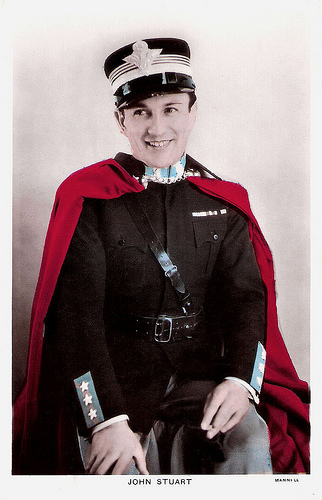
British postcard in the Colourgraph Series, London, no. C. 237. Photo: Mannell.
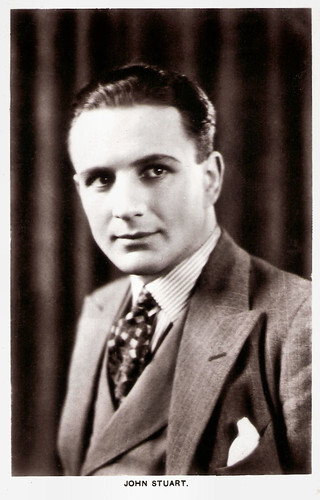
British postcard in the Picturegoer Series, London, no. 54b.
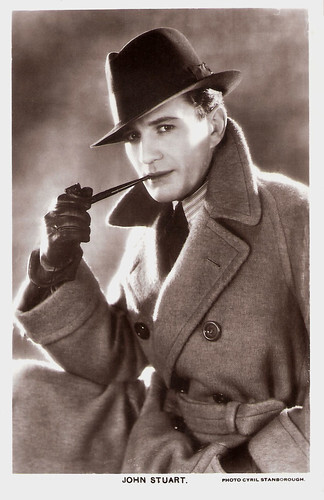
British postcard in the Picturegoer Series, London, no. 54e.
Instant star
John Stuart was born John Alfred Louden Croall in Edinburgh, Scotland in 1898. He began his stage and screen career directly after World War I service in 'The Black Watch'. He made his film debut in the drama The Lights of Home (Fred Paul, 1920).
Other silent films were the drama If Four Walls Told (Fred Paul, 1922) starring Lillian Hall-Davis , the comedy The School for Scandal (Bertram Phillips, 1923) with Queenie Thomas , and the comedy We Women (W.P. Kellino, 1925).
Stuart was a very popular leading man in British silent films, though it's hard to gauge that popularity since many of his best films of the 1920s, such as A Sporting Double (Arthur Rooke, 1923), Constant Hot Water (George A. Cooper, 1924) and The Tower of London (Maurice Elvey, 1926) with Isobel Elsom , are either inaccessible or non-existent.
He appeared in a silent film directed by Alfred Hitchcock . The Pleasure Garden (1925) was Hitchcock’s directorial debut. Based on a novel by Oliver Sandys, the film is about two chorus girls at the Pleasure Garden Theatre in London and their troubled relationships. Glamorous American star Virginia Valli played the lead. The film was shot in Italy and Germany in 1925 and shown to the British press in March 1926. But it was not officially released in the UK until 1927, after Hitchcock's film The Lodger: A Story of the London Fog became a massive hit in February 1927.
Stuart worked several times with director Maurice Elvey. Very popular was their World War I drama Mademoiselle from Armentieres (Maurice Elvey, 1926), featuring Estelle Brody. The film opened in London in September 1926 and was still playing in cinemas around the country until well into 1927. It was reportedly the most profitable British film of 1926 and made an instant star of Brody. The two stars were reunited in the drama Hindle Wakes (Maurice Elvey, 1927), which skilful use of location is considered to give the film a documentary realism feel very unusual in British films of the period. Brody and Stuart co-starred again in Mademoiselle Parley Voo (Maurice Elvey, 1928), a sequel to Mademoiselle from Armentieres, and equally successful. Both films refer to the popular First World War song Mademoiselle from Armentières.
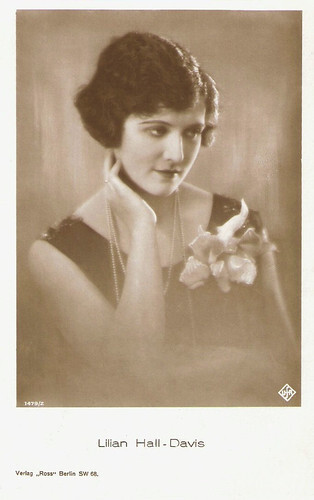
Lillian Hall-Davis German postcard by Ross Verlag, Berlin, no. 1479/2, 1927-1928. Photo: Ufa.
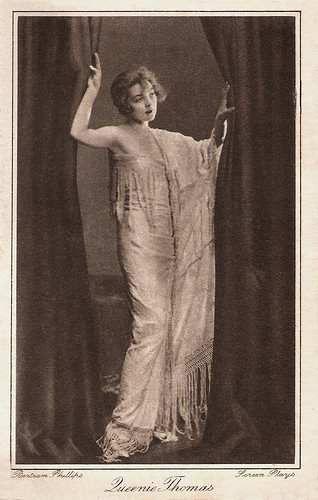
Queenie Thomas . British postcard in the series Screen Plays. Photo: Bertram Phillips.
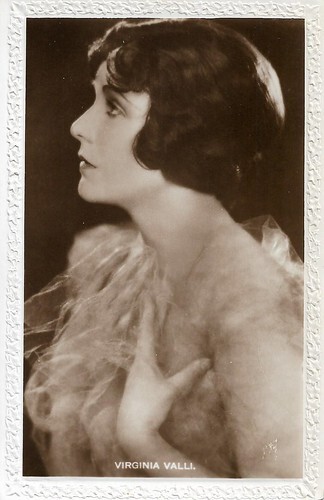
Virginia Valli. British postcard. The frame is similar to those of Beagles and Lilywhite. The name is scratched away but this could be a photo by Autrey.
Number seventeen
John Stuart’s first sound film, Kitty (Victor Saville, 1929) was another successful production. Kitty was initially planned and filmed as a silent, but on its original completion director Saville decided to reshoot the latter part with sound. As no suitable facilities were yet available in Britain, Saville, Estelle Brody and Stuart travelled to New York to shoot the new sequences at RKO Studios. The film was released in the form of a silent which switched to sound after the halfway point.
Stuart’s next film, Atlantic (1929) was one of the first British films made with the soundtrack optically recorded on the film (sound-on-film). Atlantic was directed and produced by Ewald André Dupont. Three versions were made, an English and a German language version, Atlantik, which were shot simultaneously, and later a French version was made. In England, Atlantic was released in both sound and silent prints. The film was originally made as Titanic but after lawsuits it was renamed Atlantic. The White Star Line, which owned the RMS Titanic, was still in operation at the time. The final scene of the film was filmed as a shot of the liner sinking but it was cut at the last minute as it was feared it would upset Titanic survivors.
Then Stuart worked for a second time with Alfred Hitchcock , although indirectly. Elstree Calling (1930) is a lavish musical film revue directed by Andre Charlot, Jack Hulbert , Paul Murray, and Hitchcock at Elstree Studios. It was Britain's answer to the Hollywood revues, such as Paramount on Parade (Dorothy Arzner et al, 1930) and The Hollywood Review of 1929 (Charles Reisner, 1929). Stuart was not appearing in the segments directed by Hitchcock.
They really worked together again on Number Seventeen (Alfred Hitchcock, 1932), in which Stuart played the lead. The film is about a group of criminals who committed a jewel robbery and put their money in an old house over a railway leading to the English Channel, the film's title being derived from the house's street number. An outsider stumbles onto this plot and intervenes with the help of a neighbour, a police officer's daughter. On its initial release, audiences reacted to Number Seventeen with confusion and disappointment.
Stuart then played Sir Henry Baskerville in the mystery The Hound of the Baskervilles (Gareth Gundrey, 1932), based on the novel by Arthur Conan Doyle and scripted by Edgar Wallace. He was the co-star of Brigitte Helm in The Mistress of Atlantis (Georg Wilhelm Pabst, 1932), the English language version of the German-French adventure and fantasy film L'Atlantide / Die Herrin von Atlantis (Georg Wilhelm Pabst, 1932) based on the novel 'L'Atlantide' by Pierre Benoît.
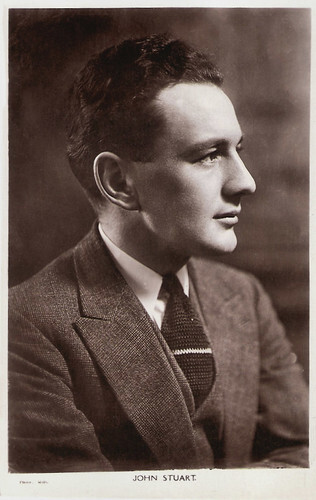
British postcard in the Picturegoer Series, London, no. 54. Photo: Mills.
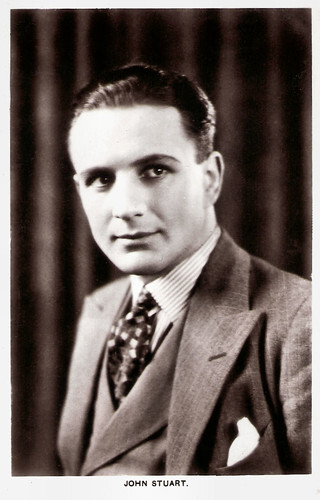
British postcard in the Picturegoer Series, London, no. 54c.
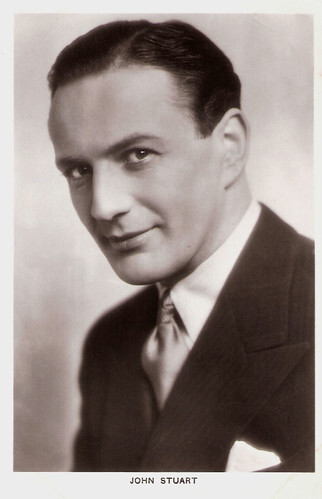
British postcard in the Picturegoer Series, London, no. 54e.
Quota quickie
John Stuart starred with Benita Hume in the drama Men of Steel (George King, 1932). It was made at Nettlefold Studios under the so-called Quota Quickie system for distribution by United Artists. In 1927, The Cinematograph Films Act was designed to stimulate the declining British film industry. It introduced a requirement for British cinemas to show a quota of British films, for 10 years. The result of the act was the 'quota quickie', a low-cost, poor-quality film commissioned by American distributors operating in the UK purely to satisfy the quota requirements.
During the 1930s Stuart appeared in a lot of these films. Memorable are the drama The Lost Chord (Maurice Elvey, 1933) with Elizabeth Allan and Jack Hawkins , the comedy This Week of Grace Chord (Maurice Elvey, 1933) starring Gracie Fields and Henry Kendall, and Anglo-Italian aviation drama The Blue Squadron (George King, 1934) with Esmond Knight.
Stuart co-starred with Fritz Kortner and Nils Asther in Abdul the Damned (Karl Grune, 1935), set in the Ottoman Empire in the years before the First World War where the Sultan and the Young Turks battle for power. He also worked often with director George Pearson, like in the thriller The Secret Voice (1936), and appeared in several parts of the long-running Old Mother Riley series. During the war years, Stuart’s parts became smaller or better said, he matured into character parts.
He played a supporting part in the thriller Headline (John Harlow, 1944) with David Farrar as a crime reporter who searches for a mystery woman ( Anne Crawford ) who has witnessed a murder. Another example is the Gainsborough melodrama Madonna of the Seven Moons (Arthur Crabtree, 1945) starring Phyllis Calvert , Stewart Granger and Patricia Roc . In 1946 readers of the Daily Mail voted the film their third most popular British movie from 1939 to 1945. During the following decades, he played government officials and police inspectors in B-films like the mystery The Ringer (Guy Hamilton, 1952) starring Herbert Lom , and the Science Fiction film Four Sided Triangle (Terence Fisher, 1953).
Memorable are the war film Sink the Bismarck! (Lewis Gilbert, 1960) with Kenneth More, the Science Fiction film Village of the Damned (Wolf Rilla, 1960), and the suspense film Paranoiac (Freddie Francis, 1963) from Hammer Films starring Janette Scott and Oliver Reed . Stuart only played bit roles in these films. His last part was a cameo in Superman (Richard Donner, 1978). In 1979, John Stuart died in London at the age of 81. He is buried in Brompton Cemetery, London. An accomplished writer, John Stuart penned his autobiography, 'Caught in the Act', in 1971. His son, author and journalist Jonathan Croall published 'Forgotten Stars: My Father and the British Silent Film World' (2013) a book about the English screen idols of the 1920s.
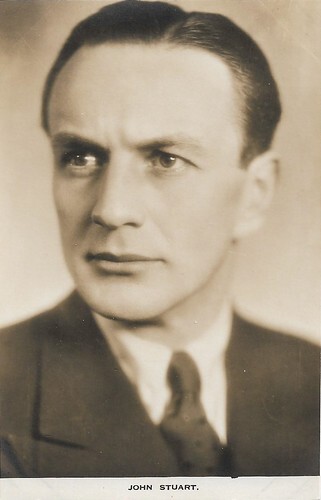
British postcard in the Film Weekly Series, London, no. 2.
Trailer The Pleasure Garden (1925). Source: BFI films (YouTube).
Sources: Hal Erickson (AllMovie - Page now defunct), Wikipedia and .

British postcard in the Colourgraph Series, London, no. C. 237. Photo: Mannell.

British postcard in the Picturegoer Series, London, no. 54b.

British postcard in the Picturegoer Series, London, no. 54e.
Instant star
John Stuart was born John Alfred Louden Croall in Edinburgh, Scotland in 1898. He began his stage and screen career directly after World War I service in 'The Black Watch'. He made his film debut in the drama The Lights of Home (Fred Paul, 1920).
Other silent films were the drama If Four Walls Told (Fred Paul, 1922) starring Lillian Hall-Davis , the comedy The School for Scandal (Bertram Phillips, 1923) with Queenie Thomas , and the comedy We Women (W.P. Kellino, 1925).
Stuart was a very popular leading man in British silent films, though it's hard to gauge that popularity since many of his best films of the 1920s, such as A Sporting Double (Arthur Rooke, 1923), Constant Hot Water (George A. Cooper, 1924) and The Tower of London (Maurice Elvey, 1926) with Isobel Elsom , are either inaccessible or non-existent.
He appeared in a silent film directed by Alfred Hitchcock . The Pleasure Garden (1925) was Hitchcock’s directorial debut. Based on a novel by Oliver Sandys, the film is about two chorus girls at the Pleasure Garden Theatre in London and their troubled relationships. Glamorous American star Virginia Valli played the lead. The film was shot in Italy and Germany in 1925 and shown to the British press in March 1926. But it was not officially released in the UK until 1927, after Hitchcock's film The Lodger: A Story of the London Fog became a massive hit in February 1927.
Stuart worked several times with director Maurice Elvey. Very popular was their World War I drama Mademoiselle from Armentieres (Maurice Elvey, 1926), featuring Estelle Brody. The film opened in London in September 1926 and was still playing in cinemas around the country until well into 1927. It was reportedly the most profitable British film of 1926 and made an instant star of Brody. The two stars were reunited in the drama Hindle Wakes (Maurice Elvey, 1927), which skilful use of location is considered to give the film a documentary realism feel very unusual in British films of the period. Brody and Stuart co-starred again in Mademoiselle Parley Voo (Maurice Elvey, 1928), a sequel to Mademoiselle from Armentieres, and equally successful. Both films refer to the popular First World War song Mademoiselle from Armentières.

Lillian Hall-Davis German postcard by Ross Verlag, Berlin, no. 1479/2, 1927-1928. Photo: Ufa.

Queenie Thomas . British postcard in the series Screen Plays. Photo: Bertram Phillips.

Virginia Valli. British postcard. The frame is similar to those of Beagles and Lilywhite. The name is scratched away but this could be a photo by Autrey.
Number seventeen
John Stuart’s first sound film, Kitty (Victor Saville, 1929) was another successful production. Kitty was initially planned and filmed as a silent, but on its original completion director Saville decided to reshoot the latter part with sound. As no suitable facilities were yet available in Britain, Saville, Estelle Brody and Stuart travelled to New York to shoot the new sequences at RKO Studios. The film was released in the form of a silent which switched to sound after the halfway point.
Stuart’s next film, Atlantic (1929) was one of the first British films made with the soundtrack optically recorded on the film (sound-on-film). Atlantic was directed and produced by Ewald André Dupont. Three versions were made, an English and a German language version, Atlantik, which were shot simultaneously, and later a French version was made. In England, Atlantic was released in both sound and silent prints. The film was originally made as Titanic but after lawsuits it was renamed Atlantic. The White Star Line, which owned the RMS Titanic, was still in operation at the time. The final scene of the film was filmed as a shot of the liner sinking but it was cut at the last minute as it was feared it would upset Titanic survivors.
Then Stuart worked for a second time with Alfred Hitchcock , although indirectly. Elstree Calling (1930) is a lavish musical film revue directed by Andre Charlot, Jack Hulbert , Paul Murray, and Hitchcock at Elstree Studios. It was Britain's answer to the Hollywood revues, such as Paramount on Parade (Dorothy Arzner et al, 1930) and The Hollywood Review of 1929 (Charles Reisner, 1929). Stuart was not appearing in the segments directed by Hitchcock.
They really worked together again on Number Seventeen (Alfred Hitchcock, 1932), in which Stuart played the lead. The film is about a group of criminals who committed a jewel robbery and put their money in an old house over a railway leading to the English Channel, the film's title being derived from the house's street number. An outsider stumbles onto this plot and intervenes with the help of a neighbour, a police officer's daughter. On its initial release, audiences reacted to Number Seventeen with confusion and disappointment.
Stuart then played Sir Henry Baskerville in the mystery The Hound of the Baskervilles (Gareth Gundrey, 1932), based on the novel by Arthur Conan Doyle and scripted by Edgar Wallace. He was the co-star of Brigitte Helm in The Mistress of Atlantis (Georg Wilhelm Pabst, 1932), the English language version of the German-French adventure and fantasy film L'Atlantide / Die Herrin von Atlantis (Georg Wilhelm Pabst, 1932) based on the novel 'L'Atlantide' by Pierre Benoît.

British postcard in the Picturegoer Series, London, no. 54. Photo: Mills.

British postcard in the Picturegoer Series, London, no. 54c.

British postcard in the Picturegoer Series, London, no. 54e.
Quota quickie
John Stuart starred with Benita Hume in the drama Men of Steel (George King, 1932). It was made at Nettlefold Studios under the so-called Quota Quickie system for distribution by United Artists. In 1927, The Cinematograph Films Act was designed to stimulate the declining British film industry. It introduced a requirement for British cinemas to show a quota of British films, for 10 years. The result of the act was the 'quota quickie', a low-cost, poor-quality film commissioned by American distributors operating in the UK purely to satisfy the quota requirements.
During the 1930s Stuart appeared in a lot of these films. Memorable are the drama The Lost Chord (Maurice Elvey, 1933) with Elizabeth Allan and Jack Hawkins , the comedy This Week of Grace Chord (Maurice Elvey, 1933) starring Gracie Fields and Henry Kendall, and Anglo-Italian aviation drama The Blue Squadron (George King, 1934) with Esmond Knight.
Stuart co-starred with Fritz Kortner and Nils Asther in Abdul the Damned (Karl Grune, 1935), set in the Ottoman Empire in the years before the First World War where the Sultan and the Young Turks battle for power. He also worked often with director George Pearson, like in the thriller The Secret Voice (1936), and appeared in several parts of the long-running Old Mother Riley series. During the war years, Stuart’s parts became smaller or better said, he matured into character parts.
He played a supporting part in the thriller Headline (John Harlow, 1944) with David Farrar as a crime reporter who searches for a mystery woman ( Anne Crawford ) who has witnessed a murder. Another example is the Gainsborough melodrama Madonna of the Seven Moons (Arthur Crabtree, 1945) starring Phyllis Calvert , Stewart Granger and Patricia Roc . In 1946 readers of the Daily Mail voted the film their third most popular British movie from 1939 to 1945. During the following decades, he played government officials and police inspectors in B-films like the mystery The Ringer (Guy Hamilton, 1952) starring Herbert Lom , and the Science Fiction film Four Sided Triangle (Terence Fisher, 1953).
Memorable are the war film Sink the Bismarck! (Lewis Gilbert, 1960) with Kenneth More, the Science Fiction film Village of the Damned (Wolf Rilla, 1960), and the suspense film Paranoiac (Freddie Francis, 1963) from Hammer Films starring Janette Scott and Oliver Reed . Stuart only played bit roles in these films. His last part was a cameo in Superman (Richard Donner, 1978). In 1979, John Stuart died in London at the age of 81. He is buried in Brompton Cemetery, London. An accomplished writer, John Stuart penned his autobiography, 'Caught in the Act', in 1971. His son, author and journalist Jonathan Croall published 'Forgotten Stars: My Father and the British Silent Film World' (2013) a book about the English screen idols of the 1920s.

British postcard in the Film Weekly Series, London, no. 2.
Trailer The Pleasure Garden (1925). Source: BFI films (YouTube).
Sources: Hal Erickson (AllMovie - Page now defunct), Wikipedia and .
Published on June 26, 2025 22:00
June 25, 2025
One Hundred Years Ago: 1925
Once again, Il Cinema Ritrovato offers a selection of classics and rarities made or released in 1925, the year that marked the 30th anniversary of the birth of cinema. The year saw the emergence of future big-name auteurs such as Alfred Hitchcock, Jean Renoir, and Josef von Sternberg, whose 1925 debut features will all be showcased in the programme, curated by Oliver Hanley. Alongside undisputed masterpieces such as Sergei Eisenstein’s Strike or Carl Theodor Dreyer’s Master of the House, the programme will feature comparatively lesser-known gems, all with live musical accompaniment. For EFSP, Ivo Blom made a selection of 25 postcards of international films that premiered in 1925.
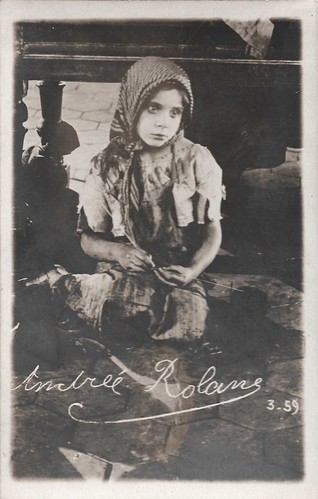
French postcard, no. 3.59. Andrée Rolane as Cosette in Les Misérables (Henri Fescourt, 1925).
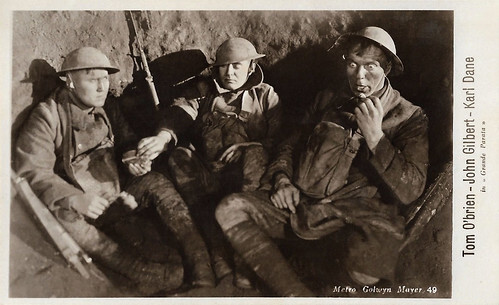
Italian postcard by G.B. Falci, Milano, no. 49. Photo: Ruth Harriet Louise / Metro-Goldwyn-Mayer. Tom O'Brien, John Gilbert, and Karl Dane in The Big Parade (King Vidor, 1925), released in Italy as Grande Parata / La grande parata.
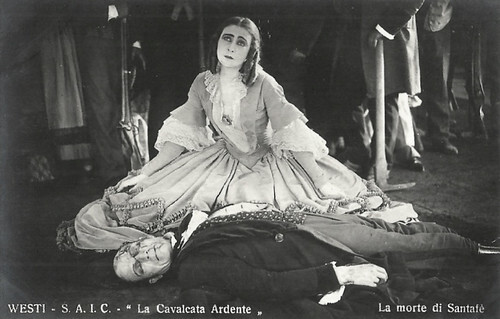
Italian postcard by Ed. A. Traldi, Milano. Photo: Westi. SAIC. Soava Gallone and Emilio Ghione in the Italian historical film La cavalcata ardente / The Fiery Cavalcade (Carmine Gallone 1925).

German postcard with Dutch imprint by Ross Verlag, Berlin, no. 36/10. Photo: Emelka Konzern. Himansu Rai in Prem Sanyas / Die Leuchte Asiens / The Light of Asia (Franz Osten, Himansu Rai, 1925).
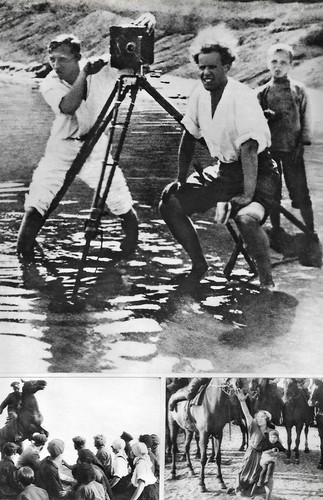
Soviet postcard by Izdatelʹstvo 'Planeta' Fabrika Fotopečati, Moscow, no. 32, 1978. This postcard was printed in an edition of 25.000 cards. The price was 8 kop. Caption: Sergei Eisenstein on the set of Stachka / Strike (Sergei Eisenstein, 1925). Scenes from Stachka / Strike (Sergei Eisenstein, 1925).
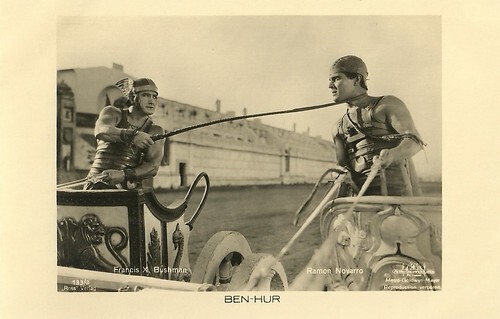
German postcard by Ross Verlag, no. 133/3. Photo: Metro-Goldwyn-Mayer. Messala ( Francis X. Bushman ) and Ben-Hur ( Ramon Novarro ) during the famous chariot race in the American silent film Ben-Hur: A Tale of the Christ (Fred Niblo, 1925). Mark how the tribunes are empty and the upper part of the circus is missing (it was projected into the film using a hanging model).
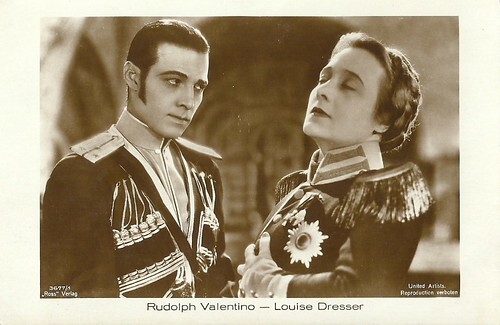
German postcard by Ross Verlag, no. 3677/1, 1928-1929. Photo: United Artists. Rudolph Valentino and Louise Dresser in The Eagle (Clarence Brown, 1925).
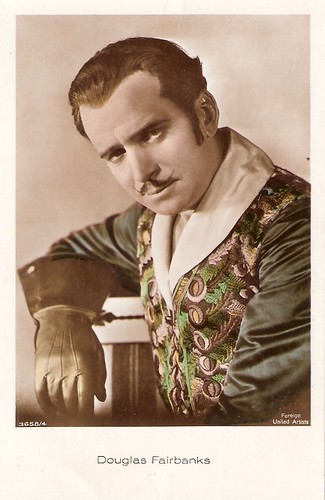
British postcard by Ross Verlag Foreign, no. 3658/4, 1928-1929. Photo: United Artists. Douglas Fairbanks is wearing the outfit from Don Q, Son of Zorro (Donald Crisp, 1925).
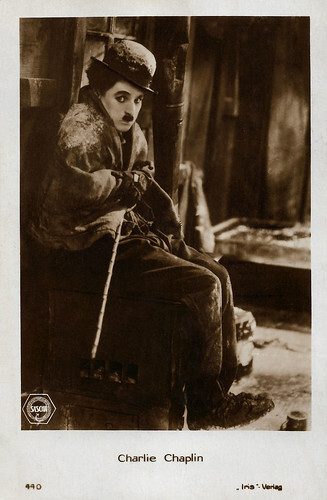
Austrian postcard by Iris Verlag, no. 440. Photo: Sascha. Charlie Chaplin in The Gold Rush (Charles Chaplin, 1925).
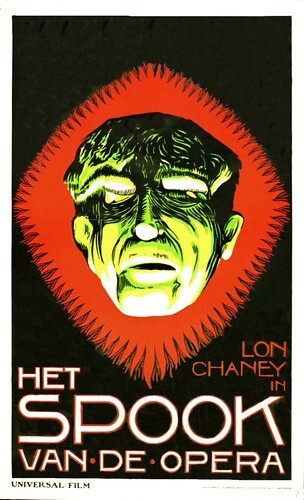
Dutch poster by Frans Bosen for The Phantom of the Opera (Rupert Julian, 1925) with Lon Chaney .
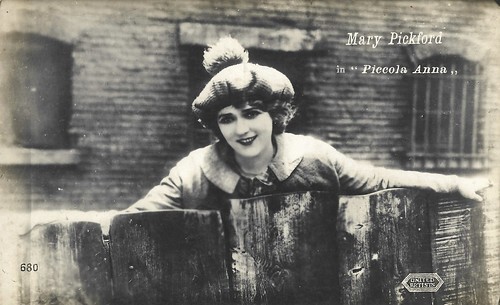
Italian postcard by Ballerini & Fratini, no. 680. Photo: United Artists. Mary Pickford in Little Annie Rooney (William Beaudine, 1925), released in Italy as Piccola Anna.

French postcard in the Les Vedettes de Cinéma Series, by A.N., Paris, no. 369. Mae Murray (the trema is a mistake) and John Gilbert as the romantic couple, Sally O'Hara and Prince Danilo, in The Merry Widow (Erich von Stroheim, 1925). The film was a huge success.
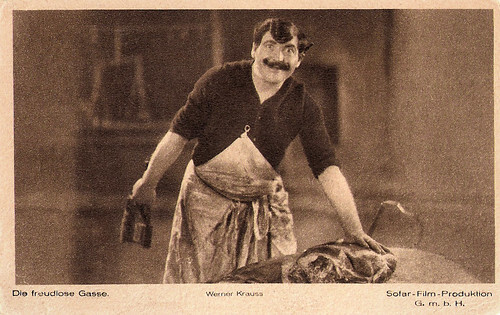
German postcard by Ross Verlag G.m.b.H., Berlin. Photo: Sofar-Film-Produktion. Werner Krauss in Die freudlose Gasse / The Joyless Street (Georg Wilhelm Pabst, 1925).

German postcard by Ross Verlag, no. 25/4. Photo: Ufa. Lil Dagover in Zur Chronik von Grieshuus / The Chronicle of the Gray House (Arthur von Gerlach, 1925).
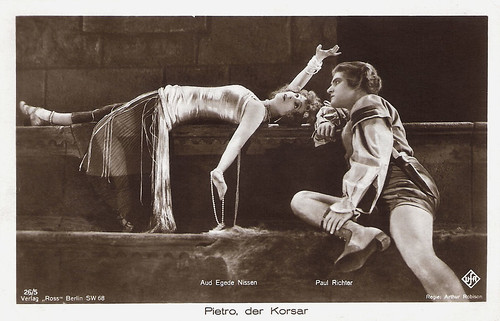
German postcard by Ross Verlag, Berlin, no. 26/5, 1927-1928. Photo: Ufa. Aud Egede Nissen and Paul Richter in Pietro der Korsar / Peter the Pirate (Arthur Robison, 1925).
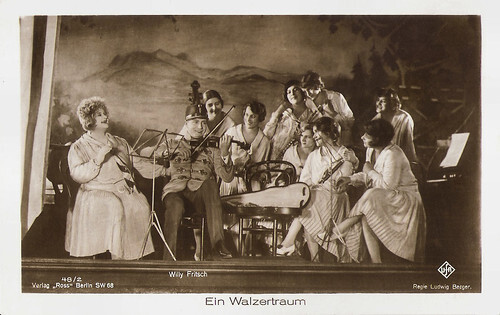
German postcard by Ross Verlag, no. 48/2. Photo: Ufa. Willy Fritsch in the German silent film Ein Walzertraum / The Waltz Dream (Ludwig Berger, 1925), based on the Oscar Straus operetta.
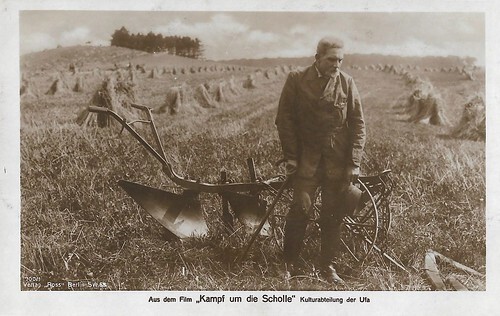
German postcard by Ross Verlag, no. 700/1. Photo: Kulturabteilung der UFA. Publicity still for Kampf um die Scholle / Struggle for the Soil (Erich Waschneck, 1925) here probably with Gustav Oberg as Freiherr von Wulfshagen.
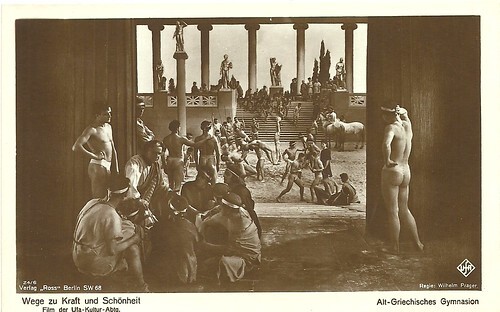
German postcard by Ross Verlag, Berlin, no. 24/9. Photo: Ufa. Publicity still for Wege zu Kraft und Schönheit / Ways to Strength and Beauty (Nicholas Kaufmann, Wilhelm Prager, 1925). Caption: Alt-Griechisches Gymnasion (Old Greek Gymnasium). Collection: Didier Hanson.
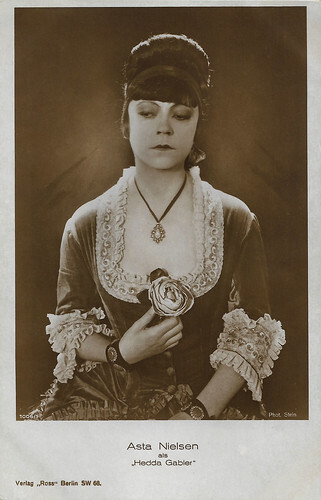
German postcard by Ross Verlag, no. 1006/1, 1927-1928. Photo: Stein. Asta Nielsen in Hedda Gabler (Franz Eckstein, 1925), based on the play by Henrik Ibsen.
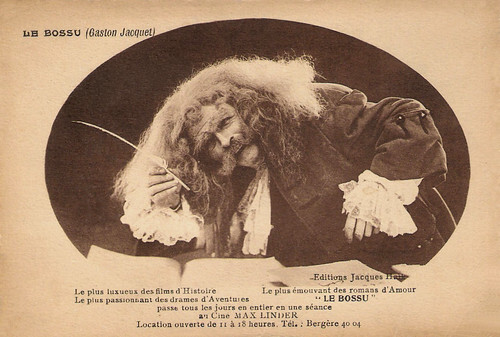
French postcard by Editions Jacques Haïk. Photo Combier Mâcon. Gaston Jacquet in Le Bossu / The Duke's Motto (Jean Kemm, 1925).
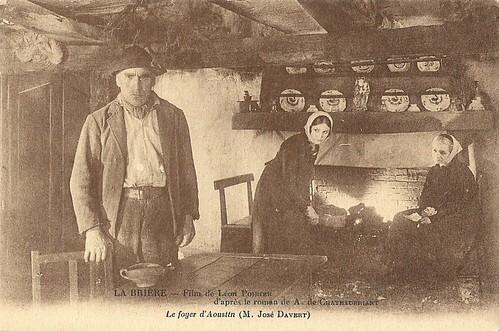
French postcard. Publicity still for the French rural drama La Brière (Léon Poirier, 1924). Caption: The home of Aoustin (José Davert). In the back are his wife (Jeanne Marie-Laurent) and daughter Théotiste (Laurence Myrga).
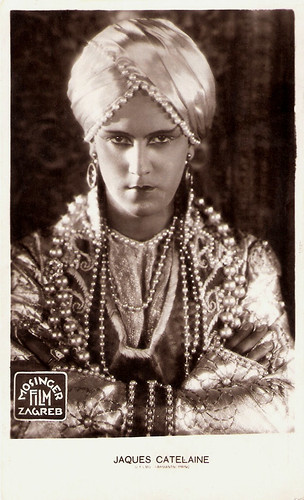
Yugoslav postcard by Jos. Caklovic, Zagreb, no. 75. Photo: Mosinger Film, Zagreb. Jaque Catelain in Le prince charmant / Prince Charming (Viktor Tourjansky, 1925).
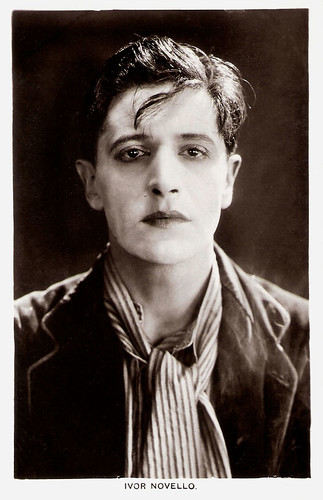
British Postcard in the Picturegoer Series, London, no. 39A. Photo: Ivor Novello in The Rat (Graham Cutts, 1925).
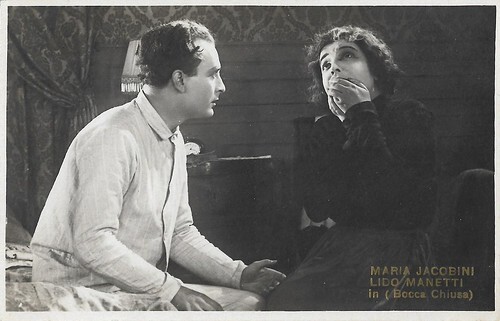
Italian postcard by G.B. Falci, Milano, 397. Photo: SAIC. Lido Manetti and Maria Jacobini in the Italian silent drama La bocca chiusa / The Closed Mouth (Guglielmo Zorzi, 1925).
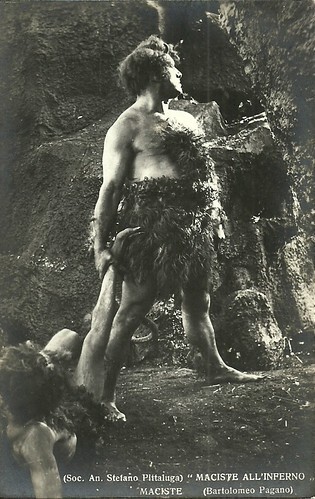
Italian postcard by Ed. A. Traldi, Milano. Photo: Dist. Società Anonima Stefano Pittaluga. Bartolomeo Pagano as Maciste in Maciste all'inferno / Maciste in Hell (Guido Brignone, 1926).

French postcard, no. 3.59. Andrée Rolane as Cosette in Les Misérables (Henri Fescourt, 1925).

Italian postcard by G.B. Falci, Milano, no. 49. Photo: Ruth Harriet Louise / Metro-Goldwyn-Mayer. Tom O'Brien, John Gilbert, and Karl Dane in The Big Parade (King Vidor, 1925), released in Italy as Grande Parata / La grande parata.

Italian postcard by Ed. A. Traldi, Milano. Photo: Westi. SAIC. Soava Gallone and Emilio Ghione in the Italian historical film La cavalcata ardente / The Fiery Cavalcade (Carmine Gallone 1925).

German postcard with Dutch imprint by Ross Verlag, Berlin, no. 36/10. Photo: Emelka Konzern. Himansu Rai in Prem Sanyas / Die Leuchte Asiens / The Light of Asia (Franz Osten, Himansu Rai, 1925).

Soviet postcard by Izdatelʹstvo 'Planeta' Fabrika Fotopečati, Moscow, no. 32, 1978. This postcard was printed in an edition of 25.000 cards. The price was 8 kop. Caption: Sergei Eisenstein on the set of Stachka / Strike (Sergei Eisenstein, 1925). Scenes from Stachka / Strike (Sergei Eisenstein, 1925).

German postcard by Ross Verlag, no. 133/3. Photo: Metro-Goldwyn-Mayer. Messala ( Francis X. Bushman ) and Ben-Hur ( Ramon Novarro ) during the famous chariot race in the American silent film Ben-Hur: A Tale of the Christ (Fred Niblo, 1925). Mark how the tribunes are empty and the upper part of the circus is missing (it was projected into the film using a hanging model).

German postcard by Ross Verlag, no. 3677/1, 1928-1929. Photo: United Artists. Rudolph Valentino and Louise Dresser in The Eagle (Clarence Brown, 1925).

British postcard by Ross Verlag Foreign, no. 3658/4, 1928-1929. Photo: United Artists. Douglas Fairbanks is wearing the outfit from Don Q, Son of Zorro (Donald Crisp, 1925).

Austrian postcard by Iris Verlag, no. 440. Photo: Sascha. Charlie Chaplin in The Gold Rush (Charles Chaplin, 1925).

Dutch poster by Frans Bosen for The Phantom of the Opera (Rupert Julian, 1925) with Lon Chaney .

Italian postcard by Ballerini & Fratini, no. 680. Photo: United Artists. Mary Pickford in Little Annie Rooney (William Beaudine, 1925), released in Italy as Piccola Anna.

French postcard in the Les Vedettes de Cinéma Series, by A.N., Paris, no. 369. Mae Murray (the trema is a mistake) and John Gilbert as the romantic couple, Sally O'Hara and Prince Danilo, in The Merry Widow (Erich von Stroheim, 1925). The film was a huge success.

German postcard by Ross Verlag G.m.b.H., Berlin. Photo: Sofar-Film-Produktion. Werner Krauss in Die freudlose Gasse / The Joyless Street (Georg Wilhelm Pabst, 1925).

German postcard by Ross Verlag, no. 25/4. Photo: Ufa. Lil Dagover in Zur Chronik von Grieshuus / The Chronicle of the Gray House (Arthur von Gerlach, 1925).

German postcard by Ross Verlag, Berlin, no. 26/5, 1927-1928. Photo: Ufa. Aud Egede Nissen and Paul Richter in Pietro der Korsar / Peter the Pirate (Arthur Robison, 1925).

German postcard by Ross Verlag, no. 48/2. Photo: Ufa. Willy Fritsch in the German silent film Ein Walzertraum / The Waltz Dream (Ludwig Berger, 1925), based on the Oscar Straus operetta.

German postcard by Ross Verlag, no. 700/1. Photo: Kulturabteilung der UFA. Publicity still for Kampf um die Scholle / Struggle for the Soil (Erich Waschneck, 1925) here probably with Gustav Oberg as Freiherr von Wulfshagen.

German postcard by Ross Verlag, Berlin, no. 24/9. Photo: Ufa. Publicity still for Wege zu Kraft und Schönheit / Ways to Strength and Beauty (Nicholas Kaufmann, Wilhelm Prager, 1925). Caption: Alt-Griechisches Gymnasion (Old Greek Gymnasium). Collection: Didier Hanson.

German postcard by Ross Verlag, no. 1006/1, 1927-1928. Photo: Stein. Asta Nielsen in Hedda Gabler (Franz Eckstein, 1925), based on the play by Henrik Ibsen.

French postcard by Editions Jacques Haïk. Photo Combier Mâcon. Gaston Jacquet in Le Bossu / The Duke's Motto (Jean Kemm, 1925).

French postcard. Publicity still for the French rural drama La Brière (Léon Poirier, 1924). Caption: The home of Aoustin (José Davert). In the back are his wife (Jeanne Marie-Laurent) and daughter Théotiste (Laurence Myrga).

Yugoslav postcard by Jos. Caklovic, Zagreb, no. 75. Photo: Mosinger Film, Zagreb. Jaque Catelain in Le prince charmant / Prince Charming (Viktor Tourjansky, 1925).

British Postcard in the Picturegoer Series, London, no. 39A. Photo: Ivor Novello in The Rat (Graham Cutts, 1925).

Italian postcard by G.B. Falci, Milano, 397. Photo: SAIC. Lido Manetti and Maria Jacobini in the Italian silent drama La bocca chiusa / The Closed Mouth (Guglielmo Zorzi, 1925).

Italian postcard by Ed. A. Traldi, Milano. Photo: Dist. Società Anonima Stefano Pittaluga. Bartolomeo Pagano as Maciste in Maciste all'inferno / Maciste in Hell (Guido Brignone, 1926).
Published on June 25, 2025 22:00
June 24, 2025
Christian Martyrs in Antiquity
Il Cinema Ritrovato 2025 is much more than countless film screenings. Today, there are two workshops which include presentations on the British Film Institute (BFI)’s silent antiquity prints with screenings of substantial clips. The workshops have been organised by the members of the University College London research project Museum of Dreamworlds: Prof. Maria Wyke (UCL), Dr. Ivo Blom (Vrije Universiteit, Amsterdam), Dr. Aylin Atacan (UCL) and Bryony Dixon (silent film curator, BFI), in collaboration with Eye Filmmuseum and other partner archives. The project (2023-2027) focuses on the paradoxically close relationship between the modern medium of silent cinema and the distant worlds of ancient Greece and Rome. Film prints and film-related materials from the collection of the British Film Institute are used as a point of departure, and the researchers compare them with relevant films and film-related objects surviving in other archives. The first workshop focuses on martyrs in early silent films with themes like Martyrdom Italian style, Martyrdom American style, and Martyrdom: gender & irreligion. For this post at EFSP, Ivo Blom selected his favourite postcards of silent film martyrs.
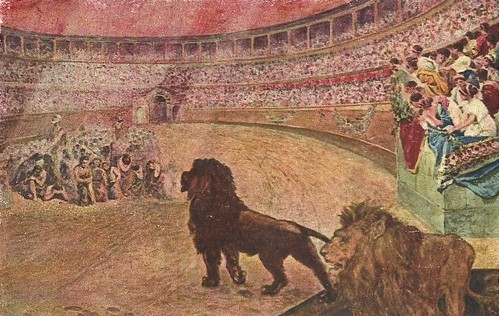
Italian postcard by Ed. E. Sborgi, Firenze. Art work by A. Del Senno. 'Çristiani al martirio'.The composition is a mirrored version of Jean-Léon Gérôme's painting 'The Christian Martyrs' Last Prayer'.
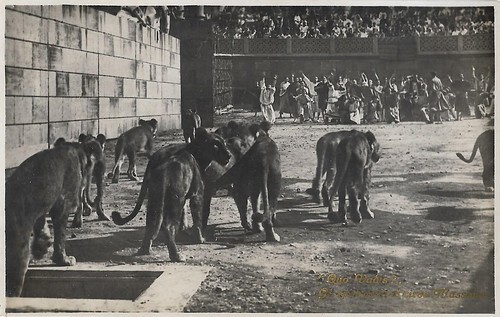
Italian postcard by Ed. G.B. Falci, Milano, La Fotominio, no. 166. Phoyo: Cines. Still from Quo vadis? (Enrico Guazzoni, 1913), used to promote the 1924 version directed by Gabriellino D'Annunzio and Georg Jacoby for U.C.I. Caption: The spectacles at the Circus Maximus. Depicted are the lions about to attack the Christian martyrs, to the sensation of the Roman public. The arena scenes from the 1913 version were so spectacular that they were re-inserted in various later films on Roman Antiquity. This particular image cites a well-known 19th-century painting: 'The Christian Martyrs' Last Prayer' (1883, Walters Art Museum) by the French 'archaeologist' painter Jean-Léon Gérôme.
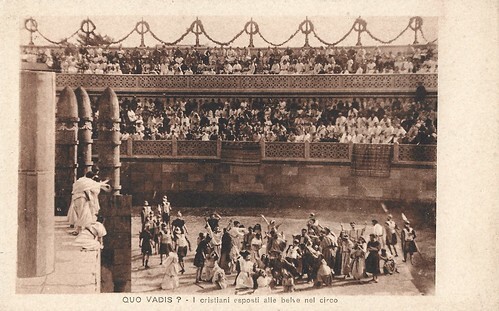
Italian postcard. Photo: Cines. Scene from Quo vadis? (Enrico Guazzoni, 1913), adapted from the novel by Henryk Sienkiewicz. Caption: The Christians were exposed to the beasts at the circus.
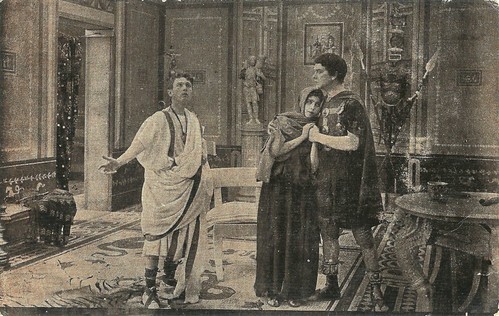
Spanish postcard for Amatller Marca Luna chocolate, series 8, no. 14. Photo: Palatino Film. Livio Pavanelli as St. Sebastiano in Fabiola (Enrico Guazzoni, 1918), hosting the blind Cecilia (Valeria Sanfilippo) on the request of the young Pancrazio (unknown).
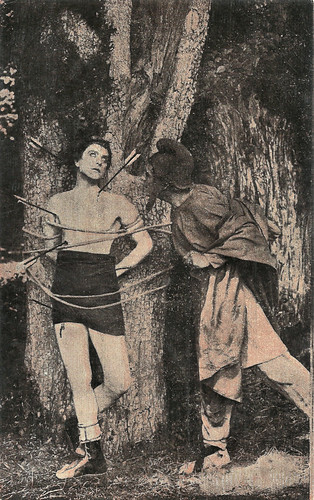
Spanish postcard for Amatller Marca Luna chocolate, series 8, no. 16. Photo: Palatino Film. Livio Pavanelli as St. Sebastiano and Amleto Novelli as Fulvio in Fabiola (Enrico Guazzoni, 1918).
The ultimate Antichrist
In the early history of Christianity, Christian martyrs were tortured or killed by stoning, decapitation, crucifixion, death at the stake, or massacre by wild animals in the arena. Initially, martyrdom in Christianity denoted the endurance of sacrifice, hardship and physical privation to honour God, but later the term was applied to refer almost exclusively to Christians who were killed for their faith.
The first Christian martyrs ever were the apostles of Jesus, except for John, who died in exile. The period of early Christianity before the reign of Constantine is considered the ‘era of the martyrs’. The conventional setting of their stories is that of places of secret Eucharistic celebrations mostly at the Roman catacombs and conventionally they would wave palm branches, while early Christians would make secret signs to each other such as an emblem of a fish, even if 19th c. literature and early 20th c. films already indicate these signs were quickly picked up by their persecutors too.
Often in 19th c. literature featuring Christian martyrs such as 'Quo vadis?' by Henryk Sienkiewicz and 'Fabiola by Cardinal Wiseman, personal dealings like rejection and revenge lead to persecution of either the Christian protagonist, as in the martyrdom of saints like Cecilia or Sebastian, or even all Christians in Rome, as in 'Quo vadis?' and 'Fabiola'.
While in novels like 'Quo vadis?', Nero is presented as the ultimate Antichrist and debauched persecutor of the Christians, history has made clear that persecution of the Christians has been much more drastic under later emperors like Diocletian. Yet, in Arrigo Boito’s opera 'Nerone' of 1924, posthumously premiered as Boito already died in 1918, the reputation of Nero as persecutor of the Christians still prevails, and this of course also goes for the 1924 remake of the film Quo vadis/, in which Emil Jannings stars as the ultimate evil emperor, reminding us of the Nero’s of our own times.
According to the Catholic Catechism, the figure of the martyr is antithetical to that of the apostate, that is, the one who has betrayed the faith. Martyrs are honoured as saints or blessed, and through prayers, services and Eucharistic celebrations, their day of death is commemorated. This cult of martyrs is one of the forms of private and public expression of the Christian faith, rooted already in the first communities that had to confront their new doctrines first with the Jewish tradition and then with the Roman imperial tradition. Yet, it is in particular in more recent centuries that martyrdom in Roman Antiquity was presented to show good examples of strength, virtue, persistence, faith and self-denial, to inspire contemporary audiences to behave in the same way.
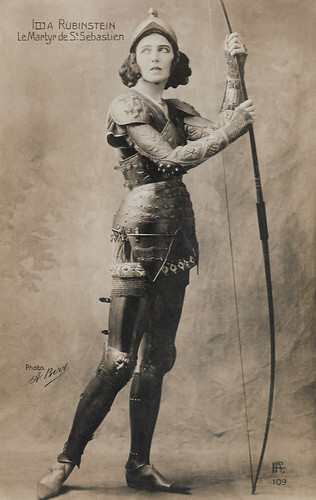
French postcard by RA, no. 109. Photo: A. Bert. Ida Rubinstein in 'Le Martyr de St. Sebastien' (1911). Ida Rubinstein (1885-1960) was a Russian-Ukrainian ballerina of the Ballets Russes, choreographer, actress and Maecenas from the Belle Epoque. After Rubinstein left the Ballets Russes, she founded her own dance company, the Ballet Ida Rubinstein, and had immediate success with 'Le Martyre de Saint Sébastien' (1911), with music by Claude Debussy, text by Gabriele D'Annunzio, and choreography by Michel Fokine and sets and costumes by Léon Bakst.
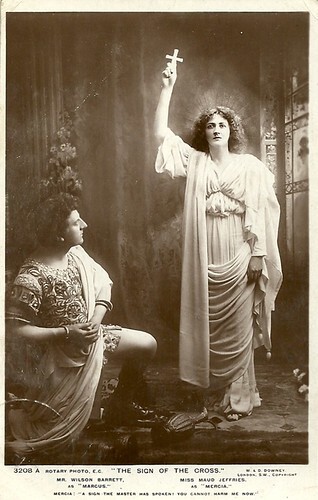
British postcard by Rotary Photo, no. 3208 A. Photo: W. & D. Downey, London. Publicity for the stage play 'The Sign of the Cross' (Wilson Barrett, 1895), starring Wilson Barrett as Marcus Superbus and Maud Jeffries as Mercia. The Rotary cards on 'The Sign of the Cross' are probably early 1900s. Caption: Mercia: A sign the master has spoken: you cannot harm me now. The play was a huge success in the US and UK and elsewhere and would be turned into two major films in 1914 and in 1932.
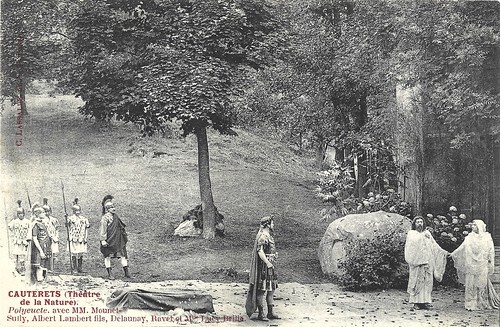
French postcard. Mounet-Sully , Albert Lambert , Louis Delaunay, Louis Ravet and Mlle Lucie Brille in the stage play 'Polyeucte' by Pierre Corneille, staged at the Théâtre de la Nature in Cauterets on 11 or 12 August 1906. Mounet-Sully played Polyeucte, Lambert Severus, and Brille Pauline. The play is based on the life of the martyr Saint Polyeuctus.

French postcard by Mazet-Pons, Béziers. A performance in the Arènes de Béziers, France, a theatre in summertime of 'Héliogabale' (1910). The Prayer of the Christians.
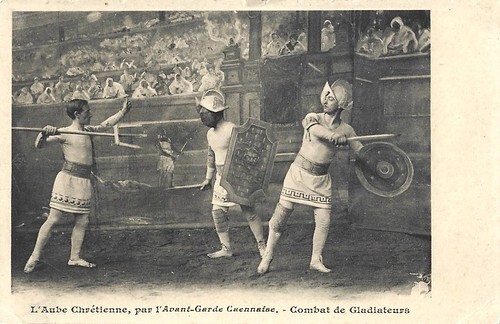
French postcard. 'L'Aube Chrétienne', by L'Avant-garde Caennaise. This was a local play, performed at Caen, France, in April 1912. Caption: Combat de Gladiateurs. NB The helmets look more like 16th-century Spanish helmets, while the shirts and shoes don't look very Roman either. This goes to confirm that every century, every decade and every region makes its own vision of Antiquity.
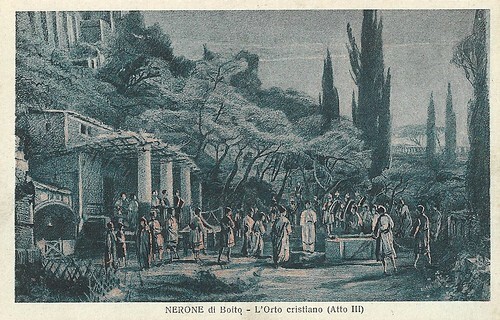
Italian postcard by Ed. G. Zoboli, Bologna. Scene from the opera 'Nerone' (1924) by Arrigo Boito (1842-1918). 'Nerone' premiered posthumously at La Scala on May 1, 1924, conducted by Arturo Toscanini in a version of the score completed by Toscanini, Vincenzo Tommasini, and Antonio Smareglia. The role of Nero, originally intended for Francesco Tamagno, was first performed by Aureliano Pertile. Act III: The Christian garden.
Recycling sets and props like ‘Roman’ furniture or fake statuettes
Sometimes these early martyrdoms were presented in art in more chaste versions, as happened during the Counter-Reformation in still Baroque, opulent versions, towards the late 18th century, in more austere versions. Yet, also in more explicit, shocking versions as in late 19th c. academic art, such as Jean-Léon Gérôme’s 'The Return of the Felines', showing the remains of the slaughtered martyrs, or Léon Bonnat’s 'Martyrdom of St. Denis', with the saint looking for his head after his decapitation.
Particularly active in the field of representing early martyrdom was the organisation Maison de la Bonne Presse in Paris, which, in addition to many written texts like its own books and journals, around 1900 released several lantern slides on the martyrdom of saints like Cecilia and Tarcisius. Selections were afterwards also turned into a postcard series. Bonne Presse also made a few films within this genre. Yet, the mainstay of martyrdom in early cinema was produced by French and Italian cinema, in particular by the companies Pathé Frères in Paris and Cines in Rome.
Remarkable in this respect is what today we would indicate as ‘sustainable’, as these early companies often recycled parts of sets as well as props like ‘Roman’ furniture or fake statuettes copied from classical museum objects in various films, or even within multiple sets within the same film. Like in literature, in early cinema too, early martyrdom is often provoked by jealous and vengeful suitors, rejected by the Christian hero or heroin.
In some cases, such as the two leads in 'Quo vadis?', they manage to escape persecution by fleeing from Rome, but both protagonists and secondary characters often perish because of the ‘pagan’ hatred against them and the cold, indifferent attitude of the mob and the elite. Yet, as in the play and later film adaptations of 'The Sign of the Cross', some non-Christian protagonists have a love for their Christian beloved that is stronger than fear of death, and voluntarily select to die with their beloved in the arena.
Such was the urge to insert Christian messages in sources previously not connected with it, that in 1910 the opera/ drama 'Héliogabale' by Emile Sicard had an important element of Christian martyrdom as well.
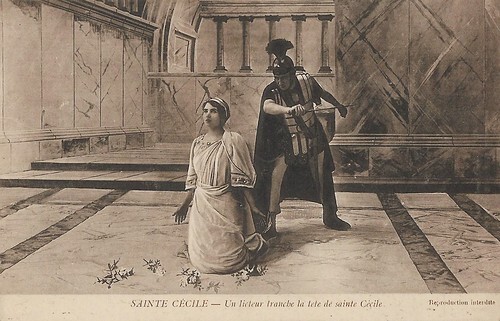
French postcard in the Collection Artistique de la Maison de la Bonne Presse, Paris. The martyrdom of St. Cecilia, set in Roman Antiquity, was a beloved subject in late 19th and early 20th-century Catholic visuals, including a film by the Roman Cines company, Cines: Santa Cecilia (Enrique Santos, 1911), starring Fernanda Negri Pouget.
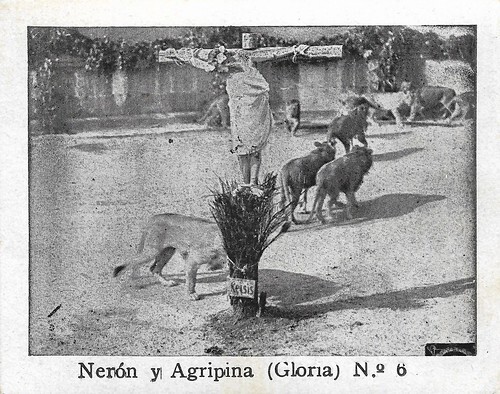
Spanish collector card by Reclam Films, Mallorca, card 6 of 6. Photo: Gloria Film. Scene from Nerone e Agrippina (Mario Caserini, 1914), starring Vittorio Rossi Pianelli as Nerone and Maria Caserini as Agrippina. Caption: Persecution of the Christians in the arena.
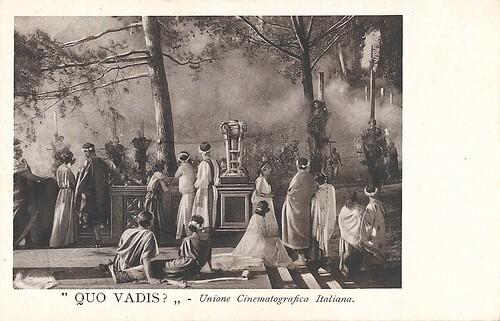
Italian postcard by Argentografica. Photo: Unione Cinematografia Italiana (UCI). Scene from Quo vadis? (Gabriellino D'Annunzio, Georg Jacoby, 1924), based on the classic novel by Henryk Sienkiewicz. Nero's human torches in his gardens.
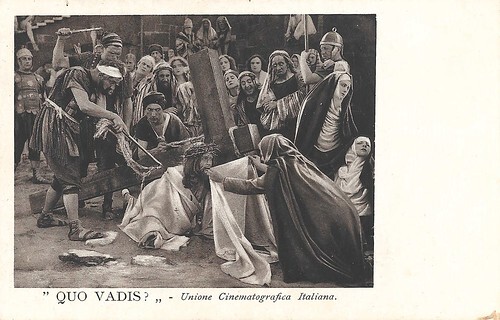
Italian postcard by Argentografica. Photo: Unione Cinematografia Italiana (UCI). Scene from Quo vadis? (Gabriellino D'Annunzio, Georg Jacoby, 1924), based on the classic novel by Henryk Sienkiewicz. Christ has fallen under the Cross, the veil of Veronica.
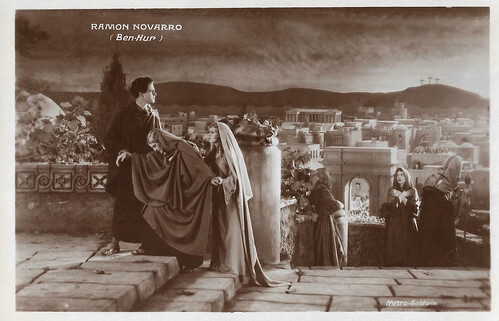
French postcard. Photo: Metro Goldwyn Mayer. Ramon Novarro , Claire McDowell, May McAvoy and Kathleen Key in Ben-Hur (Fred Niblo, 1925).
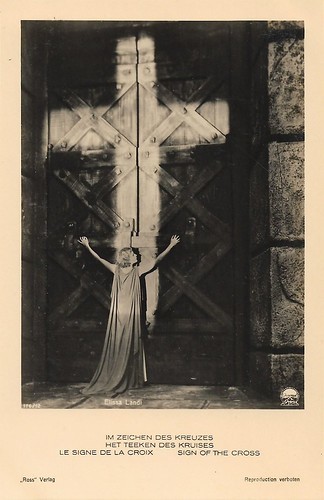
German postcard by Ross Verlag, no. 176/12. Photo: Paramount. Elissa Landi in the American epic The Sign of the Cross (Cecil B. DeMille, 1932), based on the original 1895 play by Wilson Barrett.
Workshops 'Silent Antiquity Prints Unique to the British National Film Archive', Wednesday 25 June 2025, 15:00 – 16:30 & 17:00 – 18:30, Aula Seminari, DAMsLab, Piazzetta P. P. Pasolini 5/b, 40122 Bologna.

Italian postcard by Ed. E. Sborgi, Firenze. Art work by A. Del Senno. 'Çristiani al martirio'.The composition is a mirrored version of Jean-Léon Gérôme's painting 'The Christian Martyrs' Last Prayer'.

Italian postcard by Ed. G.B. Falci, Milano, La Fotominio, no. 166. Phoyo: Cines. Still from Quo vadis? (Enrico Guazzoni, 1913), used to promote the 1924 version directed by Gabriellino D'Annunzio and Georg Jacoby for U.C.I. Caption: The spectacles at the Circus Maximus. Depicted are the lions about to attack the Christian martyrs, to the sensation of the Roman public. The arena scenes from the 1913 version were so spectacular that they were re-inserted in various later films on Roman Antiquity. This particular image cites a well-known 19th-century painting: 'The Christian Martyrs' Last Prayer' (1883, Walters Art Museum) by the French 'archaeologist' painter Jean-Léon Gérôme.

Italian postcard. Photo: Cines. Scene from Quo vadis? (Enrico Guazzoni, 1913), adapted from the novel by Henryk Sienkiewicz. Caption: The Christians were exposed to the beasts at the circus.

Spanish postcard for Amatller Marca Luna chocolate, series 8, no. 14. Photo: Palatino Film. Livio Pavanelli as St. Sebastiano in Fabiola (Enrico Guazzoni, 1918), hosting the blind Cecilia (Valeria Sanfilippo) on the request of the young Pancrazio (unknown).

Spanish postcard for Amatller Marca Luna chocolate, series 8, no. 16. Photo: Palatino Film. Livio Pavanelli as St. Sebastiano and Amleto Novelli as Fulvio in Fabiola (Enrico Guazzoni, 1918).
The ultimate Antichrist
In the early history of Christianity, Christian martyrs were tortured or killed by stoning, decapitation, crucifixion, death at the stake, or massacre by wild animals in the arena. Initially, martyrdom in Christianity denoted the endurance of sacrifice, hardship and physical privation to honour God, but later the term was applied to refer almost exclusively to Christians who were killed for their faith.
The first Christian martyrs ever were the apostles of Jesus, except for John, who died in exile. The period of early Christianity before the reign of Constantine is considered the ‘era of the martyrs’. The conventional setting of their stories is that of places of secret Eucharistic celebrations mostly at the Roman catacombs and conventionally they would wave palm branches, while early Christians would make secret signs to each other such as an emblem of a fish, even if 19th c. literature and early 20th c. films already indicate these signs were quickly picked up by their persecutors too.
Often in 19th c. literature featuring Christian martyrs such as 'Quo vadis?' by Henryk Sienkiewicz and 'Fabiola by Cardinal Wiseman, personal dealings like rejection and revenge lead to persecution of either the Christian protagonist, as in the martyrdom of saints like Cecilia or Sebastian, or even all Christians in Rome, as in 'Quo vadis?' and 'Fabiola'.
While in novels like 'Quo vadis?', Nero is presented as the ultimate Antichrist and debauched persecutor of the Christians, history has made clear that persecution of the Christians has been much more drastic under later emperors like Diocletian. Yet, in Arrigo Boito’s opera 'Nerone' of 1924, posthumously premiered as Boito already died in 1918, the reputation of Nero as persecutor of the Christians still prevails, and this of course also goes for the 1924 remake of the film Quo vadis/, in which Emil Jannings stars as the ultimate evil emperor, reminding us of the Nero’s of our own times.
According to the Catholic Catechism, the figure of the martyr is antithetical to that of the apostate, that is, the one who has betrayed the faith. Martyrs are honoured as saints or blessed, and through prayers, services and Eucharistic celebrations, their day of death is commemorated. This cult of martyrs is one of the forms of private and public expression of the Christian faith, rooted already in the first communities that had to confront their new doctrines first with the Jewish tradition and then with the Roman imperial tradition. Yet, it is in particular in more recent centuries that martyrdom in Roman Antiquity was presented to show good examples of strength, virtue, persistence, faith and self-denial, to inspire contemporary audiences to behave in the same way.

French postcard by RA, no. 109. Photo: A. Bert. Ida Rubinstein in 'Le Martyr de St. Sebastien' (1911). Ida Rubinstein (1885-1960) was a Russian-Ukrainian ballerina of the Ballets Russes, choreographer, actress and Maecenas from the Belle Epoque. After Rubinstein left the Ballets Russes, she founded her own dance company, the Ballet Ida Rubinstein, and had immediate success with 'Le Martyre de Saint Sébastien' (1911), with music by Claude Debussy, text by Gabriele D'Annunzio, and choreography by Michel Fokine and sets and costumes by Léon Bakst.

British postcard by Rotary Photo, no. 3208 A. Photo: W. & D. Downey, London. Publicity for the stage play 'The Sign of the Cross' (Wilson Barrett, 1895), starring Wilson Barrett as Marcus Superbus and Maud Jeffries as Mercia. The Rotary cards on 'The Sign of the Cross' are probably early 1900s. Caption: Mercia: A sign the master has spoken: you cannot harm me now. The play was a huge success in the US and UK and elsewhere and would be turned into two major films in 1914 and in 1932.

French postcard. Mounet-Sully , Albert Lambert , Louis Delaunay, Louis Ravet and Mlle Lucie Brille in the stage play 'Polyeucte' by Pierre Corneille, staged at the Théâtre de la Nature in Cauterets on 11 or 12 August 1906. Mounet-Sully played Polyeucte, Lambert Severus, and Brille Pauline. The play is based on the life of the martyr Saint Polyeuctus.

French postcard by Mazet-Pons, Béziers. A performance in the Arènes de Béziers, France, a theatre in summertime of 'Héliogabale' (1910). The Prayer of the Christians.

French postcard. 'L'Aube Chrétienne', by L'Avant-garde Caennaise. This was a local play, performed at Caen, France, in April 1912. Caption: Combat de Gladiateurs. NB The helmets look more like 16th-century Spanish helmets, while the shirts and shoes don't look very Roman either. This goes to confirm that every century, every decade and every region makes its own vision of Antiquity.

Italian postcard by Ed. G. Zoboli, Bologna. Scene from the opera 'Nerone' (1924) by Arrigo Boito (1842-1918). 'Nerone' premiered posthumously at La Scala on May 1, 1924, conducted by Arturo Toscanini in a version of the score completed by Toscanini, Vincenzo Tommasini, and Antonio Smareglia. The role of Nero, originally intended for Francesco Tamagno, was first performed by Aureliano Pertile. Act III: The Christian garden.
Recycling sets and props like ‘Roman’ furniture or fake statuettes
Sometimes these early martyrdoms were presented in art in more chaste versions, as happened during the Counter-Reformation in still Baroque, opulent versions, towards the late 18th century, in more austere versions. Yet, also in more explicit, shocking versions as in late 19th c. academic art, such as Jean-Léon Gérôme’s 'The Return of the Felines', showing the remains of the slaughtered martyrs, or Léon Bonnat’s 'Martyrdom of St. Denis', with the saint looking for his head after his decapitation.
Particularly active in the field of representing early martyrdom was the organisation Maison de la Bonne Presse in Paris, which, in addition to many written texts like its own books and journals, around 1900 released several lantern slides on the martyrdom of saints like Cecilia and Tarcisius. Selections were afterwards also turned into a postcard series. Bonne Presse also made a few films within this genre. Yet, the mainstay of martyrdom in early cinema was produced by French and Italian cinema, in particular by the companies Pathé Frères in Paris and Cines in Rome.
Remarkable in this respect is what today we would indicate as ‘sustainable’, as these early companies often recycled parts of sets as well as props like ‘Roman’ furniture or fake statuettes copied from classical museum objects in various films, or even within multiple sets within the same film. Like in literature, in early cinema too, early martyrdom is often provoked by jealous and vengeful suitors, rejected by the Christian hero or heroin.
In some cases, such as the two leads in 'Quo vadis?', they manage to escape persecution by fleeing from Rome, but both protagonists and secondary characters often perish because of the ‘pagan’ hatred against them and the cold, indifferent attitude of the mob and the elite. Yet, as in the play and later film adaptations of 'The Sign of the Cross', some non-Christian protagonists have a love for their Christian beloved that is stronger than fear of death, and voluntarily select to die with their beloved in the arena.
Such was the urge to insert Christian messages in sources previously not connected with it, that in 1910 the opera/ drama 'Héliogabale' by Emile Sicard had an important element of Christian martyrdom as well.

French postcard in the Collection Artistique de la Maison de la Bonne Presse, Paris. The martyrdom of St. Cecilia, set in Roman Antiquity, was a beloved subject in late 19th and early 20th-century Catholic visuals, including a film by the Roman Cines company, Cines: Santa Cecilia (Enrique Santos, 1911), starring Fernanda Negri Pouget.

Spanish collector card by Reclam Films, Mallorca, card 6 of 6. Photo: Gloria Film. Scene from Nerone e Agrippina (Mario Caserini, 1914), starring Vittorio Rossi Pianelli as Nerone and Maria Caserini as Agrippina. Caption: Persecution of the Christians in the arena.

Italian postcard by Argentografica. Photo: Unione Cinematografia Italiana (UCI). Scene from Quo vadis? (Gabriellino D'Annunzio, Georg Jacoby, 1924), based on the classic novel by Henryk Sienkiewicz. Nero's human torches in his gardens.

Italian postcard by Argentografica. Photo: Unione Cinematografia Italiana (UCI). Scene from Quo vadis? (Gabriellino D'Annunzio, Georg Jacoby, 1924), based on the classic novel by Henryk Sienkiewicz. Christ has fallen under the Cross, the veil of Veronica.

French postcard. Photo: Metro Goldwyn Mayer. Ramon Novarro , Claire McDowell, May McAvoy and Kathleen Key in Ben-Hur (Fred Niblo, 1925).

German postcard by Ross Verlag, no. 176/12. Photo: Paramount. Elissa Landi in the American epic The Sign of the Cross (Cecil B. DeMille, 1932), based on the original 1895 play by Wilson Barrett.
Workshops 'Silent Antiquity Prints Unique to the British National Film Archive', Wednesday 25 June 2025, 15:00 – 16:30 & 17:00 – 18:30, Aula Seminari, DAMsLab, Piazzetta P. P. Pasolini 5/b, 40122 Bologna.
Published on June 24, 2025 22:00
June 23, 2025
Lewis Milestone: of Wars and Men
A milestone of visual flair and virtuosity in American cinema, the career of Lewis Milestone – a Russian Jewish émigré – bridged silent cinema and the 70mm spectacles of the 1960s. Milestone is the subject of one of the programmes of Il Cinema Ritrovato 2025, curated by Ehsan Khoshbakht. Renowned for having one of the most distinctive and eclectic styles of his generation, his popular and dazzlingly original work ranged from the anti-war magnum opus All Quiet on the Western Front to the popular-front musical Hallelujah, I’m a Bum. As dense, dark, and daunting as his films could get, they were often laced with wit, camaraderie, and bravery amid mass atrocities. Yet, he barely survived the Hollywood blacklist, which forced him to drift into mediocre assignments. This programme, covering his silent films up until the blacklist, features new restorations and archive prints, aiming to recover the artistry of a man who fought many battles of humanity in the 20th Century with a sense of wisdom and poetry that can still shake us.
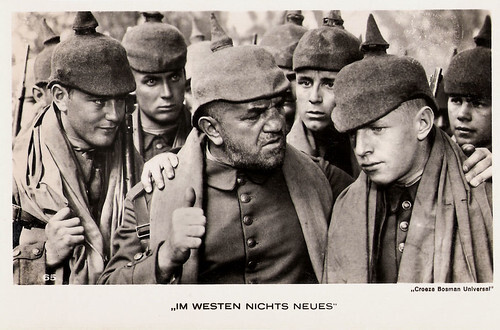
Dutch postcard by Croeze-Bosman-Universal, no. 65. Photo: Universal. Lew Ayres , Louis Wolheim and Owen Davis Jr. in the American WWI, anti-war film All Quiet on the Western Front (Lewis Milestone, 1930), based on the novel 'Im Westen nichts neues' by Erich Maria Remarque.
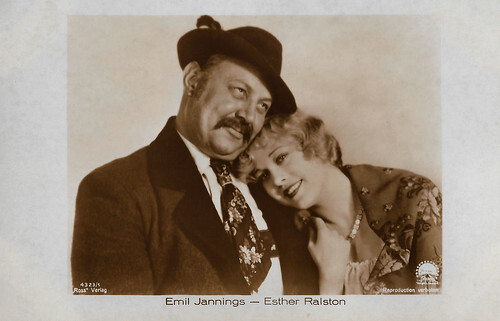
German postcard by Ross Verlag, no. 4323/1, 1929-1930. Photo: Paramount. Emil Jannings and Esther Ralston in Betrayal (Lewis Milestone, 1929).
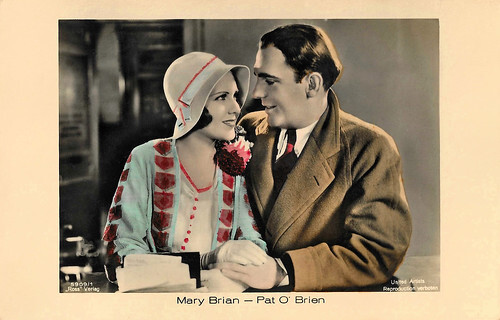
German postcard by Ross Verlag, no. 5909/1, 1930-1931. Photo: United Artists. Mary Brian and Pat 'O Brien in The Front Page (Lewis Milestone, 1931). Collection: Geoffrey Donaldson Institute.
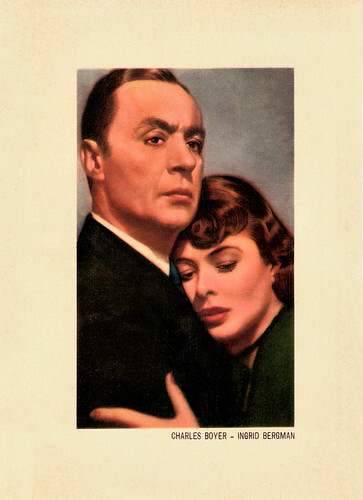
Belgian collector card by Kwatta, Bois d'Haine. Photo: M.G.M. Charles Boyer and Ingrid Bergman in Arch of Triumph (Lewis Milestone, 1948).
Taut editing, snappy dialogue and clever visual touches
Lewis Milestone was born Lev Milstein in 1895 in Kishinev, the capital of Bessarabia in the Russian Empire, now Chisinau, Moldova. ‘Milly’ was the son of a wealthy, distinguished clothing manufacturer. He was raised in Odessa in Ukraine. Milestone had an affinity for the theatre from an early age. Milstein's family discouraged his desire to follow the dramatic arts, and dispatched him to Germany to study engineering.
However, he started his career as a prop man and background artist. To escape being drafted into the Russian army during World War I, he travelled to the US in 1913 with $6.00 in his pocket. He had a succession of odd jobs, such as a dishwasher and a photographer's assistant. Shortly after the US entered World War I in 1917, he joined the Army Signal Corps to make educational short films for U.S. troops. After the war, he acquired American citizenship and legally changed his surname to Milestone.
An acquaintance from the Signal Corps, Jesse D. Hampton, now an independent film producer, secured Milestone an entry-level position as an assistant editor in Hollywood. Milestone quickly worked his way up the ranks to become editor, assistant director and writer. In 1920, he was chosen as general assistant to director Henry King at Pathé Exchange. Milestone's first credited work was as assistant on King's film Dice of Destiny (Henry King, 1920). He worked as editor for director-producer Thomas Ince, was general assistant and co-author on film scripts by William A. Seiter and worked as a gag writer for comedian Harold Lloyd .
These experiences would greatly influence his directing style in the years to come. Milestone directed his first film, Seven Sinners (1925), with Marie Prevost , for Howard Hughes. Two years later, he won his first of two Academy Awards for the comedy Two Arabian Knights (1927) starring William Boyd , Mary Astor , and Louis Wolheim. He received his second Oscar for his masterpiece, the anti-war picture All Quiet on the Western Front (1930), based on a novel by Erich Maria Remarque.
I.S. Mowis at IMDb : “The film, universally praised by reviewers for its eloquence and integrity, also won the Best Picture Academy Award that year. A noted Milestone innovation was the use of cameras mounted on wooden tracks, giving his films a more realistic and fluid, rather than static, look. Other trademarks associated with his pictures were taut editing, snappy dialogue and clever visual touches.” Milestone must be credited with a quirky sense of humour: when the producer of All Quiet on the Western Front , Carl Laemmle Jr., demanded a 'happy ending' for the picture, Milestone telephoned, "I've got your happy ending. We'll let the Germans win the war".
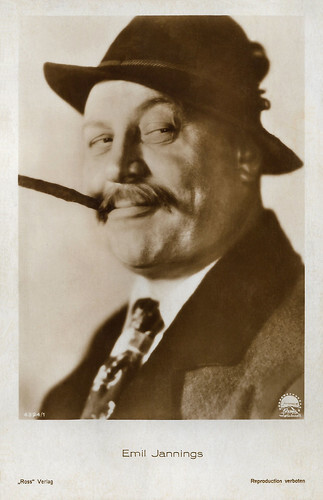
German postcard by Ross Verlag, no. 4324/1, 1929-1930. Photo: Paramount. Emil Jannings in Betrayal (Lewis Milestone, 1929). Jannings' final Hollywood film is thought to be lost.
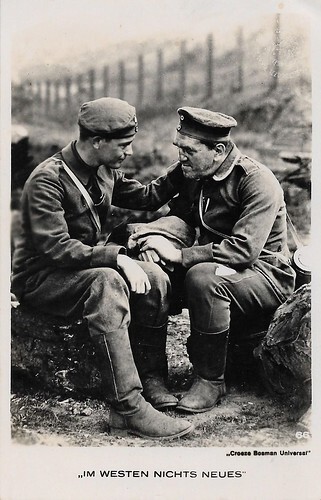
Dutch postcard by Croeze-Bosman-Universal, no. 66. Photo: Universal. Lew Ayres and Louis Wolheim in All Quiet on the Western Front (Lewis Milestone, 1930), based on the novel 'Im Westen nichts neues' by Erich Maria Remarque.
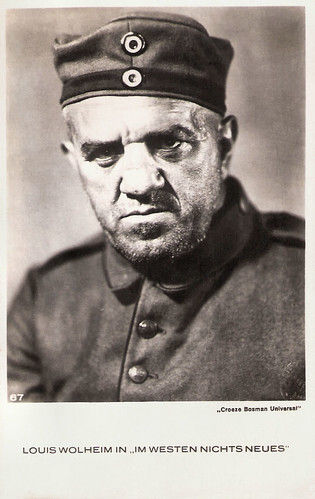
Dutch postcard by Croeze-Bosman-Universal. Photo: Universal. Louis Wolheim in All Quiet on the Western Front (Lewis Milestone, 1930).

Dutch postcard by Croeze-Bosman-Universal. Photo: Universal. Owen Davis Jr. in All Quiet on the Western Front (Lewis Milestone, 1930). Owen Davis Jr. played Peter in the film. Croeze-Bosman was a Dutch film distribution company, founded in 1926 as a continuation of the Dutch American Film Co., a subsidiary of Universal.
A history of being ‘difficult’
In the 1930s, Lewis Milestone directed the Screwball comedy The Front Page (1931) with Adolphe Menjou , the melodrama Rain (1932) with Joan Crawford , based on a play by W. Somerset Maugham, the bravura adventure-melodrama The General Died at Dawn (1936), and an adaptation of John Steinbeck's Of Mice and Men (1939) with Lon Chaney Jr. as the childlike Lennie Small and Burgess Meredith as his keeper George Milton.
Milestone was troubled by film directors' declining control within the studio system and supported King Vidor 's proposal to organise a filmmakers' cooperative. Supporters for a Screen Directors Guild included Frank Borzage, Howard Hawks , Ernst Lubitsch , Rouben Mamoulian and William Wellman, among others. By 1938, the guild was incorporated, representing 600 directors and assistant directors.
Milestone had a history of being ‘difficult’. He clashed with Howard Hughes, Warner Brothers and a host of studio executives over various contractual and artistic issues. Nonetheless, he remained constantly employed and worked for most of the major studios at one time or another, though never on long-term contracts. In 1949, he was blacklisted for a year because of left-wing affiliations dating back to the 1930s. The House Un-American Activities Committee (HUAC) was desperately trying to find ‘Communist subversion’ in Hollywood films. Milestone was not required to testify before the HUAC because he began making films abroad, in both Britain and Italy, but these films were not successful.
Milestone's final years as a filmmaker correspond to the decline of the Hollywood movie empire. His last three films were Hollywood productions with large budgets, but he had a bad time on all of them. Gregory Peck re-edited Pork Chop Hill (1959), which he co-produced. Frank Sinatra and his 'Rat Pack' seem to have largely ignored him on the set of Ocean's Eleven (1960). His career ended with the remake of Mutiny on the Bounty (1962). He replaced Carol Reed as director after Reed quit because he could not cope with the massive ego of the film's star, Marlon Brando . Milestone didn't find Brando any easier to work with and in the end let him do as he pleased. The result was a hugely expensive box-office failure.
Milestone was then scheduled to direct PT 109 (1963) starring Cliff Robertson and Robert Culp, a film about President John F. Kennedy's wartime adventures, but he was replaced by TV director Leslie H. Martinson. After that, Milestone seems to have given up on films, although he directed a few television series episodes, an experience he did not enjoy. Having suffered a stroke, Lewis Milestone spent the last ten years of his life confined to a wheelchair. He died in 1980, after surgery at the University of California Medical Centre in Los Angeles. He died five days before his 85th birthday. Milestone was married to actress Kendall Lee from 1936 till her death in 1978.
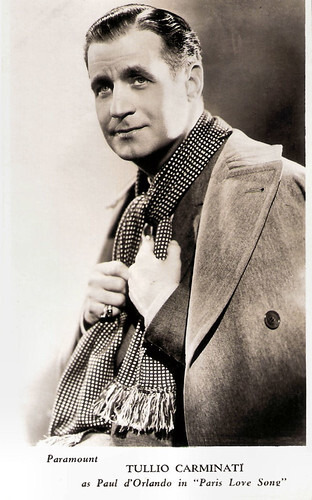
British postcard. Photo: Paramount. Tullio Carminati in Paris in Spring / Paris Love Song (Lewis Milestone, 1935).
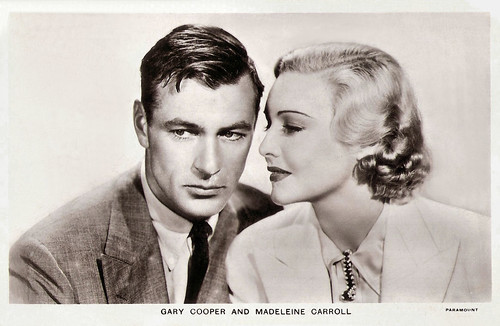
British postcard in the Film Partners series, no. P 214. Photo: Paramount. Madeleine Carroll and Gary Cooper in The General Died at Dawn (Lewis Milestone, 1936).
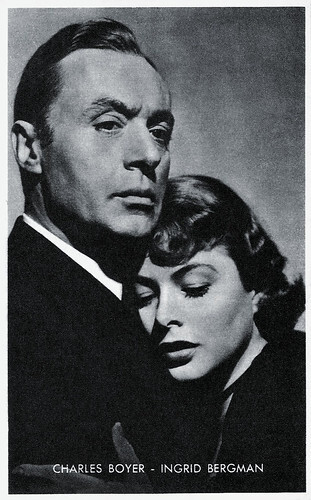
Belgian collector card by Kwatta, Bois d'Haine, no. C. 176. Photo: M.G.M. Charles Boyer and Ingrid Bergman in Arch of Triumph (Lewis Milestone, 1948).
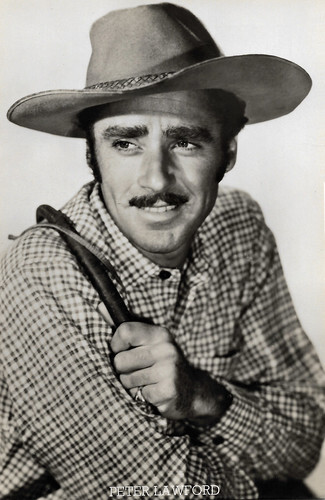
Belgian postcard, no. 152. Photo: 20th Century Fox. Peter Lawford in Kangaroo (Lewis Milestone, 1952).
Sources: (IMDb), Wikipedia (Dutch and English) and .

Dutch postcard by Croeze-Bosman-Universal, no. 65. Photo: Universal. Lew Ayres , Louis Wolheim and Owen Davis Jr. in the American WWI, anti-war film All Quiet on the Western Front (Lewis Milestone, 1930), based on the novel 'Im Westen nichts neues' by Erich Maria Remarque.

German postcard by Ross Verlag, no. 4323/1, 1929-1930. Photo: Paramount. Emil Jannings and Esther Ralston in Betrayal (Lewis Milestone, 1929).

German postcard by Ross Verlag, no. 5909/1, 1930-1931. Photo: United Artists. Mary Brian and Pat 'O Brien in The Front Page (Lewis Milestone, 1931). Collection: Geoffrey Donaldson Institute.

Belgian collector card by Kwatta, Bois d'Haine. Photo: M.G.M. Charles Boyer and Ingrid Bergman in Arch of Triumph (Lewis Milestone, 1948).
Taut editing, snappy dialogue and clever visual touches
Lewis Milestone was born Lev Milstein in 1895 in Kishinev, the capital of Bessarabia in the Russian Empire, now Chisinau, Moldova. ‘Milly’ was the son of a wealthy, distinguished clothing manufacturer. He was raised in Odessa in Ukraine. Milestone had an affinity for the theatre from an early age. Milstein's family discouraged his desire to follow the dramatic arts, and dispatched him to Germany to study engineering.
However, he started his career as a prop man and background artist. To escape being drafted into the Russian army during World War I, he travelled to the US in 1913 with $6.00 in his pocket. He had a succession of odd jobs, such as a dishwasher and a photographer's assistant. Shortly after the US entered World War I in 1917, he joined the Army Signal Corps to make educational short films for U.S. troops. After the war, he acquired American citizenship and legally changed his surname to Milestone.
An acquaintance from the Signal Corps, Jesse D. Hampton, now an independent film producer, secured Milestone an entry-level position as an assistant editor in Hollywood. Milestone quickly worked his way up the ranks to become editor, assistant director and writer. In 1920, he was chosen as general assistant to director Henry King at Pathé Exchange. Milestone's first credited work was as assistant on King's film Dice of Destiny (Henry King, 1920). He worked as editor for director-producer Thomas Ince, was general assistant and co-author on film scripts by William A. Seiter and worked as a gag writer for comedian Harold Lloyd .
These experiences would greatly influence his directing style in the years to come. Milestone directed his first film, Seven Sinners (1925), with Marie Prevost , for Howard Hughes. Two years later, he won his first of two Academy Awards for the comedy Two Arabian Knights (1927) starring William Boyd , Mary Astor , and Louis Wolheim. He received his second Oscar for his masterpiece, the anti-war picture All Quiet on the Western Front (1930), based on a novel by Erich Maria Remarque.
I.S. Mowis at IMDb : “The film, universally praised by reviewers for its eloquence and integrity, also won the Best Picture Academy Award that year. A noted Milestone innovation was the use of cameras mounted on wooden tracks, giving his films a more realistic and fluid, rather than static, look. Other trademarks associated with his pictures were taut editing, snappy dialogue and clever visual touches.” Milestone must be credited with a quirky sense of humour: when the producer of All Quiet on the Western Front , Carl Laemmle Jr., demanded a 'happy ending' for the picture, Milestone telephoned, "I've got your happy ending. We'll let the Germans win the war".

German postcard by Ross Verlag, no. 4324/1, 1929-1930. Photo: Paramount. Emil Jannings in Betrayal (Lewis Milestone, 1929). Jannings' final Hollywood film is thought to be lost.

Dutch postcard by Croeze-Bosman-Universal, no. 66. Photo: Universal. Lew Ayres and Louis Wolheim in All Quiet on the Western Front (Lewis Milestone, 1930), based on the novel 'Im Westen nichts neues' by Erich Maria Remarque.

Dutch postcard by Croeze-Bosman-Universal. Photo: Universal. Louis Wolheim in All Quiet on the Western Front (Lewis Milestone, 1930).

Dutch postcard by Croeze-Bosman-Universal. Photo: Universal. Owen Davis Jr. in All Quiet on the Western Front (Lewis Milestone, 1930). Owen Davis Jr. played Peter in the film. Croeze-Bosman was a Dutch film distribution company, founded in 1926 as a continuation of the Dutch American Film Co., a subsidiary of Universal.
A history of being ‘difficult’
In the 1930s, Lewis Milestone directed the Screwball comedy The Front Page (1931) with Adolphe Menjou , the melodrama Rain (1932) with Joan Crawford , based on a play by W. Somerset Maugham, the bravura adventure-melodrama The General Died at Dawn (1936), and an adaptation of John Steinbeck's Of Mice and Men (1939) with Lon Chaney Jr. as the childlike Lennie Small and Burgess Meredith as his keeper George Milton.
Milestone was troubled by film directors' declining control within the studio system and supported King Vidor 's proposal to organise a filmmakers' cooperative. Supporters for a Screen Directors Guild included Frank Borzage, Howard Hawks , Ernst Lubitsch , Rouben Mamoulian and William Wellman, among others. By 1938, the guild was incorporated, representing 600 directors and assistant directors.
Milestone had a history of being ‘difficult’. He clashed with Howard Hughes, Warner Brothers and a host of studio executives over various contractual and artistic issues. Nonetheless, he remained constantly employed and worked for most of the major studios at one time or another, though never on long-term contracts. In 1949, he was blacklisted for a year because of left-wing affiliations dating back to the 1930s. The House Un-American Activities Committee (HUAC) was desperately trying to find ‘Communist subversion’ in Hollywood films. Milestone was not required to testify before the HUAC because he began making films abroad, in both Britain and Italy, but these films were not successful.
Milestone's final years as a filmmaker correspond to the decline of the Hollywood movie empire. His last three films were Hollywood productions with large budgets, but he had a bad time on all of them. Gregory Peck re-edited Pork Chop Hill (1959), which he co-produced. Frank Sinatra and his 'Rat Pack' seem to have largely ignored him on the set of Ocean's Eleven (1960). His career ended with the remake of Mutiny on the Bounty (1962). He replaced Carol Reed as director after Reed quit because he could not cope with the massive ego of the film's star, Marlon Brando . Milestone didn't find Brando any easier to work with and in the end let him do as he pleased. The result was a hugely expensive box-office failure.
Milestone was then scheduled to direct PT 109 (1963) starring Cliff Robertson and Robert Culp, a film about President John F. Kennedy's wartime adventures, but he was replaced by TV director Leslie H. Martinson. After that, Milestone seems to have given up on films, although he directed a few television series episodes, an experience he did not enjoy. Having suffered a stroke, Lewis Milestone spent the last ten years of his life confined to a wheelchair. He died in 1980, after surgery at the University of California Medical Centre in Los Angeles. He died five days before his 85th birthday. Milestone was married to actress Kendall Lee from 1936 till her death in 1978.

British postcard. Photo: Paramount. Tullio Carminati in Paris in Spring / Paris Love Song (Lewis Milestone, 1935).

British postcard in the Film Partners series, no. P 214. Photo: Paramount. Madeleine Carroll and Gary Cooper in The General Died at Dawn (Lewis Milestone, 1936).

Belgian collector card by Kwatta, Bois d'Haine, no. C. 176. Photo: M.G.M. Charles Boyer and Ingrid Bergman in Arch of Triumph (Lewis Milestone, 1948).

Belgian postcard, no. 152. Photo: 20th Century Fox. Peter Lawford in Kangaroo (Lewis Milestone, 1952).
Sources: (IMDb), Wikipedia (Dutch and English) and .
Published on June 23, 2025 22:00
June 22, 2025
Masks and Music: The Films of Willi Forst
We're in Bologna for Il Cinema Ritrovato from 21 - 29 June. One of the highlights for us is a tribute to Austrian actor-turned-director Willi Forst curated by Lukas Foerster. A consummate craftsman, Forst was a versatile filmmaker who excelled in both dramas and comedies. The Festival website: "His films from the 1930s and 1940s, constituting the most accomplished body of work by any director active in Germany during the Nazi era, reveal a profound, almost obsessive love for music. Far from serving as mere background, music permeates every aspect of his work, shaping the plot, influencing the mise-en-scène, and driving the editing. In a Forst film, a single melody can lead to happiness, despair, or even both simultaneously. Remarkably, Forst largely avoided contamination by National Socialist ideology, preserving in his cinema the urbane and sophisticated spirit of the late Weimar Republic while cultivating a darker, more melancholic worldview uniquely his own."
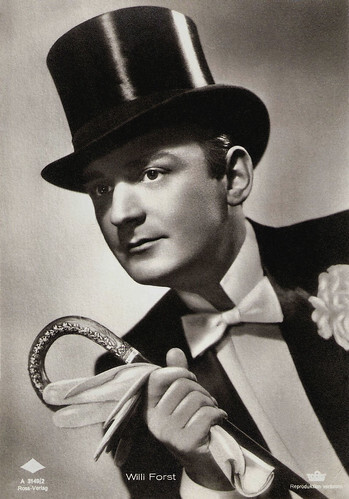
German postcard by Ross Verlag, no. A 3149/2, 1941-1944. Photo: Tobis. Willi Forst in Bel Ami (Will Forst, 1939).
Willi Forst (1903-1980) was a darling of the German-speaking public. He was also one of the most significant directors, producers, writers and stars of the Wiener Filme, the light Viennese musical comedies of the 1930s. Bel Ami (Willi Forst, 1939), loosely based on the novel by Guy de Maupassant, would be his best-known film. He also played the title role, which would be his alter ego from then on. Forst was much courted by the Nazis but succeeded in avoiding overt political statements, concentrating on the light entertainment for which he was famous and which was much in demand during the war.
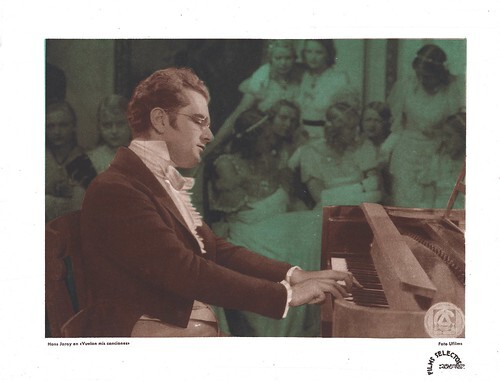
Spanish leaflet by Films Selectos, Suplemento Artistico, no. 176, 24.2.1934. Photo: Cine-Allianz. Hans Jaray in the Biopic Leise flehen meine Lieder / Gently My Songs Entreat (Willi Forst, 1933).
Leise flehen meine Lieder (Willi Forst, 1933 was Forst's first film direction, a Biopic about the life of composer and musician Franz Schubert. Leise flehen meine Lieder was so popular throughout Europe that it was reshot in a British version for the English language market as The Unfinished Symphony (Willi Forst, Anthony Asquith, 1934), also with Austrian actor Hans Jaray in the lead. Forst also wrote the scenario. The co-author of the original was Walter Reisch, who in later Hollywood exile would script Ninotchka (Ernst Lubitsch, 1939) and Gaslight (George Cukor, 1944), and work with Billy Wilder .

Dutch photo. Front of the Rembrandt Theatre in Amsterdam, The Netherlands. On show was Leise flehen meine Lieder / Gently My Songs Entreat (Willi Forst, 1933). A gift from Roloff de Jeu.
Leise flehen meine Lieder / Gently My Songs Entreat took on the love affair between composer Franz Schubert and the Countess Esterhazy. In Lieder, Hans Jaray starred as Schubert, Luise Ullrich, fresh from Max Ophüls’s Liebelei, was Schubert’s innocent love, future comedic superstar Hans Moser was her father, and Marta Eggerth was the seductive Czardas-dancing countess who disrupts the composer’s life. Robert von Dassamowsky in Senses of Cinema: "The orchestration of image, lighting, music and performance in Lieder suggests a unique personal style that had not been previously seen in the new musical film. The style-cum-genre genre was certainly Viennese from its very roots: theatrical and visual values of the Baroque, the near operatic equality of dialogue and music, and the balanced blending of all aspects of the film into a seamless Gesamtkunstwerk, or total work of art."
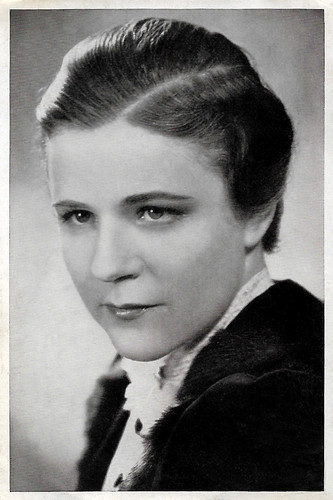
German collector card in the series 'Vom Werden deutscher Filmkunst - Der Tonfilm', album no. 11, picture no. 103. Photo: Tobis-Sascha-Film / Ross Verlag. Paula Wessely in Maskerade/Masquerade in Vienna (Willi Forst, 1934).
Distinguished stage actress Paula Wessely played her first major film role as Leopoldine Dur in Forst's second film, the Operetta Maskerade / Masquerade in Vienna (Willi Forst, 1934) alongside Adolf Wohlbrück . Maskerade, set in the Viennese high society of about 1900, was a hit that launched Forst's fame as a significant director and made an instant star of Wessely. The exceptional script of this classic example of the Wiener Film was written by Walter Reisch and directed by Willi Forst . Essential to the visual success of the film was the contribution of director of photography Franz Planer, with his lively and beautifully lit compositions. Maskerade received an award for best screenplay at the Venice Film Festival and ultimately proved to be so successful internationally that Hollywood 'borrowed' the story for a new, but less welcomed version entitled Escapade (Robert Z. Leonard, 1935) with Luise Rainer .
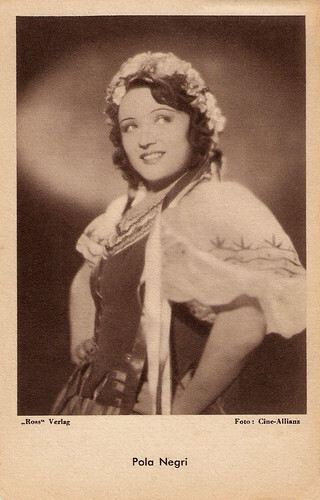
German postcard by Ross Verlag / Das Programm von Heute für Film und Theater G.m.b.H., Berlin. Photo: Cine-Allianz. Pola Negri in Mazurka (Willi Forst, 1935).
Willi Forst rapidly developed himself into a four-way talent, as producer, director, writer and actor in German films. For Mazurka (Willi Forst, 1935), he lured Pola Negri back from Hollywood. She played a woman who was put on trial for murdering a predatory musician. The title refers to the Polish folk dance. Mazurka gained much popularity in Germany and became one of Adolf Hitler's favourite films. Warner Bros. acquired the U.S. distribution rights but shelved the film in favour of its own scene-by-scene English language remake, Confession (Joe May, 1937), which starred Kay Francis .
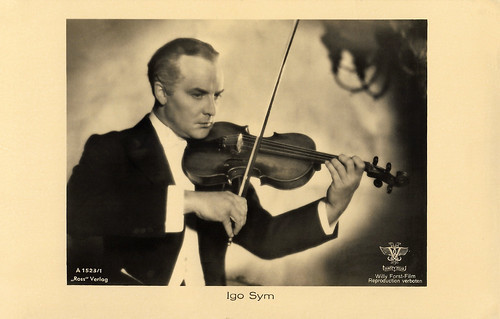
German postcard by Ross Verlag, no. A 1523/1, 1937-1938. Photo: Willi Forst-Film. Igo Sym in Serenade (Willi Forst, 1937).
In 1937, Will Forst founded his own film company, Willi Forst-Film. His first production was the drama Serenade (Willi Forst, 1937), starring Hilde Krahl , Albert Matterstock and Igo Sym . Forst considered a move to Hollywood the same year, but stayed in Vienna. Following Austria’s annexation to Germany in March 1938, Vienna’s film industry was wholly integrated into the structure and ideology of the Third Reich and given a specific cultural mission – the production of lavish musicals, costume dramas and other 'Vienna style' entertainment films for the Reich and its Axis partners. With strong control from Berlin, the new Viennese mega-studio Wien-Film echoed the concept of the Hollywood studio system more closely than had been normal in previous Austrian cinema development. Many Austrian talents at Ufa in Berlin, including Forst, returned home to participate in this new phase of Vienna’s industry.
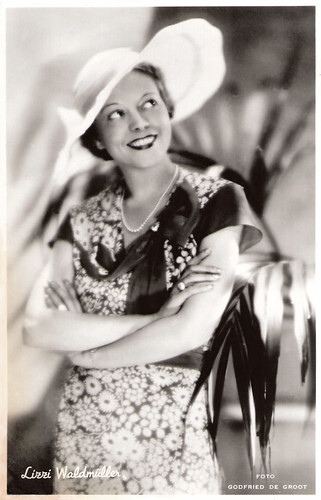
Dutch postcard by M. B. & Z. (M. Bonnist & Zonen, Amsterdam), no. 1215. Photo: Godfried de Groot.
Austrian actress and singer Lizzi Waldmüller (1904-1945) had her breakthrough to stardom through her role as Rachel in Bel Ami (Willi Forst, 1939). Following the annexation of Austria in 1938, Willi Forst was much courted by the National Socialists but succeeded in avoiding overt political statement, concentrating entirely on the opulent period musical entertainment for which he was famous and which was much in demand. He changed the brash and ambitious ex-military man of Guy De Maupassant's novel into a likeable bon vivant and charmer in a dress suit. Bel Ami was made on the eve of the outbreak of the Second World War, at a time when Germany's going to war against France was already a very likely prospect. In Nazi Germany, the film industry was closely controlled by the Minister of Propaganda Joseph Goebbels. While Bel Ami was not conceived as an outright propaganda film, the theme of corruption in the French society and politics - prominently present in the Maupassant original - was well suited to the thrust of Nazi propaganda at the time the film was made.

German postcard by Ross Verlag, no. A 3169/1, 1941-1944. Photo: Wien-Film / Tobis. Trude Marlen in Operette / Operetta (Willi Forst, Karl Hartl, 1940).
Unlike the other directors of Wien-Film, Forst preferred to use relatively untested talent as co-stars, and thus managed to create stardom for several leading ladies: Lizzi Waldmüller , Ilse Werner , and Trude Marlen . Willi Forst directed curly-locked Trude Marlen in Operette / Operetta (Willi Forst, Karl Hartl, 1940), also starring Forst, Maria Holst and Dora Komar . The film was made by Wien-Film. It is the first film in Forst's 'Viennese Trilogy', followed by Wiener Blut / Vienna Blood (1942) and Wiener Mädel / Viennese Girls (1945). The film, a mix of an operetta film and a Wiener Film, portrays the life of Franz Jauner (1832–1900), a leading musical figure in Vienna.
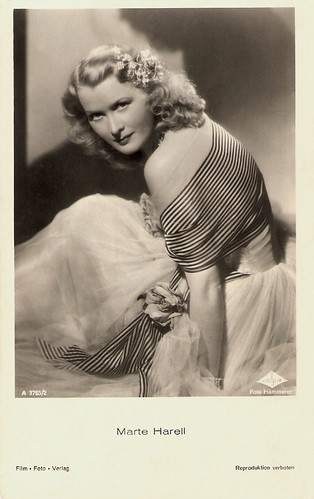
German postcard by Film-Foto-Verlag, no. A 3765/2, 1941-1944. Photo: Hämmerer / Wien-Film. Marte Harell in Frauen sind keine Engel / Women aren't Angels (Willi Forst, 1943).
Forst was an extremely versatile genre filmmaker, who could as easily make a crime film, a contemporary melodrama or a sophisticated comedy. An example is the comedy Frauen sind keine Engel / Women aren't Angels (Willi Forst, 1943) starring Marte Harell , Axel von Ambesser and Margot Hielscher , which was also produced by Wien Film. During the seven-year Nazi rule in Austria, Willi Forst only made six films, none of them political.
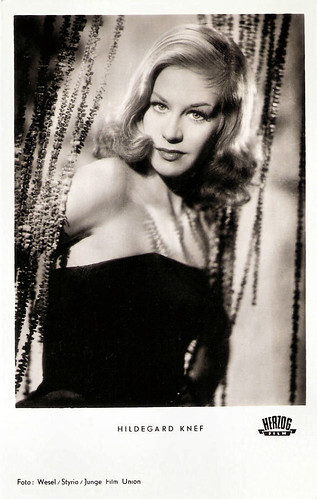
German postcard by Kunst und Bild, Berlin, no. A 482. Photo: Wesel / Styria / Junge Film Union / Herzog Film. Hildegard Knef in Die Sünderin / The Sinner (Willi Forst, 1950).
Willi Forst had comparatively little success after the war except for the film Die Sünderin / The Sinner (Willi Forst, 1950) starring Hildegard Knef , which became a scandal because of the protests of the Roman Catholic church against its nudity, rare in contemporary German-speaking cinema, but which subsequently attracted an audience of seven million people. The film represented a major shift for Forst, who had previously been known for escapist films, which avoided controversial themes and embraced romanticised settings. Die Sünderin / The Sinner adopted instead a realist perspective, addressing taboo subjects like prostitution and euthanasia, which challenged the moral sensitivities of post-war West German society.
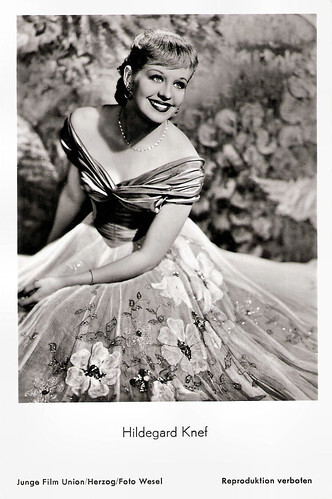
German postcard by F.J. Rüdel Filmpostkartenverlag, Hamburg-Bergedorf, no. 81/2. Photo: Junge Film Union / Herzog / Foto Wesel. Hildegard Knef in Es geschehen noch Wunder / Miracles Still Happen (Willi Forst, 1951).
Rebellious, gravel-voiced actress, chanteuse and author Hildegard Knef (1925-2002) was one of the most important film stars of post-war Germany. Despite the controversy, or perhaps because of it, Die Sünderin / The Sinner marked a turning point in Knef’s career, after which she appeared in notable Hollywood films such as the War film Decision Before Dawn (Anatole Litvak, 1951) and the romantic adventure film The Snows of Kilimanjaro (Henry King, 1952). Es geschehen noch Wunder / Miracles Still Happen (Willi Forst, 1951) was intended by Forst as a less risqué follow-up to his controversial Die Sünderin / The Sinner (Willi Forst, 1950).
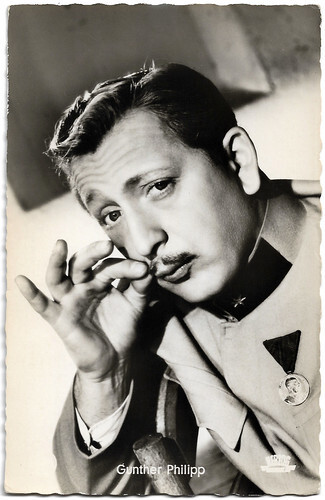
West-German postcard by Kolibri-Verlag G.m.b.H, Minden-Westf, no. 2337. Photo: Sascha / Herzog / Michaelis. Günther Philipp in Kaiserjäger / Emperor Hunter (Willi Forst, 1956).
Austrian film actor Gunther Philipp (1918-2003) appeared in 147 mostly German films and TV productions, mainly in comic roles, like as Leutnant der Reserve Otto Schatz in Kaiserjäger / Emperor Hunter (Willi Forst, 1956). The film didn't revitalise Willi Forst 's career. The following year, Forst directed his final film, after which he retired from the industry. IMDb cites him saying: "My style is no longer in demand: I go off, a little bit battered, but in proud greatness à la [ Greta Garbo ]. It is better to go than to be asked to go." Forst is today considered one of Europe's important early sound directors. In his study, Willi Forst. Ein filmkritisches Porträt', Italian film historian Francesco Bono notes that Forst's last film, Wien, die Stadt meiner Träume (1957), is more than a superficial narrative. It is a film that exposes the superficial, fictional image of Vienna promoted by Austrian cinema of the 1950s precisely as an illusion. That Vienna of your dreams exists only in film.'
Sources: Robert von Dassanowsky (Senses of Cinema), Ivo Blom (review 'Willi Forst. Ein filmkritisches Porträt' in TMG Online, 2011), Wikipedia (English and German) and .

German postcard by Ross Verlag, no. A 3149/2, 1941-1944. Photo: Tobis. Willi Forst in Bel Ami (Will Forst, 1939).
Willi Forst (1903-1980) was a darling of the German-speaking public. He was also one of the most significant directors, producers, writers and stars of the Wiener Filme, the light Viennese musical comedies of the 1930s. Bel Ami (Willi Forst, 1939), loosely based on the novel by Guy de Maupassant, would be his best-known film. He also played the title role, which would be his alter ego from then on. Forst was much courted by the Nazis but succeeded in avoiding overt political statements, concentrating on the light entertainment for which he was famous and which was much in demand during the war.

Spanish leaflet by Films Selectos, Suplemento Artistico, no. 176, 24.2.1934. Photo: Cine-Allianz. Hans Jaray in the Biopic Leise flehen meine Lieder / Gently My Songs Entreat (Willi Forst, 1933).
Leise flehen meine Lieder (Willi Forst, 1933 was Forst's first film direction, a Biopic about the life of composer and musician Franz Schubert. Leise flehen meine Lieder was so popular throughout Europe that it was reshot in a British version for the English language market as The Unfinished Symphony (Willi Forst, Anthony Asquith, 1934), also with Austrian actor Hans Jaray in the lead. Forst also wrote the scenario. The co-author of the original was Walter Reisch, who in later Hollywood exile would script Ninotchka (Ernst Lubitsch, 1939) and Gaslight (George Cukor, 1944), and work with Billy Wilder .

Dutch photo. Front of the Rembrandt Theatre in Amsterdam, The Netherlands. On show was Leise flehen meine Lieder / Gently My Songs Entreat (Willi Forst, 1933). A gift from Roloff de Jeu.
Leise flehen meine Lieder / Gently My Songs Entreat took on the love affair between composer Franz Schubert and the Countess Esterhazy. In Lieder, Hans Jaray starred as Schubert, Luise Ullrich, fresh from Max Ophüls’s Liebelei, was Schubert’s innocent love, future comedic superstar Hans Moser was her father, and Marta Eggerth was the seductive Czardas-dancing countess who disrupts the composer’s life. Robert von Dassamowsky in Senses of Cinema: "The orchestration of image, lighting, music and performance in Lieder suggests a unique personal style that had not been previously seen in the new musical film. The style-cum-genre genre was certainly Viennese from its very roots: theatrical and visual values of the Baroque, the near operatic equality of dialogue and music, and the balanced blending of all aspects of the film into a seamless Gesamtkunstwerk, or total work of art."

German collector card in the series 'Vom Werden deutscher Filmkunst - Der Tonfilm', album no. 11, picture no. 103. Photo: Tobis-Sascha-Film / Ross Verlag. Paula Wessely in Maskerade/Masquerade in Vienna (Willi Forst, 1934).
Distinguished stage actress Paula Wessely played her first major film role as Leopoldine Dur in Forst's second film, the Operetta Maskerade / Masquerade in Vienna (Willi Forst, 1934) alongside Adolf Wohlbrück . Maskerade, set in the Viennese high society of about 1900, was a hit that launched Forst's fame as a significant director and made an instant star of Wessely. The exceptional script of this classic example of the Wiener Film was written by Walter Reisch and directed by Willi Forst . Essential to the visual success of the film was the contribution of director of photography Franz Planer, with his lively and beautifully lit compositions. Maskerade received an award for best screenplay at the Venice Film Festival and ultimately proved to be so successful internationally that Hollywood 'borrowed' the story for a new, but less welcomed version entitled Escapade (Robert Z. Leonard, 1935) with Luise Rainer .

German postcard by Ross Verlag / Das Programm von Heute für Film und Theater G.m.b.H., Berlin. Photo: Cine-Allianz. Pola Negri in Mazurka (Willi Forst, 1935).
Willi Forst rapidly developed himself into a four-way talent, as producer, director, writer and actor in German films. For Mazurka (Willi Forst, 1935), he lured Pola Negri back from Hollywood. She played a woman who was put on trial for murdering a predatory musician. The title refers to the Polish folk dance. Mazurka gained much popularity in Germany and became one of Adolf Hitler's favourite films. Warner Bros. acquired the U.S. distribution rights but shelved the film in favour of its own scene-by-scene English language remake, Confession (Joe May, 1937), which starred Kay Francis .

German postcard by Ross Verlag, no. A 1523/1, 1937-1938. Photo: Willi Forst-Film. Igo Sym in Serenade (Willi Forst, 1937).
In 1937, Will Forst founded his own film company, Willi Forst-Film. His first production was the drama Serenade (Willi Forst, 1937), starring Hilde Krahl , Albert Matterstock and Igo Sym . Forst considered a move to Hollywood the same year, but stayed in Vienna. Following Austria’s annexation to Germany in March 1938, Vienna’s film industry was wholly integrated into the structure and ideology of the Third Reich and given a specific cultural mission – the production of lavish musicals, costume dramas and other 'Vienna style' entertainment films for the Reich and its Axis partners. With strong control from Berlin, the new Viennese mega-studio Wien-Film echoed the concept of the Hollywood studio system more closely than had been normal in previous Austrian cinema development. Many Austrian talents at Ufa in Berlin, including Forst, returned home to participate in this new phase of Vienna’s industry.

Dutch postcard by M. B. & Z. (M. Bonnist & Zonen, Amsterdam), no. 1215. Photo: Godfried de Groot.
Austrian actress and singer Lizzi Waldmüller (1904-1945) had her breakthrough to stardom through her role as Rachel in Bel Ami (Willi Forst, 1939). Following the annexation of Austria in 1938, Willi Forst was much courted by the National Socialists but succeeded in avoiding overt political statement, concentrating entirely on the opulent period musical entertainment for which he was famous and which was much in demand. He changed the brash and ambitious ex-military man of Guy De Maupassant's novel into a likeable bon vivant and charmer in a dress suit. Bel Ami was made on the eve of the outbreak of the Second World War, at a time when Germany's going to war against France was already a very likely prospect. In Nazi Germany, the film industry was closely controlled by the Minister of Propaganda Joseph Goebbels. While Bel Ami was not conceived as an outright propaganda film, the theme of corruption in the French society and politics - prominently present in the Maupassant original - was well suited to the thrust of Nazi propaganda at the time the film was made.

German postcard by Ross Verlag, no. A 3169/1, 1941-1944. Photo: Wien-Film / Tobis. Trude Marlen in Operette / Operetta (Willi Forst, Karl Hartl, 1940).
Unlike the other directors of Wien-Film, Forst preferred to use relatively untested talent as co-stars, and thus managed to create stardom for several leading ladies: Lizzi Waldmüller , Ilse Werner , and Trude Marlen . Willi Forst directed curly-locked Trude Marlen in Operette / Operetta (Willi Forst, Karl Hartl, 1940), also starring Forst, Maria Holst and Dora Komar . The film was made by Wien-Film. It is the first film in Forst's 'Viennese Trilogy', followed by Wiener Blut / Vienna Blood (1942) and Wiener Mädel / Viennese Girls (1945). The film, a mix of an operetta film and a Wiener Film, portrays the life of Franz Jauner (1832–1900), a leading musical figure in Vienna.

German postcard by Film-Foto-Verlag, no. A 3765/2, 1941-1944. Photo: Hämmerer / Wien-Film. Marte Harell in Frauen sind keine Engel / Women aren't Angels (Willi Forst, 1943).
Forst was an extremely versatile genre filmmaker, who could as easily make a crime film, a contemporary melodrama or a sophisticated comedy. An example is the comedy Frauen sind keine Engel / Women aren't Angels (Willi Forst, 1943) starring Marte Harell , Axel von Ambesser and Margot Hielscher , which was also produced by Wien Film. During the seven-year Nazi rule in Austria, Willi Forst only made six films, none of them political.

German postcard by Kunst und Bild, Berlin, no. A 482. Photo: Wesel / Styria / Junge Film Union / Herzog Film. Hildegard Knef in Die Sünderin / The Sinner (Willi Forst, 1950).
Willi Forst had comparatively little success after the war except for the film Die Sünderin / The Sinner (Willi Forst, 1950) starring Hildegard Knef , which became a scandal because of the protests of the Roman Catholic church against its nudity, rare in contemporary German-speaking cinema, but which subsequently attracted an audience of seven million people. The film represented a major shift for Forst, who had previously been known for escapist films, which avoided controversial themes and embraced romanticised settings. Die Sünderin / The Sinner adopted instead a realist perspective, addressing taboo subjects like prostitution and euthanasia, which challenged the moral sensitivities of post-war West German society.

German postcard by F.J. Rüdel Filmpostkartenverlag, Hamburg-Bergedorf, no. 81/2. Photo: Junge Film Union / Herzog / Foto Wesel. Hildegard Knef in Es geschehen noch Wunder / Miracles Still Happen (Willi Forst, 1951).
Rebellious, gravel-voiced actress, chanteuse and author Hildegard Knef (1925-2002) was one of the most important film stars of post-war Germany. Despite the controversy, or perhaps because of it, Die Sünderin / The Sinner marked a turning point in Knef’s career, after which she appeared in notable Hollywood films such as the War film Decision Before Dawn (Anatole Litvak, 1951) and the romantic adventure film The Snows of Kilimanjaro (Henry King, 1952). Es geschehen noch Wunder / Miracles Still Happen (Willi Forst, 1951) was intended by Forst as a less risqué follow-up to his controversial Die Sünderin / The Sinner (Willi Forst, 1950).

West-German postcard by Kolibri-Verlag G.m.b.H, Minden-Westf, no. 2337. Photo: Sascha / Herzog / Michaelis. Günther Philipp in Kaiserjäger / Emperor Hunter (Willi Forst, 1956).
Austrian film actor Gunther Philipp (1918-2003) appeared in 147 mostly German films and TV productions, mainly in comic roles, like as Leutnant der Reserve Otto Schatz in Kaiserjäger / Emperor Hunter (Willi Forst, 1956). The film didn't revitalise Willi Forst 's career. The following year, Forst directed his final film, after which he retired from the industry. IMDb cites him saying: "My style is no longer in demand: I go off, a little bit battered, but in proud greatness à la [ Greta Garbo ]. It is better to go than to be asked to go." Forst is today considered one of Europe's important early sound directors. In his study, Willi Forst. Ein filmkritisches Porträt', Italian film historian Francesco Bono notes that Forst's last film, Wien, die Stadt meiner Träume (1957), is more than a superficial narrative. It is a film that exposes the superficial, fictional image of Vienna promoted by Austrian cinema of the 1950s precisely as an illusion. That Vienna of your dreams exists only in film.'
Sources: Robert von Dassanowsky (Senses of Cinema), Ivo Blom (review 'Willi Forst. Ein filmkritisches Porträt' in TMG Online, 2011), Wikipedia (English and German) and .
Published on June 22, 2025 22:00
June 21, 2025
Back to 1905
From 21 to 29 June, we're in Italy for Il Cinema Ritrovato 2025, as the festival's website boasts 'the world’s premiere festival dedicated to cinematic masterpieces, timeless classics, and hidden gems'. In other words, pure cinema. This year’s selection promises a wealth of treasures. Among the strands is a small programme called '1905'. For this post, Ivo Blom selected postcards with a link to cinema and to 1905.
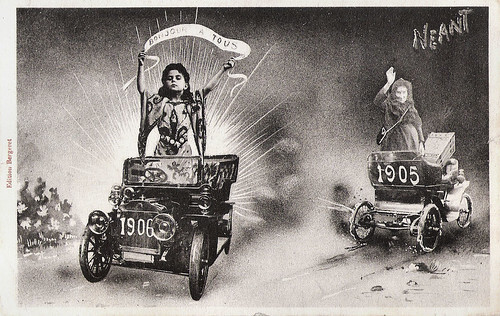
French postcard by Edition Bergeret.
Pathé and Gaumont in 1905
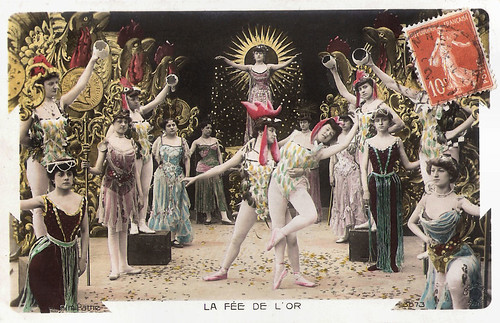
French postcard by Croissant, Paris, no. 3573. Photo: Film Pathé. This is the final scene from La poule aux oeufs d'or / The Goose that Laid the Golden Eggs (Gaston Velle, 1905). Caption: The gold fairy.
La poule aux oeufs d'or /The Goose that Laid the Golden Eggs (Gaston Velle, 1905) was adapted from the fable of Jean de la Fontaine. The cinematography and special effects were done by Segundo de Chomón. A poor farmer wins a chicken in the lottery at the fairground. The chicken is an enchanted animal (doing a chicken dance with the other chicken girls), laying big eggs full of money. Thieves whom we already saw 'working' at the fairground, steal rabbits from the farmer. The farmer turns into a rich man, but his wealth is short-lived. The thieves steal an egg, but a bat flies out of it. Another egg contains a devil spitting gold, and it explodes. At night, the thieves witness how the farmer takes an egg to a secret cellar where he cherishes all his gold, despite nightmare visions of staring eyes and grabbing arms. After the thieves have stolen the money, the creditors appear. Desperately, and inspired by a devil, the man slaughters the chicken. He finds a last egg, but an evil witch comes out of it, who sends him to a fairyland. There, the man is led away, after which an apotheosis follows with a dance of chicken girls and fairies, emptying eggs with gold coins.
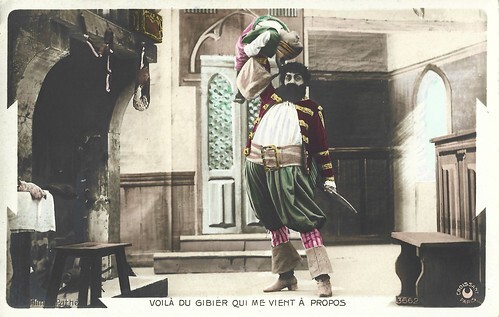
French postcard by Croissant, Paris, no. 3662. Photo: Film Pathé. Scene from Le Petit Poucet / Hop o'my Thumb (1905). Caption: Here's a game that comes in handy.
Le Petit Poucet / Hop o'my Thumb (1905) was an adaptation of Charles Perrault's famous story of 1697. The film by Pathé was worldwide released, in Spanish-speaking countries as Pulgarito, and in the US as Hop o'my Thumb. The director and actors are unknown. The Spanish film scholar Juan-Gabriel Tharrats claimed the Spanish trick filmmaker Segundo De Chomón (1871-1929), who worked for Pathé in those years, made Le Petit Poucet. French Wikipedia claims the director was Vincent Lorant-Heilbronn. The Fondation Jerôme Seydoux-Pathé, keeper of the Pathé heritage, lists no director at all. The doubt about De Chomón as director is confirmed in the recent volume 'Les mille et un visages de Segundo De Chomón' (2019).
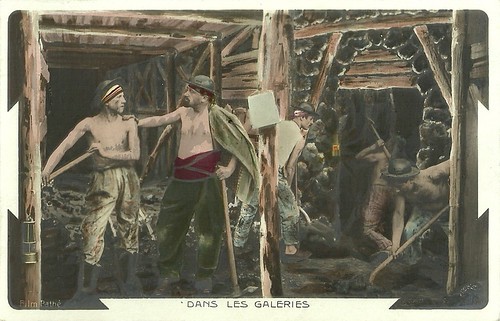
French postcard by Croissant, Paris. Photo: Film Pathé. Scene from Au pays noir / Tragedy in a Coal Mine (Ferdinand Zecca or Lucien Nonguet, 1905). Caption: In the mine galleries. This refers to the 5th scene of the film.
Au pays noir / Tragedy in a Coal Mine (Ferdinand Zecca or Lucien Nonguet, 1905) narrates the life of the miner: his life at home, going to work, gathering at the pit and descending, having a break. But then an explosion takes place and water crushes the beams that uphold the galleries, killing the miners. A few manage to escape and withdraw to a higher gallery where the water can reach them only to their middle. They hear their liberators, who finally free them. Outside, gendarmes try to hold the crowd, who, frightened, see the rescuers bringing dead bodies one by one to the ground. When the foreman's dead son is brought to earth, his father explodes with grief and clenches his fist against the murderous mine. The film was partly inspired by Emile Zola 's novel, the popular workman's drama 'Germinal' (1885). Ferdinand Zecca had already filmed Germinal in 1903. It is unclear whether Zecca or Lucien Nonguet directed Au pays noir. In 1906, a year after the film, the worst mine disaster of Europe occurred in Courrières, France, when on 10 May 1906, a coal dust explosion killed almost 1100 mine workers.
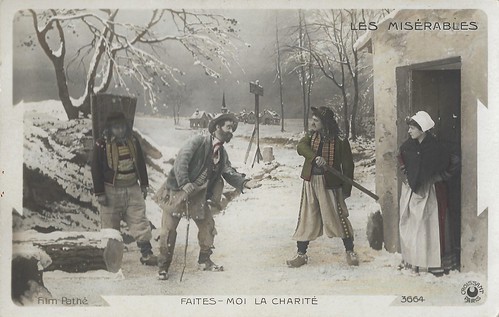
French postcard by Croissant, Paris, no. 3664. Photo: Film Pathé. Scene from Le chemineau / The Tramp (Albert Capellani, 1905). Caption: Give me some charity.
Le chemineau / The Tramp (Albert Capellani, 1905) is based on the first part of Victor Hugo 's novel 'Les misérables'. An exhausted tramp in vain asks for alimony from passers-by. He presents himself at the presbyterium and is hosted by the pastor, who lets him dine at his table and sleep in his bed, sleeping himself in his chair. At night, the tramp sees golden objects that serve as a mass in a cupboard in the bedroom. He sticks them in his bag and secretly sneaks away, trying not to awaken the pastor. Arrested at a jeweller, to whom he tries to sell his loot, the gendarmes bring him back to the pastor. Despite all, the pastor wants to exonerate the miserable man's soul and tells a lie to the gendarmes: I gave the objects myself to him. The thief repents. Unclear is who the actors are, but the sets were designed by Hugues Laurent. The film appeared in the 'Scènes dramatiques et réalistes (8ème Série)' by Pathé.
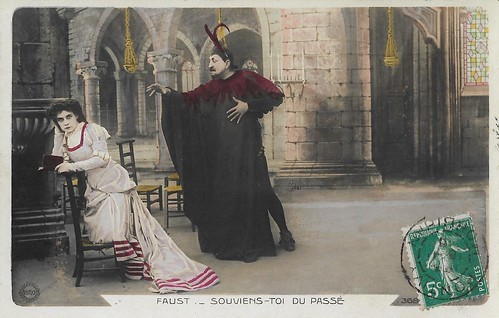
French postcard by Croissant, Paris, no. 3680. Photo: Gaumont. Scene from Faust (Alice Guy, ca. 1905). Caption: Remember the past.
Postcard for the phonoscène Gaumont Faust by Alice Guy. The earliest proof of a showing of the film dates from 1905, so the film was produced that year or just before. The captions on the cards refer to lines from the opera libretto by Jules Barbier and Michel Carré for the opera 'Faust' (1859) by Charles Gounod. This card refers to no. 21 of the Fourth Act. The film is not to be confused with Faust et Méphistophéles (1903), also made by Alice Guy , which is another film.
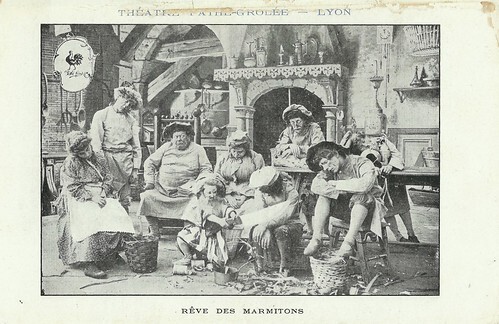
French postcard by Pathé Frères for Théâtre Pathé Grolée, Lyon. Photo: Film Pathé. Scene from Rêve des marmitons / The Dream of the Kitchen Staff (Segundo de Chomón, 1905).
In the kitchen of a medieval castle, cooks and kitchen hands fall asleep. In Rêve des marmitons / The Dream of the Kitchen Staff (Segundo de Chomón, 1905), we see mysterious hands which, with the help of big knives, are separated from arms, start to cut the cabbages, carrots and other vegetables. Other hands chalk the menu on a blackboard. Director Segundo de Chomón also created the special effects in this short fantasy.
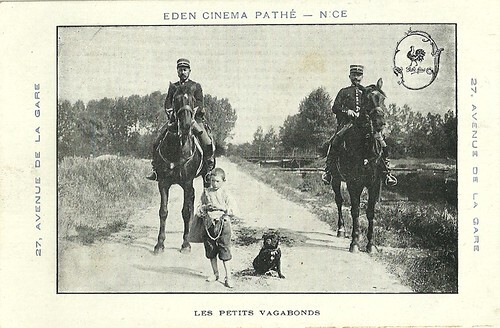
French postcard by Pathé Frères for Eden Cinema Pathé, Nice. Photo: Film Pathé. Scene from Les petits vagabonds / Young Tramps (Lucien Nonguet, 1905).
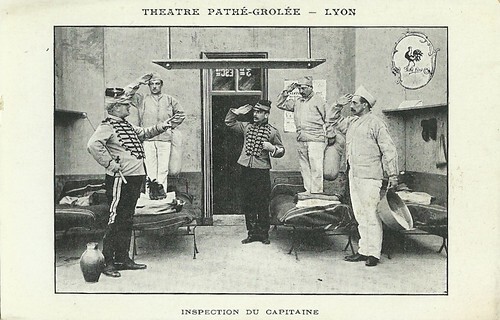
French postcard by Pathé Frères for Théâtre Pathé Grolée, Lyon. Photo: Film Pathé. Scene from L'inspection du capitaine / The Captain's Inspection (N.N., 1905).
After inspection, the soldiers lie down for a well-earned nap. A drunkard enters the room and disturbs the soldiers, who throw him out. He keeps coming back, and they finally decide to throw water on him, but the captain gets the shower.
5 stage postcards from 1905
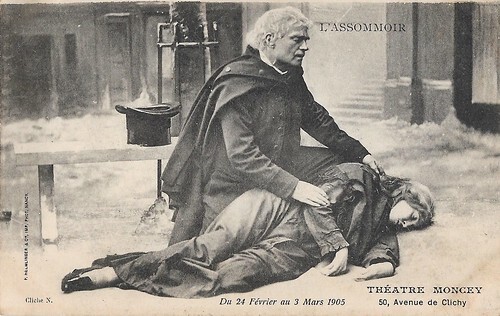
French postcard by P. Helmlinger & Co., Nancy, for Théâtre Moncey in Paris, where the stage production 'L'Assommoir' was presented from 24 February - 3 March 1905. Photo: Nadar. Caption: The death of Gervaise (Hélène Petit).
In 1879, two years after its publication, Emile Zola 's novel 'L'Assommoir'(The Assumption) was adapted for the stage by William Busnach and Octave Gastineau, with the help of Zola. The premiere took place on 18 January 1879 and was a great success. Afterwards, the play was often re-staged, in and outside of France. From 24 February 1905, the play was staged at the Parisian Théâtre Moncey, 50, Avenue de Clichy. The journal La Presse of 26 February 1905 lauded the play and the performances, in the first place by M. Pouctal as Coupeau and Gabrielle Fleury as Gervaise. Yet, this card and all the other ones in the Helmlinger series show a photo from the original 1879 stage adaptation, starring Hélène Petit as Gervaise and Gil Naza as Coupeau. The original photos were made by Nadar.
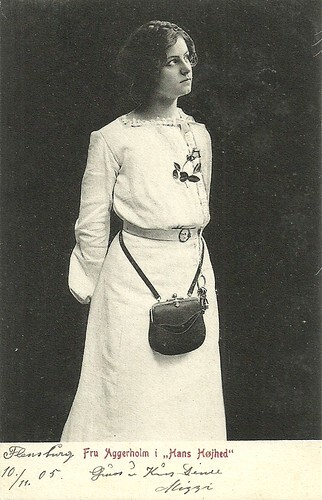
Danish postcard by Alex. Vincent's Kunstforlag, Neret, no. 1022. Ellen Aggerholm as Käthi in the stage play 'Hans Højhed / His Highness', mailed Flensburg, 10-11-1905. Her partner in the play, playing the Highness of the title, was her husband Svend Aggerholm.
Ellen Aggerholm (1882-1963) was a Danish stage and screen actress, who had many leading parts at the Danish film company Nordisk in the 1910s.
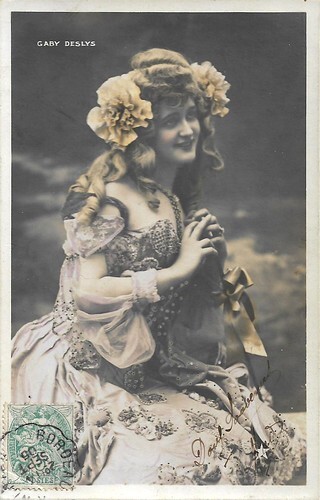
French postcard by Ed Etoile, Paris (G. Piprot), Series N. 867 - Th. 119. Posted 1905.
French dancer and actress Gaby Deslys (1881-1920) was an internationally celebrated - and notorious - star of the early 20th Century. She was famous for her extravagant clothes, jewels and millinery. She had many admirers, most notably King Manuel II of Portugal, and during World War I she reportedly worked as a spy for the French government. Before her tragic early death she also made a series of silent films.
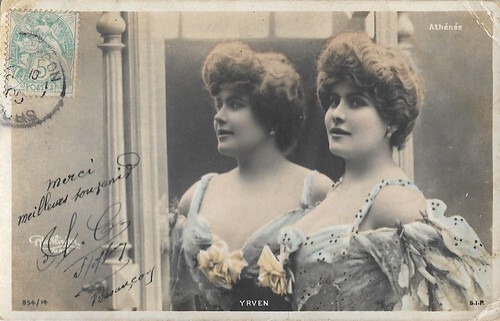
French postcard by S.I.P., no. 854-14. Photo: Reutlinger, Paris. Caption: (Théâtre de l') Athénée. Sent by mail in Besançon in 1905.
Marthe Marie Aglaé Wary, known as Marcelle Yrven or simply Yrven (1877-1954), was a French stage and screen actress and operetta singer.
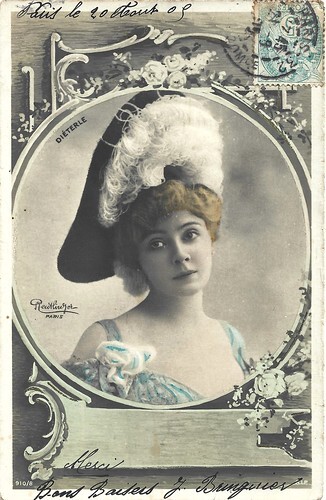
French postcard by S.I.P., no. 910, series 8. Photo: Reutlinger, Paris. The card was mailed in 1905.
Amélie Diéterle (1871-1941) was one the most beloved actresses and singers of the Belle Epoque, who inspired poets and painters such as Mallarmé and Rodin. Between 1909 and 1913 she acted in some 25 shorts films at Pathé Frères, mostly Rigadin comedies directed by Georges Monca.
Exposition Universelle Liege (1905)
Finally, Ivo selected 3 cards from the 1905 Liege World Fair in Belgium, which took place between 27 April and 6 November 1905. On one of the cards, you can see Wagons-Lits wagons. Film pioneer Jean Desmet is said to have exhibited his fancy new saloon car at the Liege Exhibition at the time. On another card, you can see the Panorama Building, where, among other things, a panorama of the Russo-Japanese War of 1905 was displayed. Very topical, then. Pathé and other firms re-enacted the war in their films. The Liège World Fair occupied a territory of 70 square meters, offered room for 29 countries, and had 7 million visitors. People could travel with a specially arranged railway along the pavilions and stands. Typical for its time, part of the French pavilion was a reconstructed Senegalese village, where Africans would dive for pennies thrown in by visitors. As was common at these fairs in the early 20th century, part of the old city centre of Liège was rebuilt, with the cathedral and a model of a coal mine. The Palais des Beaux-Arts, built in the Parc de Boverie for the art exhibition at the World Fair, became an art museum after the Fair, and reopened in 2016 as La Boverie. The Fair also marked the 75 years of Belgium's independence and the 40-year reign of King Leopold II.
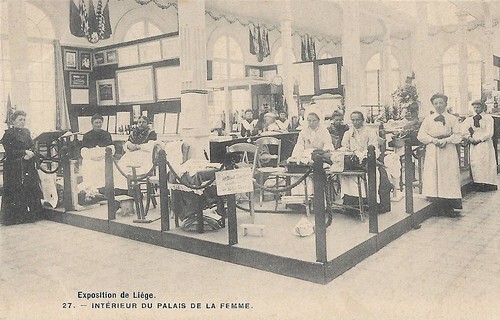
Belgian postcard for the Exposition Universelle (World Fair) at Liège/Luik, no. 27. Caption: Intérieur du Palais de la Femme. Local women dressed in folkloristic costumes show old handicrafts like lacemaking. The exhibition of humans at World Fairs was quite common in the early 1900s.

Belgian postcard for the Exposition Universelle (World Fair) at Liège/Luik, no 37. Vaption: Les aéroplanes Maxim. Fairs often had fairground attractions too, such as the airplanes here. To the right, the large Panorama building is visible, as well as the Moresque minaret. The name Wijnand / Wynand Fockink refers to one of the oldest - and still running - Amsterdam jenever distillers. The Liège World Fair also had a water chute, an attraction often included in World Fairs.
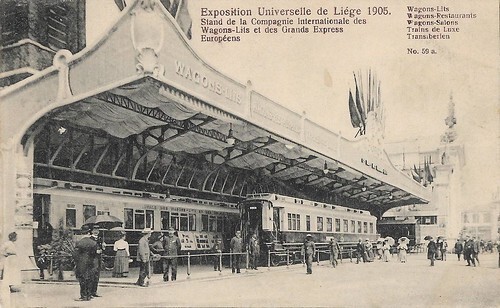
Belgian postcard for the Exposition Universelle (World Fair) at Liège/Luik, no. 59a. Stand of the Compagnie Internationale des Wagons-Lits et des Grands Express Européens. The coaches also include so-called Wagons-Salons. To receive all the international and national visitors, a new train station was built in Liège, la Gare du Palais, which was destroyed in 1979 to make way for a new underground train station.

French postcard by Edition Bergeret.
Pathé and Gaumont in 1905

French postcard by Croissant, Paris, no. 3573. Photo: Film Pathé. This is the final scene from La poule aux oeufs d'or / The Goose that Laid the Golden Eggs (Gaston Velle, 1905). Caption: The gold fairy.
La poule aux oeufs d'or /The Goose that Laid the Golden Eggs (Gaston Velle, 1905) was adapted from the fable of Jean de la Fontaine. The cinematography and special effects were done by Segundo de Chomón. A poor farmer wins a chicken in the lottery at the fairground. The chicken is an enchanted animal (doing a chicken dance with the other chicken girls), laying big eggs full of money. Thieves whom we already saw 'working' at the fairground, steal rabbits from the farmer. The farmer turns into a rich man, but his wealth is short-lived. The thieves steal an egg, but a bat flies out of it. Another egg contains a devil spitting gold, and it explodes. At night, the thieves witness how the farmer takes an egg to a secret cellar where he cherishes all his gold, despite nightmare visions of staring eyes and grabbing arms. After the thieves have stolen the money, the creditors appear. Desperately, and inspired by a devil, the man slaughters the chicken. He finds a last egg, but an evil witch comes out of it, who sends him to a fairyland. There, the man is led away, after which an apotheosis follows with a dance of chicken girls and fairies, emptying eggs with gold coins.

French postcard by Croissant, Paris, no. 3662. Photo: Film Pathé. Scene from Le Petit Poucet / Hop o'my Thumb (1905). Caption: Here's a game that comes in handy.
Le Petit Poucet / Hop o'my Thumb (1905) was an adaptation of Charles Perrault's famous story of 1697. The film by Pathé was worldwide released, in Spanish-speaking countries as Pulgarito, and in the US as Hop o'my Thumb. The director and actors are unknown. The Spanish film scholar Juan-Gabriel Tharrats claimed the Spanish trick filmmaker Segundo De Chomón (1871-1929), who worked for Pathé in those years, made Le Petit Poucet. French Wikipedia claims the director was Vincent Lorant-Heilbronn. The Fondation Jerôme Seydoux-Pathé, keeper of the Pathé heritage, lists no director at all. The doubt about De Chomón as director is confirmed in the recent volume 'Les mille et un visages de Segundo De Chomón' (2019).

French postcard by Croissant, Paris. Photo: Film Pathé. Scene from Au pays noir / Tragedy in a Coal Mine (Ferdinand Zecca or Lucien Nonguet, 1905). Caption: In the mine galleries. This refers to the 5th scene of the film.
Au pays noir / Tragedy in a Coal Mine (Ferdinand Zecca or Lucien Nonguet, 1905) narrates the life of the miner: his life at home, going to work, gathering at the pit and descending, having a break. But then an explosion takes place and water crushes the beams that uphold the galleries, killing the miners. A few manage to escape and withdraw to a higher gallery where the water can reach them only to their middle. They hear their liberators, who finally free them. Outside, gendarmes try to hold the crowd, who, frightened, see the rescuers bringing dead bodies one by one to the ground. When the foreman's dead son is brought to earth, his father explodes with grief and clenches his fist against the murderous mine. The film was partly inspired by Emile Zola 's novel, the popular workman's drama 'Germinal' (1885). Ferdinand Zecca had already filmed Germinal in 1903. It is unclear whether Zecca or Lucien Nonguet directed Au pays noir. In 1906, a year after the film, the worst mine disaster of Europe occurred in Courrières, France, when on 10 May 1906, a coal dust explosion killed almost 1100 mine workers.

French postcard by Croissant, Paris, no. 3664. Photo: Film Pathé. Scene from Le chemineau / The Tramp (Albert Capellani, 1905). Caption: Give me some charity.
Le chemineau / The Tramp (Albert Capellani, 1905) is based on the first part of Victor Hugo 's novel 'Les misérables'. An exhausted tramp in vain asks for alimony from passers-by. He presents himself at the presbyterium and is hosted by the pastor, who lets him dine at his table and sleep in his bed, sleeping himself in his chair. At night, the tramp sees golden objects that serve as a mass in a cupboard in the bedroom. He sticks them in his bag and secretly sneaks away, trying not to awaken the pastor. Arrested at a jeweller, to whom he tries to sell his loot, the gendarmes bring him back to the pastor. Despite all, the pastor wants to exonerate the miserable man's soul and tells a lie to the gendarmes: I gave the objects myself to him. The thief repents. Unclear is who the actors are, but the sets were designed by Hugues Laurent. The film appeared in the 'Scènes dramatiques et réalistes (8ème Série)' by Pathé.

French postcard by Croissant, Paris, no. 3680. Photo: Gaumont. Scene from Faust (Alice Guy, ca. 1905). Caption: Remember the past.
Postcard for the phonoscène Gaumont Faust by Alice Guy. The earliest proof of a showing of the film dates from 1905, so the film was produced that year or just before. The captions on the cards refer to lines from the opera libretto by Jules Barbier and Michel Carré for the opera 'Faust' (1859) by Charles Gounod. This card refers to no. 21 of the Fourth Act. The film is not to be confused with Faust et Méphistophéles (1903), also made by Alice Guy , which is another film.

French postcard by Pathé Frères for Théâtre Pathé Grolée, Lyon. Photo: Film Pathé. Scene from Rêve des marmitons / The Dream of the Kitchen Staff (Segundo de Chomón, 1905).
In the kitchen of a medieval castle, cooks and kitchen hands fall asleep. In Rêve des marmitons / The Dream of the Kitchen Staff (Segundo de Chomón, 1905), we see mysterious hands which, with the help of big knives, are separated from arms, start to cut the cabbages, carrots and other vegetables. Other hands chalk the menu on a blackboard. Director Segundo de Chomón also created the special effects in this short fantasy.

French postcard by Pathé Frères for Eden Cinema Pathé, Nice. Photo: Film Pathé. Scene from Les petits vagabonds / Young Tramps (Lucien Nonguet, 1905).

French postcard by Pathé Frères for Théâtre Pathé Grolée, Lyon. Photo: Film Pathé. Scene from L'inspection du capitaine / The Captain's Inspection (N.N., 1905).
After inspection, the soldiers lie down for a well-earned nap. A drunkard enters the room and disturbs the soldiers, who throw him out. He keeps coming back, and they finally decide to throw water on him, but the captain gets the shower.
5 stage postcards from 1905

French postcard by P. Helmlinger & Co., Nancy, for Théâtre Moncey in Paris, where the stage production 'L'Assommoir' was presented from 24 February - 3 March 1905. Photo: Nadar. Caption: The death of Gervaise (Hélène Petit).
In 1879, two years after its publication, Emile Zola 's novel 'L'Assommoir'(The Assumption) was adapted for the stage by William Busnach and Octave Gastineau, with the help of Zola. The premiere took place on 18 January 1879 and was a great success. Afterwards, the play was often re-staged, in and outside of France. From 24 February 1905, the play was staged at the Parisian Théâtre Moncey, 50, Avenue de Clichy. The journal La Presse of 26 February 1905 lauded the play and the performances, in the first place by M. Pouctal as Coupeau and Gabrielle Fleury as Gervaise. Yet, this card and all the other ones in the Helmlinger series show a photo from the original 1879 stage adaptation, starring Hélène Petit as Gervaise and Gil Naza as Coupeau. The original photos were made by Nadar.

Danish postcard by Alex. Vincent's Kunstforlag, Neret, no. 1022. Ellen Aggerholm as Käthi in the stage play 'Hans Højhed / His Highness', mailed Flensburg, 10-11-1905. Her partner in the play, playing the Highness of the title, was her husband Svend Aggerholm.
Ellen Aggerholm (1882-1963) was a Danish stage and screen actress, who had many leading parts at the Danish film company Nordisk in the 1910s.

French postcard by Ed Etoile, Paris (G. Piprot), Series N. 867 - Th. 119. Posted 1905.
French dancer and actress Gaby Deslys (1881-1920) was an internationally celebrated - and notorious - star of the early 20th Century. She was famous for her extravagant clothes, jewels and millinery. She had many admirers, most notably King Manuel II of Portugal, and during World War I she reportedly worked as a spy for the French government. Before her tragic early death she also made a series of silent films.

French postcard by S.I.P., no. 854-14. Photo: Reutlinger, Paris. Caption: (Théâtre de l') Athénée. Sent by mail in Besançon in 1905.
Marthe Marie Aglaé Wary, known as Marcelle Yrven or simply Yrven (1877-1954), was a French stage and screen actress and operetta singer.

French postcard by S.I.P., no. 910, series 8. Photo: Reutlinger, Paris. The card was mailed in 1905.
Amélie Diéterle (1871-1941) was one the most beloved actresses and singers of the Belle Epoque, who inspired poets and painters such as Mallarmé and Rodin. Between 1909 and 1913 she acted in some 25 shorts films at Pathé Frères, mostly Rigadin comedies directed by Georges Monca.
Exposition Universelle Liege (1905)
Finally, Ivo selected 3 cards from the 1905 Liege World Fair in Belgium, which took place between 27 April and 6 November 1905. On one of the cards, you can see Wagons-Lits wagons. Film pioneer Jean Desmet is said to have exhibited his fancy new saloon car at the Liege Exhibition at the time. On another card, you can see the Panorama Building, where, among other things, a panorama of the Russo-Japanese War of 1905 was displayed. Very topical, then. Pathé and other firms re-enacted the war in their films. The Liège World Fair occupied a territory of 70 square meters, offered room for 29 countries, and had 7 million visitors. People could travel with a specially arranged railway along the pavilions and stands. Typical for its time, part of the French pavilion was a reconstructed Senegalese village, where Africans would dive for pennies thrown in by visitors. As was common at these fairs in the early 20th century, part of the old city centre of Liège was rebuilt, with the cathedral and a model of a coal mine. The Palais des Beaux-Arts, built in the Parc de Boverie for the art exhibition at the World Fair, became an art museum after the Fair, and reopened in 2016 as La Boverie. The Fair also marked the 75 years of Belgium's independence and the 40-year reign of King Leopold II.

Belgian postcard for the Exposition Universelle (World Fair) at Liège/Luik, no. 27. Caption: Intérieur du Palais de la Femme. Local women dressed in folkloristic costumes show old handicrafts like lacemaking. The exhibition of humans at World Fairs was quite common in the early 1900s.

Belgian postcard for the Exposition Universelle (World Fair) at Liège/Luik, no 37. Vaption: Les aéroplanes Maxim. Fairs often had fairground attractions too, such as the airplanes here. To the right, the large Panorama building is visible, as well as the Moresque minaret. The name Wijnand / Wynand Fockink refers to one of the oldest - and still running - Amsterdam jenever distillers. The Liège World Fair also had a water chute, an attraction often included in World Fairs.

Belgian postcard for the Exposition Universelle (World Fair) at Liège/Luik, no. 59a. Stand of the Compagnie Internationale des Wagons-Lits et des Grands Express Européens. The coaches also include so-called Wagons-Salons. To receive all the international and national visitors, a new train station was built in Liège, la Gare du Palais, which was destroyed in 1979 to make way for a new underground train station.
Published on June 21, 2025 22:00
Paul van Yperen's Blog
- Paul van Yperen's profile
- 13 followers
Paul van Yperen isn't a Goodreads Author
(yet),
but they
do have a blog,
so here are some recent posts imported from
their feed.



